ECG EWTI 71120 Bruksanvisning
ECG
tvättmaskin
EWTI 71120
Läs gratis den bruksanvisning för ECG EWTI 71120 (100 sidor) i kategorin tvättmaskin. Guiden har ansetts hjälpsam av 24 personer och har ett genomsnittsbetyg på 4.3 stjärnor baserat på 12.5 recensioner. Har du en fråga om ECG EWTI 71120 eller vill du ställa frågor till andra användare av produkten? Ställ en fråga
Sida 1/100

EWT 70120
EWTI 71120
English
Deutsch
Čeština
Magyar
Slovenčina
Always read the safety&use instructions carefully before using your appliance for the rst time. The user´smanual must be always included. Bitte lesen Sie vor der Inbetriebnahme des Produktes diese Anleitung und
die darin enthaltenen Sicherheitshinweise aufmerksam durch. Die Bedienungsanleitung muss dem Gerät immer beigelegt sein. Před uvedením výrobku do provozu si důkladně pročtěte tento návod abezpečnostní
pokyny, které jsou v tomto návodu obsaženy. Návod musí být vždy přiložen kpřístroji. Atermék használatba vétele előtt gyelmesen olvassa el ezt ahasználati útmutatót és az útmutatóban található biztonsági
rendelkezéseket. Ahasználati útmutatót tartsa akészülék közelében. Pred uvedením výrobku do prevádzky si dôkladne prečítajte tento návod abezpečnostné pokyny, ktoré sú vtomto návode obsiahnuté. Návod
musí byť vždy priložený kprístroju.
TOP-LOADING WASHING MACHINE
INSTRUCTION MANUAL
FELSŐ TÖLTÉSŰ MOSÓGÉP
HASZNÁLATI ÚTMUTATÓ
TOPLADER-WASCHMASCHINE
BEDIENUNGSANLEITUNG
PRÁČKA S VRCHNÝM PLNENÍM
NÁVOD NA OBSLUHU
PRAČKA S VRCHNÍM PLNĚNÍM
NÁVOD KOBSLUZE


English
English
3
TOP-LOADING WASHING MACHINE
SAFETY INSTRUCTIONS
Read carefully and save for future use!
Warning: The safety measures and instructions, contained in this
manual, do not include all conditions and situations possible. The user
must understand that common sense, caution and care are factors
that cannot be integrated into any product. Therefore, these factors
shall be ensured by the user/s using and operating this appliance. We
are not liable for damages caused during shipping, by incorrect use,
voltage uctuation or the modication or adjustment of any part of
the appliance.
Follow the instructions in this manual. Before using for the rst time,
read the entire written instructions carefully and keep them for future
reference.
To protect against a risk of re or electric shock, basic precautions shall
be taken while using electrical appliances, including the following:
1. Make sure that the voltage in your outlet corresponds to the voltage
indicated on the type plate of your appliance. To ensure your
safety, insert the plug of the power cord into a properly grounded
three-prong socket installed in accordance with the applicable
Czech Technical Standard in accordance with the manufacturer's
instructions and local safety regulations.
2. Do not operate the device if the cord is damaged. Entrust the
connection of the appliance to the power supply and the water
connection, any repairs or adjustments, including the replacement
of the power cable, to an authorized service center! Do not remove
the protective covers from the appliance; there is a risk of electric
shock!
3. Defective parts may only be replaced with original spare parts. Only
these parts are guaranteed by the manufacturer to fully meet safety
requirements.
4. There must always be access to a power socket so that the washing
machine can be disconnected from the mains at any time.
TOP-LOADING WASHING MACHINE
English

English
English
4
TOP-LOADING WASHING MACHINE
5. Improperly performed repairs can expose the user to signicant
hazards for which the manufacturer is not liable.
6. Repairs may only be carried out by a qualied person and a
designated service provider.
7. In the event of a fault or during cleaning and maintenance, the
washing machine is only electrically disconnected from the mains
when:
- the mains plug of the washing machine is pulled out of the socket,
or
- the circuit breaker of the house electrical installation is switched
o, or
- the screw-in fuse for the house electrical system is completely
unscrewed.
8. Do not plug and unplug the power cord from the outlet using wet
hands. You will avoid risk of electric shock.
9. Do not touch the appliance with wet hands or feet.
10. The power cord must remain accessible once the device is installed.
Do not shorten the cable or use a power strip or extension cord. The
power supply must not touch hot parts or lead over sharp edges
(risk of re due to overheating).
11. Do not turn the device on or o by plugging or unplugging the
power cord. Do not remove the power cord from the outlet by
yanking the cord. Unplug the power cord from the outlet by grasping
the plug. After use, always switch o with the rotary selector to the
OFF position, disconnect the appliance from the power supply and
close the water supply.
12. Do not place the machine on carpets or similar surface that could
block the ventilation openings in the base.
13. Do not insert any objects into the device or place any objects on
the device (e.g. vases, cups, etc.).
14. Do not place the drain hose of your machine in the sink, buckets or
basins.
15. Do not allow children to play with the appliance. Protect access to
the machine from children and animals. Children under the age

English
English
5
of 3 should be denied access unless they are under constant
supervision.
16. Keep away from children the small parts supplied in the bag with
documentation.
17. Do not expose the appliance to direct sunlight, do not use it outside,
and do not expose it to rain.
18. Do not keep ammable liquids close to the appliance.
19. Do not wash items that have been cleaned, washed, soaked or
stained with ammable or explosive substances (wax, oil, paint,
petrol, degreasers, chemical solvents, kerosene, etc.) in the washing
machine. The use of highly ammable and explosive or toxic solvents
is prohibited. Do not use gasoline, alcohol, etc. as detergent. There
might be a re or explosion. Carpet washing is prohibited.
20. Do not touch the washing machine with wet hands when in
operation. Never open the detergent drawer or the washing
machine door during washing and spinning.
21. Be careful when opening the door after using the steam function.
There is a risk of burns from the steam and high temperatures on
the surface of the drum and on the glass door. Take a step back and
wait for the steam to dissipate.
22. During discharge, do not touch the drain hose and the discharged
water. Water may reach high temperatures during the operation of
the washing machine. There is a risk of burns.
23. In case of malfunction rst unplug it from power and then close the
water tap. Do not try to repair the appliance by yourself, contact an
authorized service center.
24. Before using it for the rst time, do not forget to REMOVE THE
LOCKING SCREWS which are securing the washing machine drum
during transportation. Damage cause by starting the washing
machine with installed locking screws is not covered by the
warranty.
25. The appliance is intended exclusively for domestic use and for
washing only textile materials. In the event of commercial use or
use not in accordance with this manual, the warranty becomes void.

English
English
6
26. This washing machine is intended for indoor use only.
27. Do not install the appliance in wet or damp rooms, as well as in
rooms where appear explosive or corrosive gases.
28. This appliance is intended for use by children 8 years of age and
older and persons with reduced physical or mental abilities or lack of
experience and knowledge, provided they are under supervision or
given instructions concerning use of the appliance in a safe manner
and understand the potential hazards. Cleaning and maintenance
by the user must not be done by children unless they are older than
8 years old and under supervision. Children under the age of 8 must
keep away from the appliance and the power supply.
29. Any intervention in the appliance by a person other than an
authorized service provider results in loss of warranty.
30. The warranty does not cover damage caused by outside eects
(ood, chemicals, re, etc.).
31. The manufacturer is not liable for any damage caused by improper
grounding/use. DANGEROUS VOLTAGE, RISK OF INJURY!
RECOMMENDATION
• Before using your new washing machine, ask for help with the installation and putting in operation a
qualied plumber or an authorized service center.
• Install the washing machine in a well ventilated area with adequate air circulation. Place the appliance so
that it can fully open the washing machine door. The washing machine is not intended as a built-in or for
integration into furniture sets.
• The ideal ambient temperature for the washing machine operation is 15 °C to 25 °C.
• Frozen hoses can rot and break. In areas where the temperature drops below freezing, the temperature
may jeopardize the safe operation of electronic circuits.
• We recommend that the rst washing cycle be undergone without laundry for „90° white cotton“ so that
you pour in the second compartment of the detergent drawer ½ measuring cup of detergent.
• Since long term contact with air can lead to deposition of detergent or fabric softener, pour the detergent
and fabric softener into the compartment until just before the intended wash.
• We recommend using the prewash program only for heavily soiled laundry.
• The amount of laundry loaded into the washing machine must not exceed the maximum permitted
amount. Otherwise, the washing machine will run in the safe mode.
• Use the washing machine only for laundry that is labelled by the manufacturer as suitable for machine
washing.
• When using fabric softener and similar products in your machine, follow the manufacturer's
recommendations for detergent/fabric softener.
• Make sure that there are no foreign objects in the pockets of the laundry pieces put in the washing
machine (nails, needles, coins, lighters, matches, clips, etc). These foreign objects could damage the
washing machine.
• Washing very dusty clothing damages your washing machine. Shake heavily dusty clothing before placing
it in the washing machine.

English
English
7
• Never open the detergent drawer while the machine is running.
• Never force open the door of the washing machine while it is running.
• Before opening the door, make sure that no water remains in the drum. Do not open the washing machine
door if you see water.
• At the end of the program, wait at least 2 minutes and then open the door.
• Sulphur in decolourants may cause corrosion. Therefore never use decolourants in the washing machine.
Never use substances containing solvents (e.g. benzine) in the washing machine.
• If you are not using the washing machine for longer time, unplug it, close the water supply and leave the
door open. The interior of your machine will stay dry and free of odours.
• After testing at the end of the manufacturing process in the machine might remain a small amount of
water, which does not constitute a risk of damage to your machine.
Danger of ooding
• Use a new set of hoses included with the appliance.
• Do not reuse the old hoses set.
• Always disconnect the appliance from the power supply and turn o the water supply after use.
• Do not place the drain hose of your machine in the sink, buckets or basins.
Danger of fall or injury
• Do not step or sit on the washing machine. The top plate could break and you could injure yourself.
• Do not lean on the door. Do not force it closed. If it is dicult to close the door, make sure that there are
not too many clothes in the washing machine or that they are well distributed.
• Arrange safely the hoses and power cable after installation. Trip and fall could cause injuries.
• Do not turn the washing machine upside down or on its side.
• Do not lift the washing machine by its protruding parts (detergent drawer, door). They could be damaged
and cause injury.
• Handling the washing machine requires cooperation of at least two people.
Children’s safety
• Children under the age of 3 should be denied access unless they are under constant supervision. Do not
leave children without supervision close to the washing machine. Children could lock themselves inside
the washing machine with fatal consequences.
• During the operation the glass door and the washing machine surfaces can be very hot. Protect small
children and animals from contact with these surfaces.
• Keep the packaging materials away from the children. There is a risk of suocation
• Swallowing detergents may cause poisoning and contact with skin or eyes may cause irritation. Keep
detergents away from the children.

English
English
8
PRODUCT DESCRIPTION
Door
Detergent dispenser
Drum
Service lter
Power cord
Control panel
Drain hose
Note: The product description is for reference only, please refer to the actual product as standard.
Accessories
• Hole plugs for transport screws (4 pcs)
• Cold water supply hose
• Operating manual
INSTALLATION
Place of installation
Warning:
• Ensure that the installation site is stable.
• Make sure that the product is not standing on the power cord.
Only install the appliance in a location that meets the following conditions:
• Firm, dry and even surface.
• Away from sunlight.
• Adequate ventilation.
• Room temperature higher than 5 °C.
• At a sucient distance from heat sources such as stoves, cookers, etc.
Unpacking the washing machine
Warning:
• Packaging material (e.g. foil, polystyrene) can be dangerous for children.
• There is a risk of suocation! Keep the packaging materials away from the children.

English
English
9
1. Remove the cardboard box and polystyrene wrapping.
2. Pull out the washing machine and remove the base packaging. Make sure the small foam triangle has been
removed together with the bottom one. If not, place the appliance side down and then manually remove
the small foam insert from the bottom of the appliance.
3. Remove the tape securing the power cable and the drain hose.
4. Remove the hose from the drum.
Shipping screws removal
Before starting the washing machine, remove the 4 shipping screws and rubber washers from the back of the
washing machine. If the screws are not removed, they can cause strong vibrations, noise and malfunction of
the washing machine and will void the warranty.
1. Loosen the shipping screws by turning them counterclockwise with a suitable wrench.
2. Remove the transport screws.
3. Insert the plastic plugs provided in the accessories bag into the holes left after removing the screws.
Shipping screws should be stored for future use.
Loosen the 4 transport screws with a spanner. Remove the screws including the rubber parts
and store them for future use.
Seal the holes with plugs.
Levelling the washing machine
Warning:
• The locking nuts on all four feet must be screwed rmly to the frame of the washing machine.
1. Loosen the lock nut.
2. Turn the foot until it reaches the oor.
3. Adjust the position of the feet and secure the nuts with a spanner.
Make sure the appliance is horizontal and stable.
Connecting the supply hose
Warning:
• To prevent leakage or water damage, carefully follow the instructions
in this chapter.
• Do not bend, squeeze or adjust the water supply
hose.
Connect the supply hose to the water inlet valve and to
the cold water tap, see illustration. Tighten the hose by
hand, do not use tools. Check that the connections are
tight.
Connecting water drain hose
Connect the drain hose to the sink outlet elbow. Never try to extend the
drain hose. Do not put the hose for draining water from the washing
machine into a container, bucket or bathtub. Make sure that the drain
hose is not bent, kinked, squashed or extended.
The drain hose must not be more than 100 cm from the ground.

English
English
10
USE
Quick start
Warning:
• Before washing, make sure the washing machine is installed correctly.
• Your appliance has been thoroughly checked before leaving the factory. To remove water residues and
neutralise any odours, we recommend cleaning the appliance before rst use. For this reason, run the
Cotton programme at 60 °C without laundry and detergent.
Before washing
1. Plug the washing machine into a socket.
2. Open the water tap.
3. Fill the washing machine with laundry.
4. Add detergent.
5. Close the drum door.
6. Close the machine door.
Note:
• For pre-wash machines, you need to add
detergent in section I, see the table in the
chapter "Detergent dispenser".
• Make sure that the drum aps are properly
secured.
• All metal hooks must be properly hung
inside the tailgate.
• Before each wash, check the drum to
make sure it is turning smoothly.
Washing
1. Select a program.
2. Select an additional function.
3. Start the wash.
Note:
• If you want to use the program by default,
you can skip step 2.
After the end of the programme
The display will show "End".
Before each washing
• The air temperature in the room where the washing machine is operated should be between 6 and 40 °C.
Use at temperatures below 0 °C may damage the inlet valve and drain system. If the appliance is placed
in a freezing environment, it should be brought to normal ambient temperature before use to ensure the
supply and drain hoses are thawed.
• Check the care labels and detergent instructions before washing. Use a non-foaming or less foaming
detergent suitable for machine washing.

English
English
11
Laundry preparation
Follow the instructions of the labels on the garment.
Divide the laundry according to type (cotton, synthetics, delicate, wool, etc.), washing temperature (cold, 30 °,
40 °, 60 °, 90 °) and degree of soiling (slightly soiled, soiled, heavily soiled).
Never wash coloured and white laundry together.
Dark fabrics may contain excess dye and should be washed separately several times.
Make sure there are no metal objects on the laundry or in the pockets; if so, remove them.
ATTENTION: The warranty does not cover malfunctions that occur due to damage by foreign material.
Close zippers, all hooks and eyelets.
Remove the metal or plastic hooks of the curtains or put them in a washing net or bag.
Turn fabrics such as pants, knits, T-shirts and sweatshirts inside out.
Wash socks, handkerchiefs and other small items in a protective net.
Clothing care symbols
Normal wash Maximum washing temperature is
90 °C
Maximum washing temperature is
60 °C
Maximum washing temperature is
30 °C
Manual washing
Washing prohibition
Can be bleached
No bleach
Maximum ironing temperature 110 °C
Maximum ironing temperature 150 °C Maximum ironing temperature 200 °C Do not iron
Can be dry cleaned
Dry cleaning prohibition
Unfold at

English
English
12
Hang when wet
Hang to dry Do not tumble dry
Can be cleaned with gasoline, alcohol,
and triuorotrichloroethane
Can be cleaned with benzene,
perchlorethylene
Can be cleaned with perchlorethylene,
R11, R113 and gasoline
NOTE: Be careful not to exceed the maximum load of the drum, as this would lead to poor washing results and
wrinkling of the laundry. Information on the capacity of the washing machine can be found in the table
of washing programs.
The following table shows the approximate weight of common types of laundry:
TYPE OF LAUNDRY WEIGHT (g)
Towel 200
Bed linen 500
Bathrobe 1,200
Blanket 700
Pillow case 200
Underwear 100
Tablecloth 250
Warning:
• Do not wash garments that have been cleaned, washed, soaked or coated with ammable or explosive
substances such as wax, oil, paint, gasoline, alcohol, kerosene and other ammable materials.
• Washing individual items of clothing can easily cause uneven loading of the drum and cause an error. It
is therefore recommended to add one or two more loads of laundry to the wash to ensure a smooth spin.
• Do not wash or wipe waterproof covers and clothing or mats or carpets.
Detergent dispenser
Prewash detergent
Main wash detergent
Fabric softener
Warning:
• Do not exceed the MAX mark when relling detergent or fabric
softener.
Programme Programme
Antiallergic
Centrifuging/discharging
Cotton
Washing/centrifuging
20 °C
Baby clothes
Mix
Sports
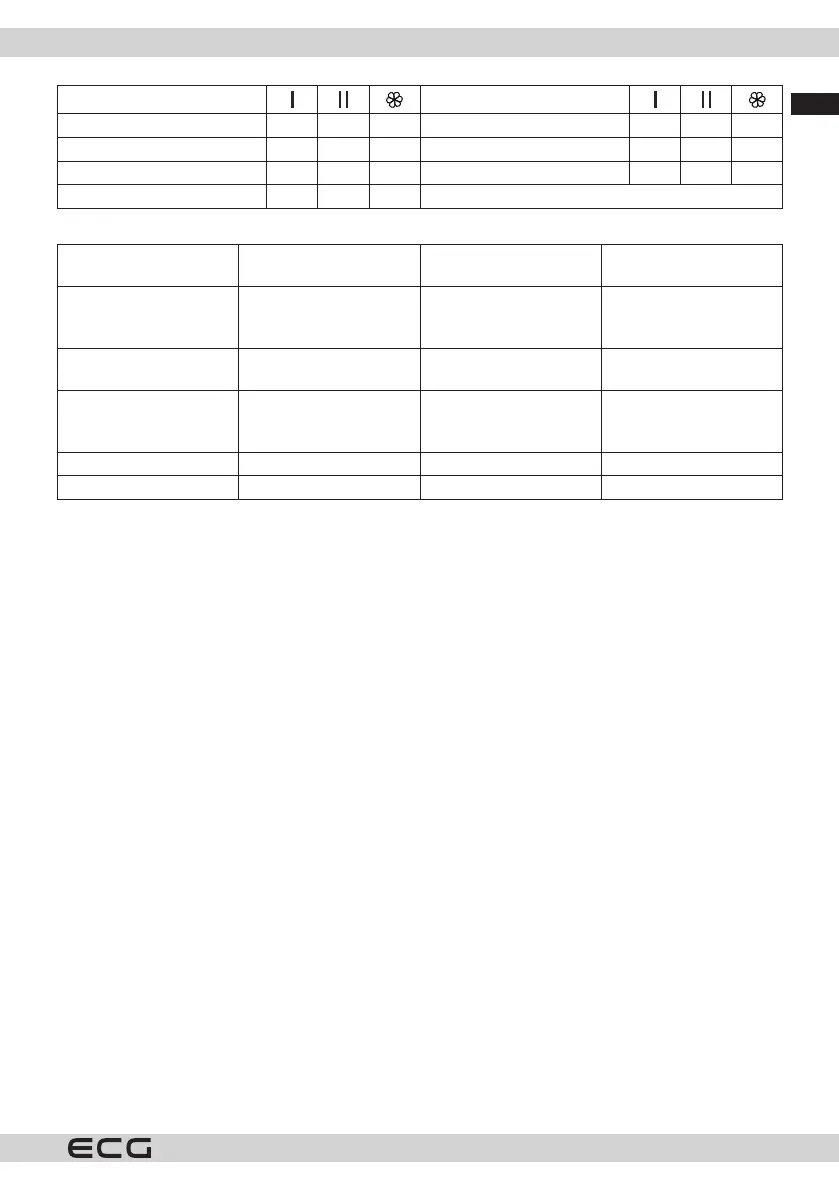
English
English
13
Programme Programme
Wool
Bedding
Synthetics
Quick 45'
ECO 40-60
Quick 15'
Drum cleaning
= mandatory; = optional
Detergent usage tips
Suitable detergent Washing programme Washing temperature Type of linen and
textiles
Strong detergent and
bleach.
Cotton, ECO 40-60, Mix 20/30/40/60 White linen made of
cotton or linen resistant
to boiling.
Detergent for coloured
laundry without bleach
Cotton, ECO 40-60, Mix Cold/20/30/40 Coloured linen made of
cotton or linen.
Gentle detergent for
coloured laundry without
bleach
Synthetics Cold/20/30/40 Coloured underwear
made of easy-care bres
or synthetic materials.
Soft detergent Synthetics 20/30 Fine fabrics, silk, viscose.
Wool detergent Wool 20/30 Wool.
Adding detergent to the washing machine
The amount of detergent used in the washing machine depends on the following criteria:
• If the laundry is only slightly soiled, do not prewash it. Put a small amount of detergent in compartment II
of the detergent drawer.
• If the laundry is very dirty, select the pre-rinse programme and put ¼ of the detergent in compartment I of
the detergent drawer and the rest in compartment II.
• Use detergents designed for automatic washing machines in the washing machine. Follow the
manufacturer's instructions regarding the amount of detergent to be used.
• More detergent is needed in areas with hard water.
• The amount of detergent required increases with larger loads of laundry.
• Place fabric softener in the middle compartment of the detergent drawer.
• Do not exceed the MAX mark when relling detergent or fabric softener.
• Thick fabric softeners or detergents can cause the socket to clog, so dilute them with a little water.
If there is too much detergent:
• A large amount of foam is produced during washing.
• The laundry will be badly soaped.
If the amount of detergent is insucient:
• The laundry will turn gray.
• Scale will build up on the drum, heating element and/or laundry.

English
English
14
Control panel
Note: The picture is illustrative.
1 Position "OFF" 2 Start/Pause
If the control wheel is in this position, the
washing machine is switched o.
Press this button to start or pause the wash cycle.
3 Additional functions 4 Programme
Used to select an additional function. When a
function is selected, this button lights up.
Selection of the washing programme according to
the type of laundry.
5 Display
The display shows the settings, estimated time remaining, options and status messages of the washing
machine. The display remains on during the wash cycle.
A Display
Washing time
Start-up delay time
End of cycle Error
B Prewash C Extra soaking
D Child lock E Door lock
Programs table
Programme
Load (kg) Duration
EWT 70120 EWTI 71120 EWT 70120 EWTI 71120
Antiallergic 3.5 3.5 2:27 2:27
Cotton 7.0 7.0 2:40 2:40
20°C 3.5 3.5 1:01 1:01
Mix 3.5 3.5 1:20 1:20
Wool 2.0 2.0 1:07 1:07
Synthetics 3.5 3.5 2:20 2:20
ECO 40-60 7.0 7.0 3:18 3:28
Self cleaning - - 1:18 1:18

English
English
15
Programme
Load (kg) Duration
EWT 70120 EWTI 71120 EWT 70120 EWTI 71120
Centrifuging/
discharging
7.0 7.0 0:12 0:12
Washing/
centrifuging
7.0 7.0 0:20 0:20
Baby clothes 7.0 7.0 2:01 2:01
Sports 3.5 3.5 0:45 0:45
Bedding 2.5 2.5 1:27 1:27
Quick 45' 2.0 2.0 0:45 0:45
Quick 15' 2.0 2.0 0:15 0:15
EWT 70120
Programme
Rated capacity (kg)
Program length
(h:min)
Power consumption
kWh/cycle
Water consumption
(l/cycle)
Max. temperature
(°C)
Residual moisture
content (%) 1000
rpm
Quick 15 min. 2.0 0:15 0.035 31 Cold 70%/800
20°C 3.5 1:01 0.213 43 20 65%/1000
Cotton (60 °C) 7.0 2:45 1.385 65 60 65%/1000
Synthetics 3.5 2:20 0.678 43 40 65%/1000
Mix 7.0 1:20 0.742 65 40 65%/1000
ECO 40-60
7.0 3:18 0.907 52.0 35 62.9%/1200
3.5 2:42 0.622 43.0 32 62.9%/1200
2.0 2:42 0.433 37.0 23 62.9%/1200
EWTI 71120
Programme
Rated capacity (kg)
Program length
(h:min)
Power consumption
kWh/cycle
Water consumption
(l/cycle)
Max. temperature
(°C)
Residual moisture
content (%) 1000
rpm
Quick 15 min. 2.0 0:15 0.035 31 Cold 70%/800
20°C 3.5 1:01 0.177 43 20 65%/1000
Cotton (60 °C) 7.0 2:45 1.289 65 60 65%/1000
Synthetics 3.5 2:20 0.596 43 40 65%/1000
Mix 7.0 1:20 0.696 65 40 65%/1000
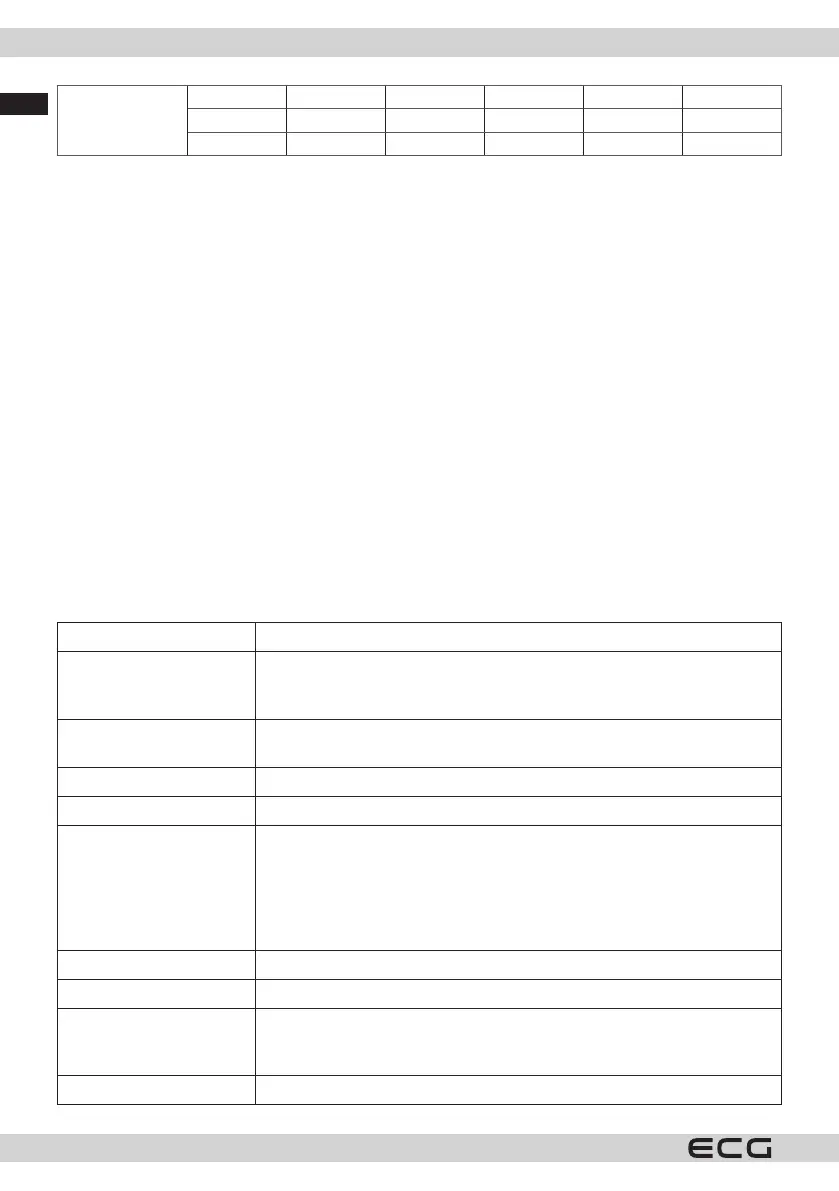
English
English
16
ECO 40-60
7.0 3:28 0.953 51.9 42 62.9%/1200
3.5 2:42 0.455 43.6 30 62.9%/1200
2.0 2:42 0.226 38.1 22 62.9%/1200
• The above information is for guidance only and is subject to change due to varying actual conditions of
use.
• The data given for programmes other than the ECO 40-60 programme are indicative only.
• Data according to EN 60456:2016/prA2019 and (EU)2019/2014, (EU)2019/2023: EU energy eciency class
is: C (for model EWTI 71120), D (for model EWT 70120)
• Energy testing programme: ECO 40-60. Other settings unchanged.
• Half load for a washing machine with a capacity of 7.0 kg: 3.5 kg.
• Quarter load for a washing machine with a capacity of 7.0 kg: 2.0 kg.
• The highest temperature the laundry will reach in a wash cycle for at least 5 minutes.
• The residual moisture content after the wash cycle in percentage of water content and the spin speed at
which this moisture content was achieved.
• The ECO 40-60 programme can wash normally soiled cotton clothes that are declared washable at 40 °C
or 60 °C together in one wash cycle. This programme serves to assess compliance with Regulation (EU)
2019/2023.
• The most energy-ecient programmes are generally those that run at lower temperatures and for longer
durations.
• Filling the household washing machine up to the capacity indicated for the respective programmes will
help save energy and water.
• Noise and residual moisture are aected by the spin speed. The higher the centrifugation speed in the
centrifugation phase, the higher the noise level and the lower the residual moisture.
Description of programmes
Select the washing programme according to the type of laundry.
Cotton Wear-resistant, heat-resistant fabrics made of cotton or linen.
Synthetics Washing synthetic items such as shirts, coats, blends. When washing knitted
textiles, you need to reduce the amount of detergent, as it easily forms foam
and bubbles.
Baby clothes When washing baby clothes, great emphasis is placed on gentle care that will
not irritate the baby's skin.
Quick 45' Quickly wash small amounts of not very dirty clothes.
Mix Mixed underwear consisting of fabrics made of cotton and synthetics.
Drum cleaning The washing machine is equipped with a special programme for automatic
cleaning of the drum and pipes. It uses sterilisation at a high temperature of
90°C to make washing clothes more environmentally friendly. You cannot add
laundry in this programme. If the right amount of chlorine bleach is added,
the cleaning eect will be higher. The customer can use this program on a
regular basis as needed.
20 °C When washing brightly colored clothes, it can better protect the colors.
Quick 15' Extra short programme suitable for small quantities of lightly soiled laundry.
Wool Wool fabrics or fabrics with wool blends that can be hand or machine washed.
Particularly gentle washing programme to prevent shrinkage, longer breaks
in the programme.
Centrifuging/discharging Extra spinning with selectable spin speed.
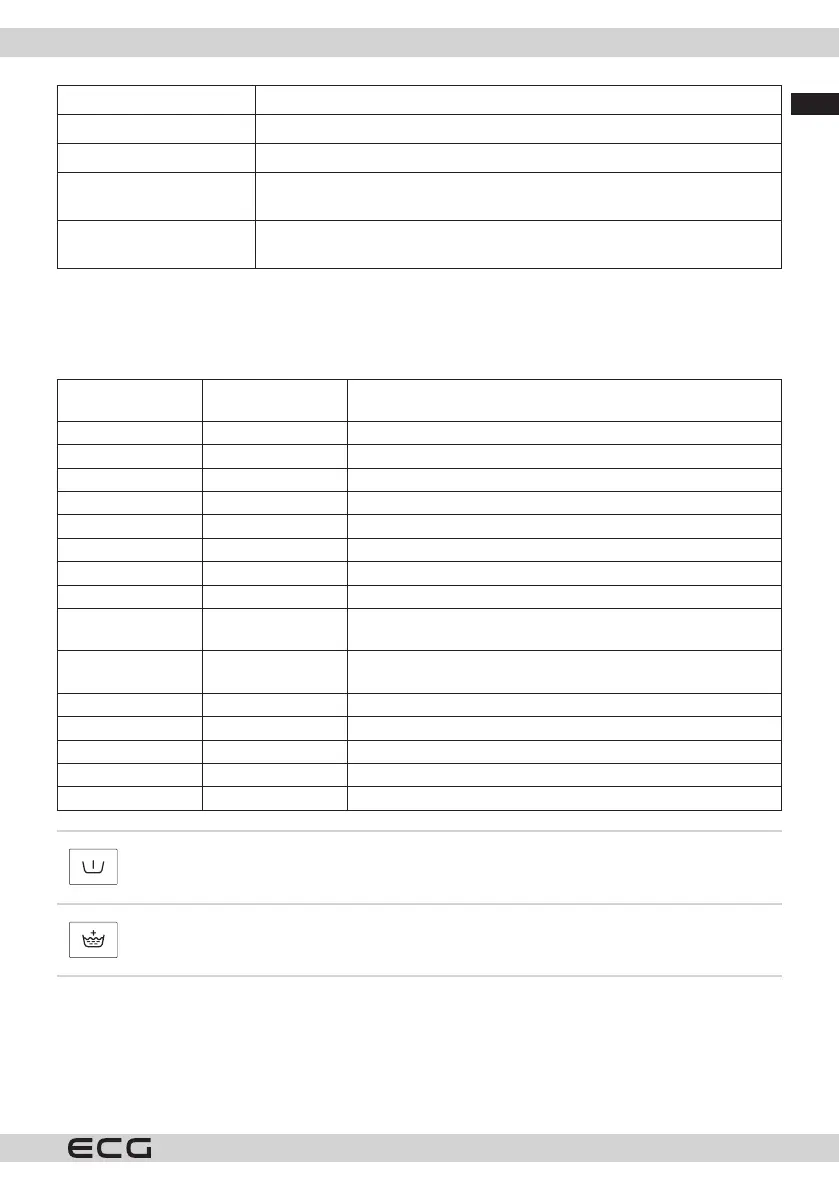
English
English
17
Washing/centrifuging Extra soaking with centrifugation.
Sports Laundry of sports and outdoor clothing.
Bedding This programme is specially designed for washing bedding.
Antiallergic Consistent washing at 70 °C ensures sterilising eects. A laundry weight of
less than 5 kg is recommended.
ECO 40-60 Default temperature 40 °C, cannot be changed. Suitable for laundry at
temperatures of approximately 40 to 60 °C.
Warning:
• If the power supply is interrupted during machine operation, the selected program is stored in a special
memory. When the power is restored, the machine will resume the program.
Additional functions
Programme
Default
temperature (°C)
Available additional functions
Antiallergic 70 Delayed start, Extra soak
Cotton 40 Delayed start, Extra soak, Pre-wash
20 °C 20 Delayed start, Extra soak, Pre-wash
Mix 40 Delayed start, Extra soak, Pre-wash
Wool 40 Delayed start, Extra soak
Synthetics 40 Delayed start, Extra soak, Pre-wash
ECO 40-60 - Delayed start
Self cleaning 90 Delayed start
Centrifuging/
discharging
- Delayed start
Washing/
centrifuging
- Delayed start, Extra soak
Baby clothes 60 Delayed start, Extra soak, Pre-wash
Sports 20 Delayed start, Extra soak, Pre-wash
Bedding 40 Delayed start, Extra soak
Quick 45' 40 Delayed start, Extra soak
Quick 15' Cool Delayed start
Prewash
Extra wash function before the main wash cycle to increase washing performance.
Note: Detergent must be added to Section I.
Extra soaking
When this function is selected, the laundry is also washed.
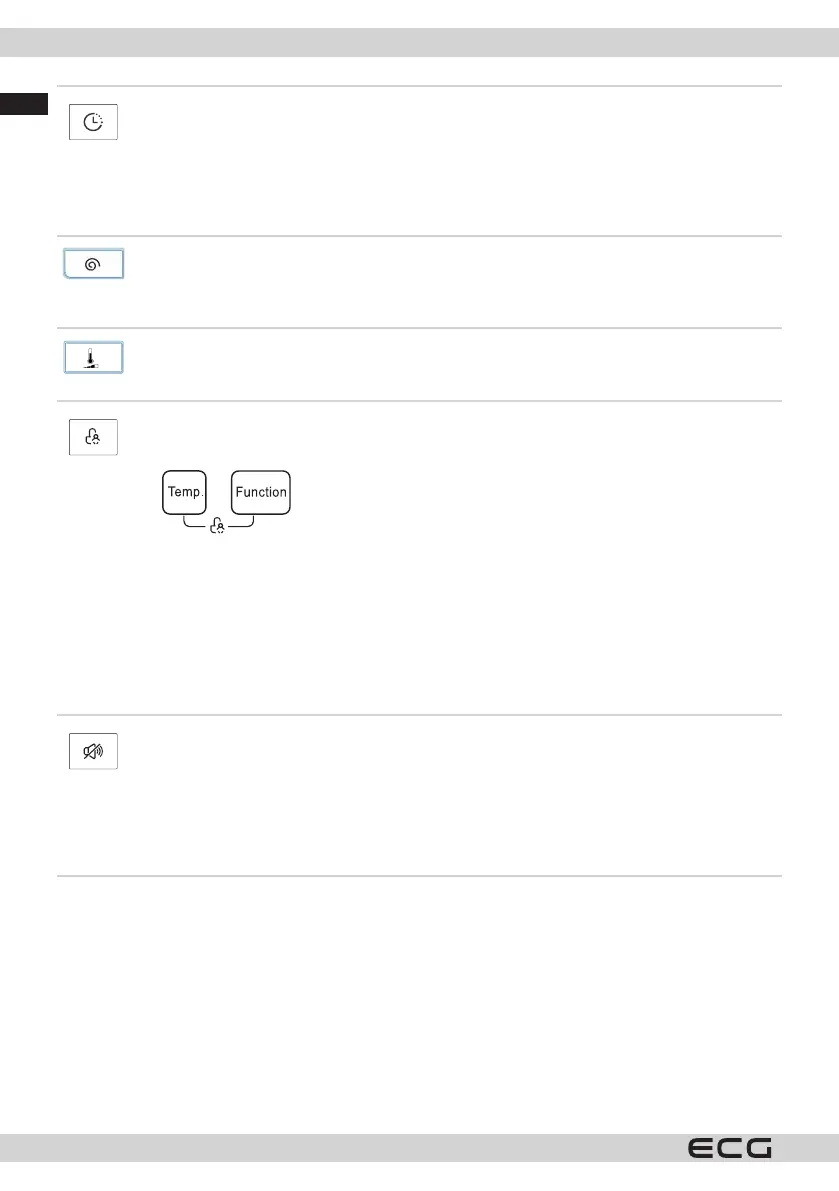
English
English
18
Delayed start
1. Choose a program
2. Press the [Temp.] button for 3 seconds to select a delay time in the range of 0-24 h.
3. Press the [Start/Pause] button to activate snooze.
To cancel the delayed start, press the [Temp. ] before starting the program until 0 h appears on
the display. If the programme has already been started, switch the appliance o, then switch it
on and select a new programme.
Speed
If necessary, the speed can be adjusted by pressing the Speed button in the following steps:
For washing machines with a speed of 1200 rpm: 0-400-600-800-1000-1200
For washing machines with a speed of 1300 rpm: 0-400-600-800-1000-1200-1300
Temperature
If necessary, the washing temperature can be adjusted by pressing the temperature button in
the following steps: Cold - 20 °C - 30 °C - 40 °C - 60 °C - 90 °C.
Child lock
This feature is designed to prevent children from misusing the controls.
Press the [Temp.] and [Function] buttons simultaneously for 3 seconds until the beep sounds.
The child lock light will come on.
When the child lock is activated, the display alternates between "CL" and the remaining time.
Pressing any other button will cause the child lock indicator to ash.
When the program is nished, the display alternates between "CL" and "END".
The child lock deactivates the function of all buttons except the on/o button and the child
lock button! The child lock can only be deactivated by pressing the two buttons [Temp.] and
[Function] simultaneously! Deactivate the child lock before selecting a new programme!
Mute the buzzer
1. Select the desired programme.
2. Press the [Speed] button for 3 seconds, the buzzer will go silent.
To activate the buzzer function, press the button again for 3 seconds. The setting will be
preserved until the next launch.
Attention! When the buzzer function is muted, the sounds will not automatically turn on by
themselves.
CLEANING AND MAINTENANCE
Warning:
• Before starting maintenance, disconnect the appliance from the mains and turn o the tap.
Cleaning the outside of the washing machine
Proper maintenance of your washing machine can extend its life. If necessary, the surface can be cleaned with
diluted non-abrasive neutral detergents. If water overows, wipe it o immediately with a damp cloth. Do not
use any sharp objects.
Formic acid and its diluted solvents or equivalent substances such as alcohol, solvents or chemical products
are prohibited.

English
English
19
Drum cleaning
Rust left by metal objects inside the drum is immediately removed with chlorine-free cleaning agents. Never
use wire. Do not put clothes in the washing machine while the drum is being cleaned.
Cleaning the inlet lter
• Decreasing water ow is a sign that the lter needs to be
cleaned.
1. Turn o the tap and remove the supply hose.
2. Clean the lter with a brush.
3. Unscrew the water supply hose from the back of the
machine. Pull the lter out with the pliers.
4. For example, use a toothbrush to clean it.
5. Reinstall the lter on the water inlet and reconnect the
inlet hose.
6. To ensure normal operation of the appliance, clean the
inlet lter every 3 months.
Cleaning the detergent dispenser
1. Press the arrow on the detergent dispenser cover inside the detergent dispenser.
2. Lift the clip up, remove the detergent dispenser cover and wash all the grooves with water.
3. Replace the fabric softener dispenser cover and insert the dispenser back in.
Warning:
• Do not use abrasive or corrosive products to clean plastic parts.
• To ensure normal operation of the appliance, clean the detergent dispenser every 3 months.
Cleaning the drain pump lter
Warning:
• Make sure the washing machine has completed
the wash cycle and is empty. Before cleaning
the drain pump lter, switch o the washing
machine and unplug it from the power outlet.
• Watch out for the hot water. Let the water cool.
Danger of scalding!
• Clean the lter regularly every 3 months to
ensure normal operation of the appliance.
1. Open the bottom cap.
2. Open the lter by turning it counterclockwise.
3. Remove dirt and foreign objects.
4. Close the bottom cap.
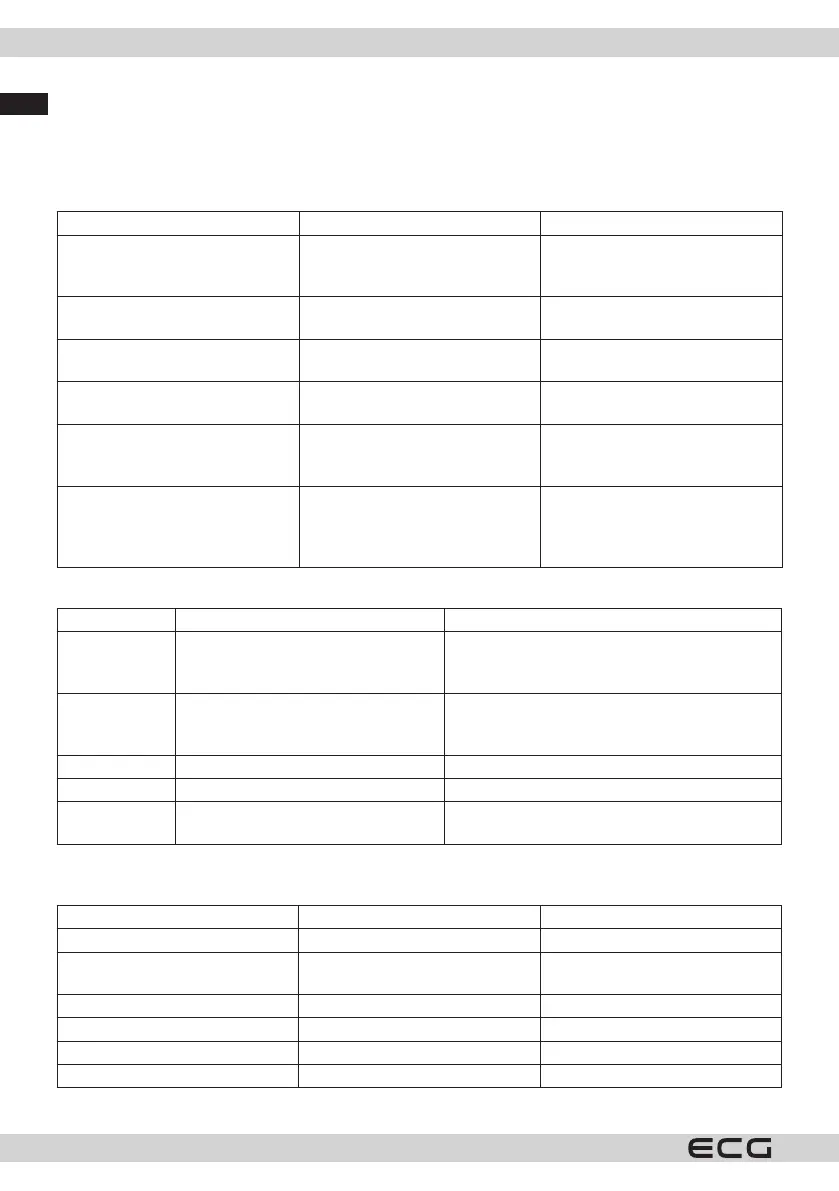
English
English
20
Warning:
• When the appliance is in operation and depending on the selected programme, there may be hot water
in the pump. Never remove the pump cover during a wash cycle, always wait until the appliance has
completed the cycle and is empty. When replacing the cover, make sure it is tightened securely.
TROUBLESHOOTING
Description Cause Solution
The washing machine cannot be
started.
The door is not closed properly. Start the washing machine after
closing the door. Check that the
laundry is not stuck in the drum.
The door can't be opened. The washing machine's safety lock
is active.
Disconnect the power and restart
the washing machine.
Water leakage The connection between the inlet
pipe or outlet hose is not tight.
Check and x the water pipes.
Clean the drain hose.
Detergent residue on the laundry
or in the drum.
The detergent is too thick. Clean and wipe the detergent
dispenser.
The indicator or display is not lit. Power is disconnected or the
electronics have malfunctioned.
Check that the power is not
switched o and that the plug is
correctly connected.
Unusual noise. Check that the fasteners (screws)
have been removed.
Install the refrigerator on a at and
solid surface.
Error messages on the display
Error code Cause Solution
E30 The door is not closed properly Start the washing machine after closing the
door. Check that the laundry is not stuck in the
drum.
E10 Water injection problem. Check that the water pressure is not too low.
Straighten the supply hose.
Check the inlet valve lter for blockages.
E21 It takes too long to drain the water. Check that the drain hose is not blocked.
E12 Water overow. Switch the washing machine o and on again.
EXX Others. Please try starting the wash again. If problems
persist, contact customer service.
TECHNICAL SPECIFICATIONS
EWT 70120 EWTI 71120
Built-in appliance No No
Maximum load capacity (dry
laundry) kg
7 7
Maximum speed/min. 1200 1200
Dimensions (H × W × D) [mm] 875 × 400 × 610 875 × 400 × 610
Nominal voltage 220–240 V ~ 50 Hz 220–240 V ~ 50 Hz
Power input 2100 W 2000 W
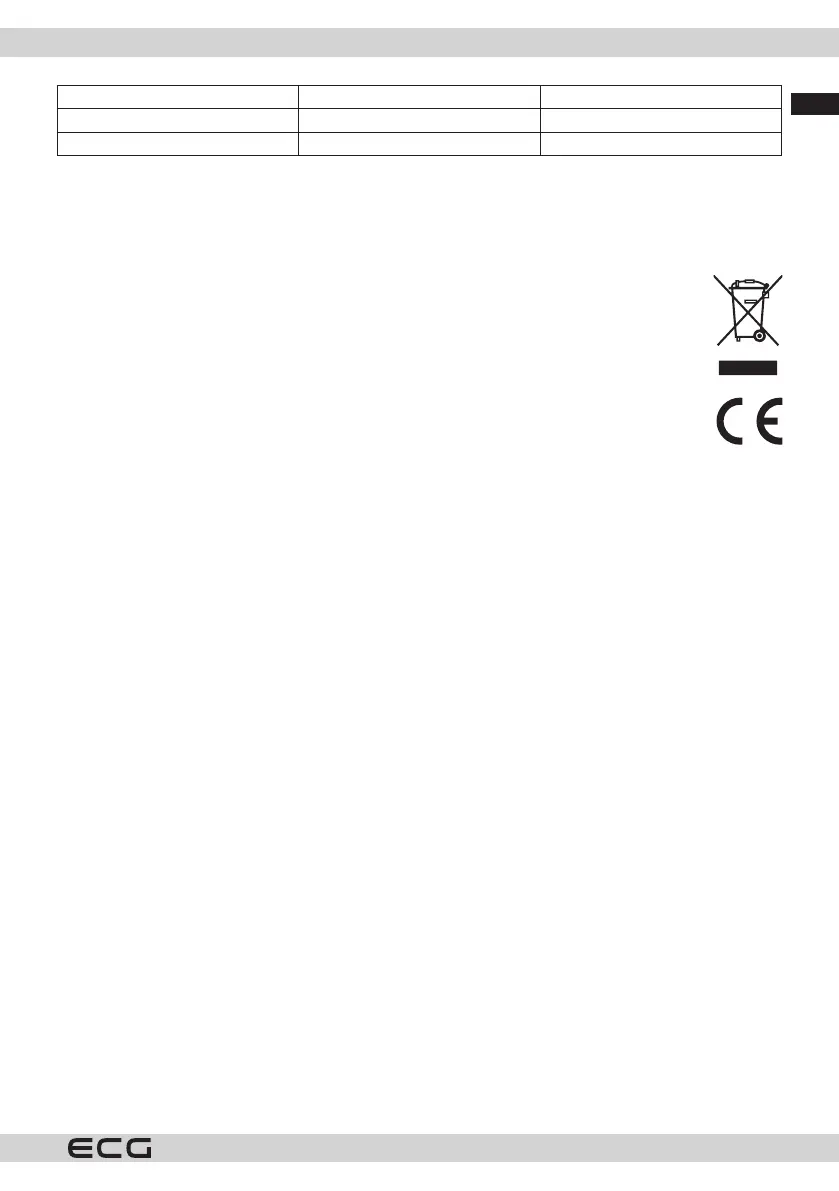
English
English
21
EWT 70120 EWTI 71120
Lid latch 10 A 10 A
Water pressure (MPa) min./max. 0.1 Mpa / 1 MPa 0.1 Mpa / 1 MPa
USE AND DISPOSAL OF WASTE
Wrapping paper and corrugated paperboard – deliver to scrapyard. Packing foil, PE bags, plastic elements – throw into plastic
recycling containers.
DISPOSAL OF PRODUCTS AT THE END OF LIFETIME
Disposal of electric and electronic equipment (valid in EU member countries and other European
countries with an implemented recycling system)
The represented symbol on the product or package means the product shall not be treated as domestic waste.
Hand over the product to the specied location for recycling electric and electronic equipment. Prevent negative
impacts on human health and the environment by properly recycling your product. Recycling contributes to
preserving natural resources. For more information on the recycling of this product, refer to your local authority,
domestic waste processing organization or store, where you purchased the product.
This product complies with the requirements of the EU directives on electromagnetic compatibility
and electrical safety and the issue of heavy metals in electrical and electronic equipment.
Furthermore, it meets the relevant energy intensity.
The operating manual is available at www.ecg-electro.eu.
Changes of text and technical parameters reserved.
Contact details for professional service for this product can be found in the enclosed Warranty Card or on the
website www.ecg-electro.eu.
• The warranty on this product is 24 months.
• Spare parts listed in EU 2019/2023 are available for 10 years.
• You can access the product database where the information for this product according to EU 2019/2014 is
stored by reading the QR code on the energy label.
08/05

Deutsch
Deutsch
22
TOPLADER-WASCHMASCHINE
SICHERHEITSHINWEISE
Bitte aufmerksam lesen undgut aufbewahren!
Warnung: Die in dieser Anleitung angeführ ten Sicherheitsvorkehrungen
und Hinweise umfassen nicht alle Umstände und Situationen, zu denen
es kommen kann. Der Anwender muss begreifen, dass der gesunde
Menschenverstand, Vorsicht und Sorgfalt zu Faktoren gehören, die
sich in kein Produkt einbauen lassen. Diese Faktoren müssen durch
den Anwender bzw. mehrere Anwender bei der Verwendung und
Bedienung dieses Geräts gewährleistet werden. Wir haften nicht für
Schäden, die durch Transport, eine unsachgemäße Verwendung,
Spannungsschwankungen sowie eine Änderung oder Modikation
des Geräts entstehen.
Befolgen sie die in dieser Bedienungsanleitung angeführten Hinweise.
Lesen Sie vor der Erstanwendung die schriftliche Bedienungsanleitung
eingehend durch und bewahren für den künftigen Gebrauch auf.
Um Brände oder Stromschläge zu vermeiden, sollten bei der Verwendung
elektrischer Geräte stets grundlegende Vorsichtsmaßnahmen
eingehalten werden, einschließlich der folgenden:
1. Vergewissern Sie sich, dass die Spannung Ihrer Steckdose mit der
Spannung auf dem Geräteschild übereinstimmt. Zur Wahrung
Ihrer Sicherheit empfehlen wir den Stecker der Stromleitung an
eine geerdete dreipolige Steckdose anzuschließen, die gemäß
der gültigen nationalen technischen Norm im Einklang mit den
Hinweisen des Herstellers sowie den lokalen Sicherheitsvorschriften
installiert wurde.
2. Benutzen Sie das Gerät nicht, falls das Netzkabel beschädigt ist.
Das Anschließen des Geräts an das Stromnetz, das Anschließen
der Wasserleitung, sämtliche Reparaturen, Einrichtungen und
das Auswechseln der Stromleitung sollte einem autorisierten
Kundendienst anvertraut werden! Demontieren Sie niemals die
Schutzabdeckungen des Gerätes. Dies könnte zu einem Stromunfall
führen!
TOPLADER-WASCHMASCHINE
Deutsch

Deutsch
Deutsch
23
TOPLADER-WASCHMASCHINE
3. Defekte Teile dürfen nur durch Originalersatzteile ersetzt werden.
Nur bei diesen Teilen garantiert der Hersteller, dass sie den
Sicherheitsanforderungen in vollem Umfang entsprechen.
4. Die Steckdose muss stets zugänglich sein, damit die Waschmaschine
jederzeit vom Stromnetz getrennt werden kann.
5. Unsachgemäß Reparaturen können den Benutzer erheblichen
Gefahren aussetzen, für die der Hersteller keinerlei Verantwortung
übernimmt.
6. Reparaturen dürfen nur von einer qualizierten Person und einem
dazu beauftragten Servicedienst durchgeführt werden.
7. Im Falle einer Störung oder bei Reinigungs- und Wartungsarbeiten
wird die Waschmaschine vom Stromnetz getrennt, wenn:
- der Stecker aus der Steckdose gezogen wurde, oder
- der Schutzschalter der Hausinstallation ausgeschaltet ist, oder
- die Schraubensicherung der Hausinstallation ist komplett
ausgeschraubt.
8. Netzstecker niemals mit feuchten Händen in die Steckdosen
stecken oder aus der Steckdose ziehen. Auf diese Weise beugen Sie
einem Stromunfall vor.
9. Gerät niemals mit feuchten Händen oder Füßen berühren.
10. Der Netzstecker sollte auch nach der Installation des Gerätes leicht
erreichbar sein. Netzkabel niemals verkürzen. Benutzen Sie keine
Mehrfachstecker oder Verlängerungskabel. Das Netzkabel darf
nicht mit heißen Teilen in Berührung kommen oder über scharfe
Kanten führen (es besteht Brandgefahr durch Überhitzung).
11. Schalten Sie das Gerät nicht durch das Einstecken ggf. Herausziehen
des Steckers ein/aus. Ziehen Sie nicht am Kabel, um den Stecker aus
der Steckdose zu ziehen. Ziehen Sie am Stecker, um das Kabel aus der
Steckdose zu ziehen. Schalten Sie das Gerät nach der Anwendung
mit Hilfe des Drehknopf durch Versetzen in die Position OFF aus,
trennen das Gerät vom Stromnetz und schließen alle Wasserzufuhr.
12. Waschmaschine nicht auf Teppiche und ähnliche Oberächen
aufstellen, da hierdurch die Ventilationsönungen in der Gerätebasis
blockiert werden könnten.

Deutsch
Deutsch
24
13. Stecken Sie keine Gegenstände in die Geräteönungen und stellen
Sie auf das Gerät keine Gegenstände (z.B. Vasen oder Tassen).
14. Ablaufschlauch niemals in Spülbecken, Eimer oder Waschbecken
platzieren.
15. Kinder dürfen nicht mit dem Gerät spielen. Geben Sie Acht, damit
Kinder und Tiere nicht in die Nähe der Waschmaschine gelangen.
Kinder unter 3 Jahren, die nicht dauerhaft beaufsichtigt werden,
sollten sich nicht in der Nähe der Waschmaschine aufhalten.
16. Kleine Teile, die sich im Beutel mit der Dokumentation benden,
sind außer Reichweite von Kindern aufzubewahren.
17. Stellen Sie das Gerät keiner direkten Sonnenstrahlung oder Regen
aus und benutzen Sie es nicht im Freien.
18. In der Nähe des Verbrauchsgerätes sollten keine brennbaren
Flüssigkeiten aufbewahrt werden.
19. Waschen Sie in der Waschmaschine keine Kleidung, die mit
brennbaren oder explosiven Stoen (Wachs, Öl, Farbe, Benzin,
Entfettungsmittel, chemische Lösungsmittel, Petroleum u.a.)
gereinigt, gewaschen, in diese eingeweicht oder mit diesen
bespritzt wurde. Es ist verboten leicht entzündliche, explosive und
toxische Lösungsmittel zu benutzen. Benutzen Sie kein Benzin,
Alkohol u. dgl. als Waschmittel. Es könnte zu einem Brand oder einer
Explosion kommen. Das Waschen von Teppichen ist verboten.
20. Berühren Sie die Waschmaschine während des Betriebes nicht mit
feuchten Händen. Önen Sie niemals während des Waschvorgangs
die Waschmittelschublade oder die Waschmaschinentür.
21. Seien Sie vorsichtig, wenn Sie die Tür önen, nachdem Sie
die Dampunktion benutzt haben. Es besteht die Gefahr von
Verbrennungen durch den Dampf und die hohen Temperaturen
auf der Oberäche der Trommel und auf dem Schauglas. Gehen Sie
einen Schritt zurück und warten Sie, bis der Dampf abgezogen ist.
22. Berühren Sie beim Ablassen von Wasser weder Ablaufschlauch
noch ablaufendes Wasser. Das Wasser könnte sehr heiß sein. Es
besteht Verbrennungsgefahr.

Deutsch
Deutsch
25
23. Falls Sie irgendeinen Mangel feststellen, trennen Sie das
Verbrauchsgerät vom Stromnetz und schließen den Wasserhahn.
Versuchen Sie niemals das Verbrauchsgerät eigenhändig zu
reparieren. Wenden Sie sich an eine autorisierte Kundendienststelle.
24. Vergessen Sie nicht vor der Erstverwendung die
TRANSPORTSICHERUNGSSCHRAUBEN DER TROMMEL ZU
ENTFERNEN. Von der Garantie ausgeschlossen sind Schäden,
die durch den Betrieb der Waschmaschine mit installierten
Transportsicherungsschrauben entstanden sind.
25. Das Gerät ist ausschließlich für den Haushaltsgebrauch und das
Waschen von Textilstoen bestimmt. Im Falle einer kommerziellen
Anwendung, die zuwider dieser Bedienungsanleitung ist, erlischt
jeglicher Garantieanspruch.
26. Diese Waschmaschine ist ausschließlich für den Gebrauch in
Innenräumen bestimmt.
27. Installieren Sie das Gerät nicht in nassen oder feuchten Räumen
oder in Räumen mit explosiven und ätzenden Gasen.
28. Kinder ab 8 Jahren und Personen mit verminderten physischen
und mentalen Fähigkeiten sowie mangelnden Erfahrungen und
Kenntnissen, können dieses Gerät nur unter Aufsicht benutzen
oder nachdem diese über einen gefahrlosen Gebrauch belehrt und
mit möglichen Gefahren bekannt gemacht wurden. Die seitens des
Anwenders vorgenommenen Reinigungs- und Wartungsarbeiten
dürfen nur Kinder ab 8 Jahren vornehmen, die überdies beaufsichtigt
werden. Kinder unter 8 Jahren sind außer Reichweite des Gerätes
und Netzkabels zu halten.
29. Eingrie dürfen ausschließlich an autorisierten Servicestellen
durchgeführt werden. Eingrie durch andere Personen führen zur
Nichtanerkennung der Garantie.
30. Von der Garantie ausgeschlossen sind Schäden durch
Umwelteinwirkungen (z.B. Hochwasser, Chemikalien, Brand).
31. Der Hersteller haftet nicht für Schäden infolge einer falschen
Erdung/Anwendung. SPANNUNGSGEFAHR, UNFALLGEFAHR!

Deutsch
Deutsch
26
EMPFEHLUNG
• Vor der Anwendung der neuen Waschmaschine sollten Sie einen qualizierten Installateur oder einen
autorisierten Kundenservice zur Hilfe holen, die Ihnen mit der Installation und Inbetriebnahme behilich
sind.
• Installieren Sie die Waschmaschine an einen gut belüfteten Ort mit einer ausreichenden Luftzirkulation.
Verbrauchsgerät so aufstellen, damit die Waschmaschinentür vollständig geönet werden kann. Es
handelt sich um keine Einbauwaschmaschine.
• Die ideale Umgebungstemperatur für den Betrieb der Waschmaschine liegt zwischen 15 °C und 25 °C.
• Eingefrorene Schläuche können Blasen bilden oder reißen. An Orten, an denen die Temperatur unter
den Gefrierpunkt fällt, könnte die Umgebungstemperatur die sichere Funktionsweise der Stromkreise
gefährden.
• Der erste Waschzyklus sollte ohne Wäsche mit dem Programm „90° weiße Baumwolle“ erfolgen. Geben Sie
½ der Waschmitteldosis in das zweite Fach der Waschmittelschublade.
• Da sich Waschpulver und Weichspüler bei langzeitigem Kontakt mit Luft ablagern könnten, empfehlen wir
Waschmittel und Weichspüler in die Waschmittelschublade kurz vor dem Waschvorgang zu geben.
• Das Programm für Vorwäsche sollte nur bei stark verschmutzter Wäsche benutzt werden.
• Die Wäschemenge, die in die Waschmaschine gegeben wird, darf nicht die maximale zulässige Menge
überschreiten. Anderenfalls läuft die Waschmaschine im Notbetrieb.
• Waschen Sie nur Wäsche, die laut Herstellermarkierung waschmaschinentauglich ist.
• Befolgen Sie bei Weichspülern und vergleichbaren Waschmitteln die Empfehlungen des Herstellers des
Waschmittels/Weichspülers.
• Vergewissern Sie sich, dass in den Kleidungstaschen frei von fremden Gegenstände sind (z.B. Nägel,
Nadeln, Münzen, Feuerzeuge, Streichhölzer oder Haarklammern). Diese Gegenstände könnten die
Waschmaschine beschädigen.
• Das Waschen von stark verschmutzten Kleidungsstücken beschädigt die Waschmaschine. Stark
verschmutzte Kleidungsstücke sollten vor dem Hineinlegen in die Waschmaschine ausgeschüttelt werden.
• Waschmittelschublade während des Waschvorganges niemals önen.
• Önen Sie die Waschmaschinentür während des Waschvorganges niemals mit Gewalt.
• Vergewissern Sie sich vor dem Önen der Tür, dass in der Trommel kein Wasser geblieben ist. Sollten Sie
Wasser sehen, önen Sie die Tür nicht.
• Warten Sie nach Programmende mindestens 2 Minuten, bevor Sie die Tür önen.
• Entfärbungsmittel enthalten Schwefel, der Korrosion verursachen könnte. Aus diesem Grund sollten
niemals Entfärbungsmittel benutzt werden. Benutzen Sie keine Mittel, die Lösungsmittel enthalten (z.B.
Benzin für technische Zwecke).
• Beabsichtigen Sie die Waschmaschine für längere Zeit nicht zu benutzen, trennen Sie die Stromzufuhr,
schließen die Wasserzufuhr und önen die Tür. Auf diese Weise bleibt der Innenraum der Waschmaschine
trocken und frei von Gerüchen.
• Nach dem Testen am Ende des Fertigungsprozesses könnte in der Waschmaschine etwas Wasser
zurückbleiben. Dieses stellt jedoch keine Gefahr für die Waschmaschine dar.
Auslaufen von Wasser
• Benutzen Sie das neue Schlauch-Set, das zusammen mit der Waschmaschine geliefert wird.
• Benutzen Sie keine alten Schlauch-Sets.
• Trennen Sie das Gerät nach der jeder Anwendung vom Stromnetz und schließen alle Wasserzuleitungen.
• Ablaufschlauch niemals in Spülbecken, Eimer oder Waschbecken platzieren.
Sturz- oder Unfallgefahr
• Steigen Sie niemals auf die Waschmaschine. Auch ist diese nicht zum Sitzen geeignet. Der Abdeckplatte
könnte zerspringen und zu Verletzungen führen.
• Stützen Sie sich niemals an der Tür. Schließen Sie die Tür nicht mit Gewalt. Sollte die Tür nur mühelos zu
schließen sein, vergewissern Sie sich, dass sich in der Trommel nicht zu viel Wäsche bendet und diese gut
aufgeteilt ist.

Deutsch
Deutsch
27
• Die Schläuche und das Netzkabel sollten nach der Installation geordnet werden, damit diese keine
Verletzungsgefahr darstellen. Mögliches Stolpern oder Stürzen könnte zu Verletzungen führen.
• Waschmaschine niemals umdrehen oder auf die Seite legen.
• Waschmaschine niemals an den herausragenden Teilen heben (Waschmittelschublade, Tür). Diese Teile
könnten beschädigt werden und zu Verletzungen führen.
• Mit der Waschmaschine sollten mindestens 2 Personen manipulieren.
Sicherheit von Kindern
• Kinder unter 3 Jahren, die nicht dauerhaft beaufsichtigt werden, sollten sich nicht in der Nähe der
Waschmaschine aufhalten. Kinder müssen dauerhaft beaufsichtigt werden, falls Sie sich in der Nähe der
Waschmaschine aufhalten. Kinder können im Inneren der Waschmaschine stecken bleiben, was fatale
Konsequenzen haben kann.
• Glastür und einige Oberächen könnten während des Betriebes sehr heiß werden. Schützen Sie Kleinkinder
vor dem Anfassen dieser Oberächen.
• Das Verpackungsmaterial sollte außer Reichweite von Kindern aufbewahrt werden. Es besteht
Erstickungsgefahr
• Der Verzehr von Waschmitteln kann zu einer Intoxikation führen. Haut- oder Augenkontakt kann zur
Irritation führen. Reinigungsmittel sollten außer Reichweite von Kindern gehalten werden.
PRODUKTBESCHREIBUNG
Tür
Waschmittelfach
Trommel
Servicelter
Netzkabel
Bedienfeld
Ablaufschlauch
Bemerkung: Das Produktschema ist als Anhaltspunkt zu verstehen, richten Sie sich nach dem tatsächlichen
Produkt.
Zubehör
• Lochstopfen für Transportschrauben (4 Stück)
• Zuleitungsschlauch für Kaltwasser
• Bedienungsanleitung

Deutsch
Deutsch
28
INSTALLATION
Installationsort
Hinweis:
• Stellen Sie sicher, dass der Aufstellungsort stabil ist.
• Stellen Sie sicher, dass das Gerät nicht auf dem Netzkabel steht.
Installieren Sie das Gerät nur an einem Ort, der die folgenden Bedingungen erfüllt:
• Feste, trockene und gerade Oberäche.
• Außerhalb der Reichweite des Sonnenlichtes.
• Angemessene Belüftung.
• Raumtemperatur höher als 5 °C.
• In ausreichendem Abstand zu Wärmequellen wie Öfen, Herden usw.
Auspacken der Waschmaschine
Hinweis:
• Verpackungsmaterial (z. B. Folie, Styropor) kann für Kinder gefährlich sein.
• Es besteht Erstickungsgefahr! Bewahren Sie das Verpackungsmaterial außerhalb der Reichweite von
Kindern auf.
1. Entfernen Sie den Karton und die Styroporverpackung.
2. Ziehen Sie die Waschmaschine heraus und entfernen Sie die Außenverpackung. Vergewissern Sie sich,
dass das kleine Schaumstodreieck zusammen mit der Verpackung entfernt wurde. Ist dies nicht der Fall,
legen Sie das Gerät mit der Seite nach unten und entfernen Sie den kleinen Schaumstoeinsatz von Hand
von der Unterseite des Geräts.
3. Entfernen Sie das Klebeband, mit dem das Netzkabel und der Ablaufschlauch befestigt sind.
4. Nehmen Sie den Zulaufschlauch aus der Trommel heraus.
Entfernen von Transportsicherungsschrauben
Ehe Sie die Waschmaschine in Betrieb nehmen, entfernen Sie auf der Hinterseite die 4
Transportsicherungsschrauben samt Gummiunterlagen. Falls die Schrauben nicht entfernt werden, können
sie zu starken Vibrationen, Lärm und einer falschen Funktionsweise der Waschmaschine führen. Was zum
Erlöschen des Garantieanspruchs führt.
1. Lösen Sie die Transportsicherungsschrauben mit Hilfe eines passenden Schlüssels durch Drehen
entgegengesetzt dem Uhrzeigersinn.
2. Entfernen Sie die Transportschrauben.
3. Legen Sie die Kunststo-Stopfen, die im Beutel mit dem Zubehör mitgeliefert wurden, in die
Önungen, die nach dem Entfernen der Transportsicherungsschrauben entstanden sind. Die
Transportsicherungsschrauben sollten für den künftigen Gebrauch aufbewahrt werden.
Lösen Sie die 4 Transportschrauben mit einem
Schraubenschlüssel.
Entfernen Sie die Schrauben einschließlich der
Gummiteile und bewahren Sie sie zur späteren
Verwendung auf.
Verschließen Sie die Löcher mit Stopfen.
Ausrichten der Position der Waschmaschine
Hinweis:
• Die Sicherungsmuttern an allen vier Füßen müssen fest mit dem Rahmen der Waschmaschine verschraubt
sein.

Deutsch
Deutsch
29
1. Lösen Sie die Sicherungsmutter.
2. Drehen Sie den Fuß, bis er den Boden erreicht.
3. Stellen Sie die Position der Füße ein und befestigen Sie die Muttern
mit einem Schraubenschlüssel. Vergewissern Sie sich, dass das Gerät
waagerecht und stabil steht.
Anschluss des Zulaufschlauchs
Hinweis:
• Um Leckagen oder Wasserschäden zu vermeiden, befolgen Sie
sorgfältig die in diesem Kapitel angeführten Hinweise.
• Biegen, quetschen oder modizieren Sie nicht den
Zulaufschlauch.
Schließen Sie den Zulaufschlauch an das
Wassereinlassventil und an den Kaltwasserhahn an,
siehe Abbildung. Ziehen Sie den Schlauch von Hand
an, verwenden Sie kein Werkzeug. Prüfen Sie, ob die
Verbindungen dicht sind.
Anschluss für Wasserablauf
Verbinden Sie den Ablaufschlauch mit dem Rohrwinkel des
Waschbeckens. Versuchen Sie nicht den Ablaufschlauch zu verlängern.
Geben Sie den Ablaufschlauch nicht in einen Behälter, einen Eimer oder
die Badewanne. Vergewissern Sie sich, dass der Ablaufschlauch nicht
gebogen, geknickt, zerknittert oder verlängert ist.
Der Ablaufschlauch ist in maximal 100 cm Höhe vom Boden zu
installieren.
VERWENDUNG
Schnellstart
Hinweis:
• Vergewissern Sie sich vor dem Waschen, dass die Waschmaschine richtig installiert ist.
• Ihr Gerät wurde vor dem Verlassen der Werkstatt eingehend geprüft. Um Wasserrückstände zu entfernen
und eventuelle Gerüche zu neutralisieren, empfehlen wir, das Gerät vor dem ersten Gebrauch zu reinigen.
Lassen Sie deshalb das Programm Baumwolle bei 60 °C ohne Wäsche und Waschmittel laufen.
Vor dem Waschen
1. Schließen Sie die Waschmaschine an das
Stromnetz an.
2. Önen Sie den Wasserhahn.
3. Füllen Sie die Waschmaschine mit Wäsche.
4. Geben Sie Waschmittel hinzu.
5. Schließen Sie die Trommeltür.
6. Schließen Sie die Waschmaschinentür.
Bemerkung:
• Bei Waschmaschinen mit Vorwäsche
muss das Waschmittel in das Fach I
gegeben werden, siehe Tabelle im Kapitel
„Waschmittelfach“.
• Vergewissern Sie sich, dass die
Trommelklappen richtig befestigt sind.

Deutsch
Deutsch
30
• Alle Metallhaken müssen ordnungsgemäß innerhalb der hinteren Türklappe angebracht sein.
• Überprüfen Sie vor jedem Waschgang, dass sich die Trommel ungehindert drehen kann.
Waschen
1. Wählen Sie ein Programm.
2. Wählen Sie eine zusätzliche Funktion.
3. Starten Sie den Waschvorgang.
Bemerkung:
• Wenn Sie das Programm in der
Standardeinstellung verwenden möchten,
können Sie Schritt 2 überspringen.
Nach Programmende
Auf dem Display wird „End“ angezeigt.
Vor jedem Waschen
• Die Lufttemperatur in dem Raum, in dem die Waschmaschine betrieben wird, sollte zwischen 6 und 40
°C liegen. Die Verwendung bei Temperaturen unter 0 °C kann das Einlassventil und das Abusssystem
beschädigen. Wenn das Gerät in einer frostigen Umgebung aufgestellt ist, sollte es vor dem Gebrauch in
einen Raum mit normaler Umgebungstemperatur umgestellt werden, so dass die Zu- und Ablaufschläuche
auftauen können.
• Prüfen Sie vor dem Waschen die Kleideretiketten mit Waschanleitung und Verwendung von Waschmittel.
Verwenden Sie ein nicht schäumendes oder weniger schäumendes Waschmittel, das für die
Maschinenwäsche geeignet ist.
Vorbereitung der Wäsche
Befolgen Sie die Hinweise auf den Kleideretiketten.
Sortieren Sie die Wäsche nach Wäschetyp (Baumwolle, synthetischen Fasern, feines Wäsche, Wolle u.a.),
Waschtemperatur (kalt, 30°, 40°, 60°, 90°) und Verschmutzungsgrad (leicht verschmutzt, verschmutzt, stark
verschmutzt).
Waschen Sie niemals bunte und weiße Wäsche zusammen.
Dunkle Wäsche kann überschüssigen Farbsto enthalten und sollte mehrmals separat gewaschen werden.
Vergewissern Sie sich, dass sich in der Wäsche oder in den Taschen keine metallischen Gegenstände benden;
falls ja, entfernen Sie diese.
ACHTUNG: Die Garantie bezieht sich nicht auf Störungen, die auf eine Beschädigung durch Fremdstoe
zurückzuführen ist.
Schließen Sie Reißverschlüsse, alle Haken und Patentknöpfe.
Entfernen Sie sämtliche Gardinenhaken aus Metall oder Kunststo oder waschen diese in einem Wäschebeutel.

Deutsch
Deutsch
31
Drehen Sie die Kleidung vor dem Waschen auf links (Hosen, Gestricktes, T-Shirts und Sweatshirts.
Socken, Taschentücher und sonstige kleine Wäsche sollten im Wäschebeutel gewaschen werden.
Symbole auf den Kleideretiketten
Normales Waschprogramm Maximale Waschtemperatur 90 °C
Maximale Waschtemperatur 60 °C
Maximale Waschtemperatur 30 °C
Handwäsche
Nicht in der Waschmaschine waschen
Kann gebleicht werden
Nicht bleichen
Bügeltemperatur max. 110 °C
Bügeltemperatur max. 150 °C Bügeltemperatur max. 200 °C Nicht bügeln
Chemische Reinigung
Nicht chemisch reinigen
Glatt legen
Nass aufhängen
Hängend trocknen Nicht in der Trockenmaschine
trocknen
Reinigung mit Benzin, Alkohol und
Triuortrichlorethan möglich
Reinigung mit Benzin und
Perchlorethylen möglich
Reinigung mit Perchlorethylen, R11,
R113 und Benzin möglich
BEMERKUNG: Überschreiten Sie nicht die maximale Wäscheladung der Trommel, was zu schlechten
Waschergebnissen und dem Zerknittern der Wäsche führen kann. Informationen über die
Waschmaschinenkapazität sind der Tabelle mit einzelnen Waschprogrammen zu entnehmen.
Die folgende Tabelle gibt das ungefähre Gewicht einzelner Kleidungsstücke an:
WÄSCHETYP GEWICHT (g)
Handtuch 200
Bettbezüge 500
Bademantel 1.200
Bettdecke 700
Kissenbezug 200
Unterwäsche 100
Tischdecke 250
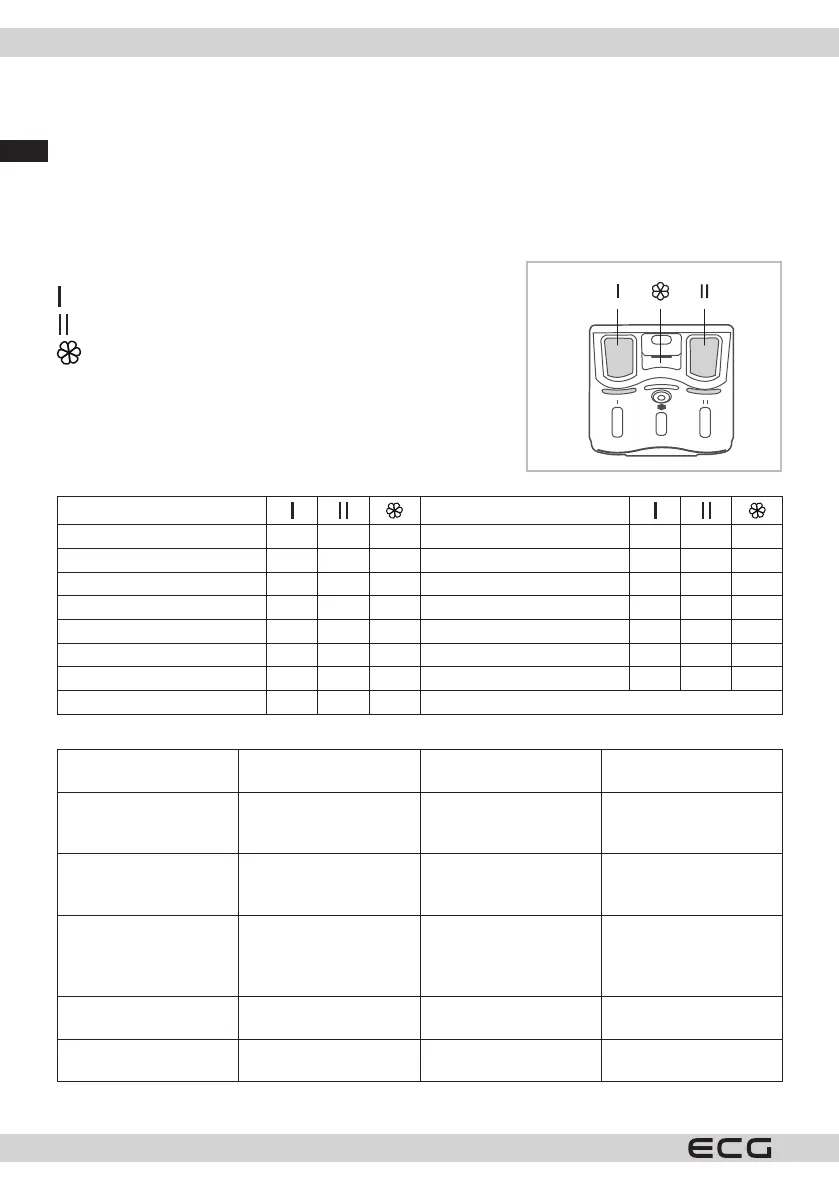
Deutsch
Deutsch
32
Hinweis:
• Waschen Sie keine Kleidungsstücke, die mit brennbaren oder explosiven Stoen wie Wachs, Öl, Farbe,
Benzin, Alkohol, Petroleum und anderen brennbaren Stoen gereinigt, gewaschen, getränkt oder
bestrichen wurden.
• Das Waschen einzelner Kleidungsstücke kann leicht zu einer ungleichmäßigen Belastung der Trommel
führen und zu einer Fehlfunktion führen. Es wird daher empfohlen, eine oder zwei weitere Wäschestücke
in die Trommel zu geben, um ein gleichmäßiges Schleudern zu gewährleisten.
• Waschen oder schleudern Sie keine wasserdichten Bezüge und Kleidungsstücke, Matten oder Teppiche.
Waschmittelfach
Vorwaschmittel
Waschmittel für die Hauptwäsche
Weichspüler
Hinweis:
• Überschreiten Sie beim Füllen von Waschmittel oder Weichspüler
nicht die MAX-Markierung.
Programm Programm
Antiallergisch
Schleudern/Auslassen
Baumwolle
Spülen/Schleudern
20 °C
Baby
Mischwäsche
Sportbekleidung
Wolle
Bettzeug
Kunstfasern
Kurzprogramm 45'
ECO 40-60
Kurzprogramm 15'
Autoreinigung
= automatisch; = wählbar
Empfehlungen für Waschmittel
Empfohlenes
Waschmittel
Waschprogramm Waschtemperatur Art von Wäsche und
Textilien
Starke Reinigungsmittel
und Bleichmittel.
Baumwolle, ECO 40-60,
Mix
20/30/40/60 Weiße Wäsche aus
Baumwolle oder
kochfesten Leinen.
Waschmittel für
bunte Wäsche ohne
Bleichmittel
Baumwolle, ECO 40-60,
Mix
Kalt/20/30/40 Buntwäsche aus
Baumwolle oder Leinen.
Feinwaschmittel für
bunte Wäsche ohne
Bleichmittel
Kunstfasern Kalt/20/30/40 Buntwäsche aus
pegeleichten Fasern
oder synthetischen
Materialien.
Feines Waschmittel Kunstfasern 20/30 Feine Textilien, Seide,
Viskose.
Spezielles Waschmittel
für Wolle
Wolle 20/30 Wolle.
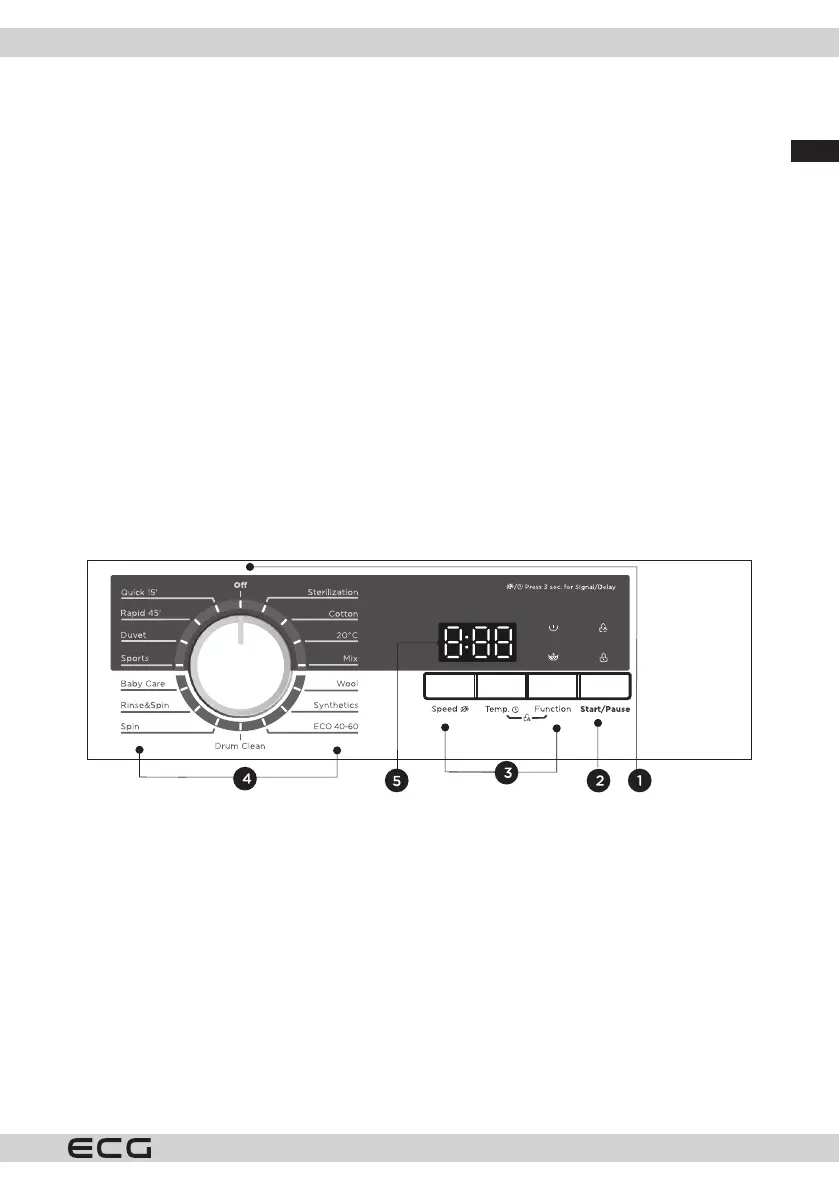
Deutsch
Deutsch
33
Dosieren des Waschmittels
Die Menge des dosierten Waschmittels hängt von den folgenden Kriterien ab:
• Leicht verschmutzte Wäsche sollte ohne Vorwäsche gewaschen werden. Geben Sie ein wenig Waschmittel
in das Fach II der Waschmittelschublade.
• Sollte die Wäsche stark verschmutzt sein, wählen Sie ein Programm mit Vorwäsche aus und geben Sie
¼ des Waschmittels in das Fach I und das restliche Waschmittel in das Fach II der Waschmittelschublade.
• Benutzen Sie Waschmittel, die für automatische Waschmaschinen bestimmt sind. Befolgen Sie die
Hinweise des Waschmittelherstellers bezüglich der richtigen Dosierung des Waschmittels.
• In Regionen mit hartem Wasser sollte mehr Waschmittel dosiert werden.
• Die Waschmittelmenge wächst mit der Wäschemenge.
• Geben Sie den Weichspüler in das mittlere Fach der Waschmittelschublade.
• Überschreiten Sie beim Füllen von Waschmittel oder Weichspüler nicht die MAX-Markierung.
• Dicküssige Weichspüler oder Waschmittel können die Waschmittelschublade verstopfen, daher sollten
sie mit etwas Wasser verdünnt werden.
Wenn zu viel Waschmittel dosiert wird:
• Beim Waschen entsteht eine große Menge Schaum.
• Die Wäsche wird unzureichend gespült.
Wenn die Menge des Waschmittels nicht ausreicht:
• Die Wäsche wird grau.
• Auf der Trommel, dem Heizelement und/oder der Wäsche setzt sich Kalk ab.
Bedienfeld
Bemerkung: Das Bild ist illustrativ.
1 Position „AUS“ (OFF) 2 Start/Pause
Wenn sich der Programmschalter in dieser
Position bendet, ist die Waschmaschine
ausgeschaltet.
Drücken Sie diese Taste, um den Waschgang zu
starten oder zu unterbrechen.
3 Zusätzliche Funktionen 4 Programm
Dient zur Auswahl einer zusätzlichen Funktion.
Wenn eine Funktion ausgewählt ist, leuchtet
diese Taste auf.
Auswahl des Waschprogramms je nach Art der
Wäsche.
5 Display
Das Display zeigt die Einstellungen, die geschätzte Restlaufzeit, die Optionen und die Statusmeldungen
der Waschmaschine an. Das Display bleibt während des Waschvorgangs eingeschaltet.
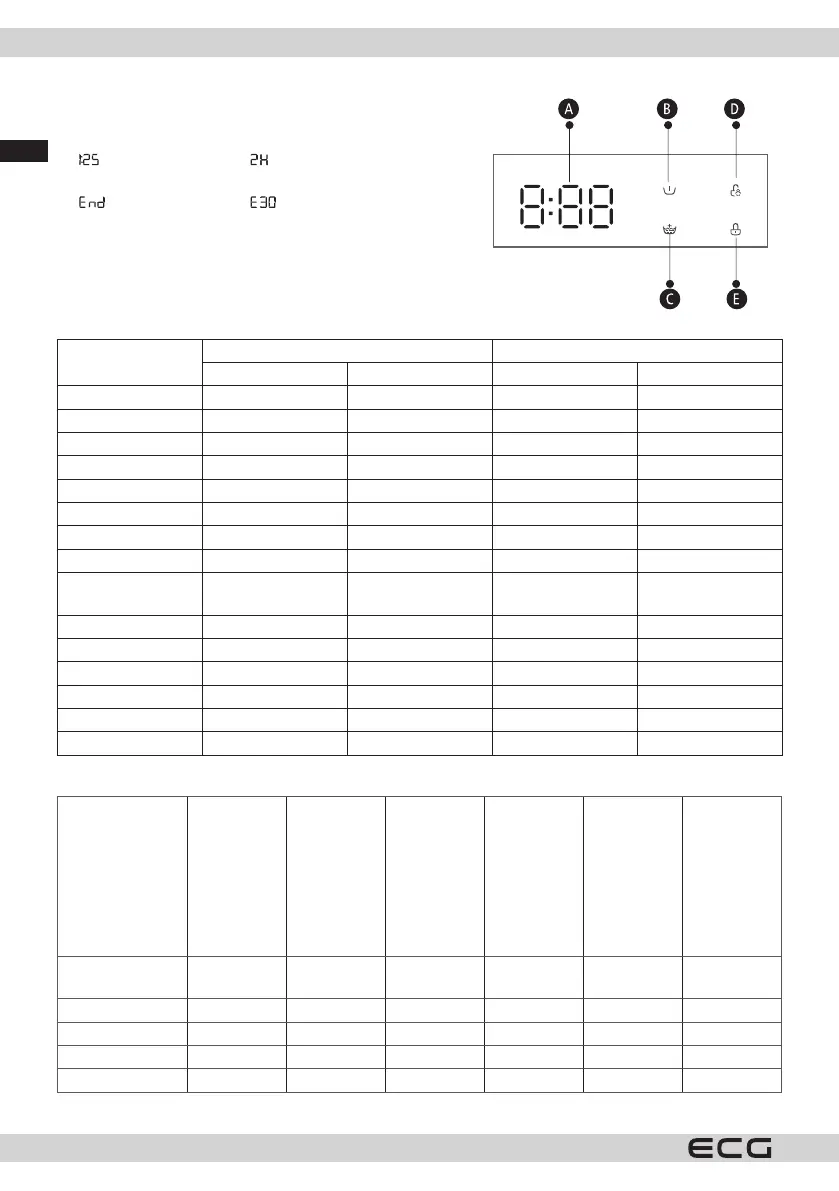
Deutsch
Deutsch
34
A Display
Waschzeit
Einschaltverzögerung
Zyklusende Fehler
B Vorwäsche C Extraspülen
D Kindersperre E Türschloss
Programmtabelle
Programm
Füllung (kg) Dauer
EWT 70120 EWTI 71120 EWT 70120 EWTI 71120
Antiallergisch 3,5 3,5 2:27 2:27
Baumwolle 7,0 7,0 2:40 2:40
20 °C 3,5 3,5 1:01 1:01
Mischwäsche 3,5 3,5 1:20 1:20
Wolle 2,0 2,0 1:07 1:07
Kunstfasern 3,5 3,5 2:20 2:20
ECO 40-60 7,0 7,0 3:18 3:28
Autoreinigung - - 1:18 1:18
Schleudern/
Auslassen
7,0 7,0 0:12 0:12
Spülen/Schleudern 7,0 7,0 0:20 0:20
Baby 7,0 7,0 2:01 2:01
Sportbekleidung 3,5 3,5 0:45 0:45
Bettzeug 2,5 2,5 1:27 1:27
Kurzprogramm 45' 2,0 2,0 0:45 0:45
Kurzprogramm 15' 2,0 2,0 0:15 0:15
EWT 70120
Programm
Nennkapazität (kg)
Programmlänge
(Std:min.)
Stromverbrauch
kWh/Zyklus
Wasserverbrauch
Liter/Zyklus
Maximale
Temperatur (°C)
Restfeuchte in (%)
1000 U/min.
Kurzprogramm
15 min.
2,0 0:15 0,035 31 Kaltes
Wasser
70%/800
20 °C 3,5 1:01 0,213 43 20 65%/1000
Baumwolle (60°C) 7,0 2:45 1,385 65 60 65%/1000
Kunstfasern 3,5 2:20 0,678 43 40 65%/1000
Mischwäsche 7,0 1:20 0,742 65 40 65%/1000
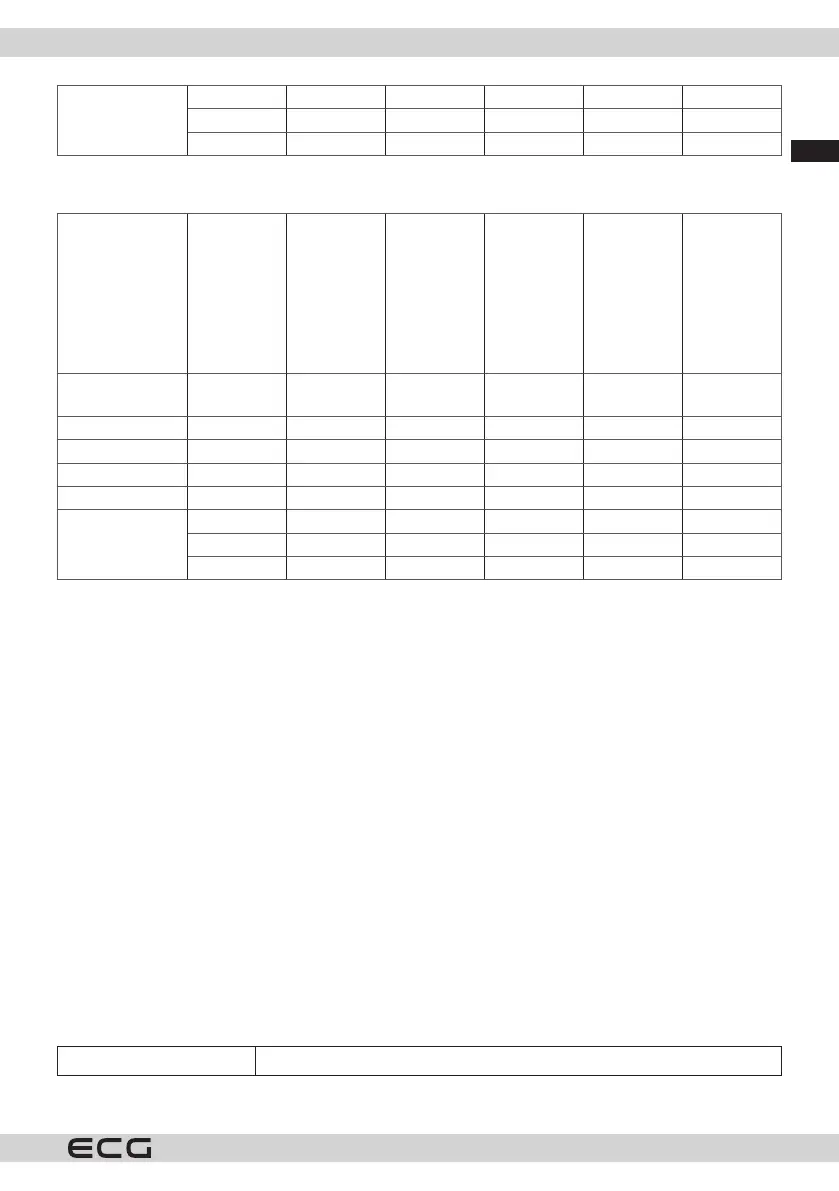
Deutsch
Deutsch
35
ECO 40-60
7,0 3:18 0,907 52,0 35 62,9%/1200
3,5 2:42 0,622 43,0 32 62,9%/1200
2,0 2:42 0,433 37,0 23 62,9%/1200
EWTI 71120
Programm
Nennkapazität (kg)
Programmlänge
(Std:min.)
Stromverbrauch
kWh/Zyklus
Wasserverbrauch
Liter/Zyklus
Maximale
Temperatur (°C)
Restfeuchte in (%)
1000 U/min.
Kurzprogramm
15 min.
2,0 0:15 0,035 31 Kaltes
Wasser
70%/800
20 °C 3,5 1:01 0,177 43 20 65%/1000
Baumwolle (60°C) 7,0 2:45 1,289 65 60 65%/1000
Kunstfasern 3,5 2:20 0,596 43 40 65%/1000
Mischwäsche 7,0 1:20 0,696 65 40 65%/1000
ECO 40-60
7,0 3:28 0,953 51,9 42 62,9%/1200
3,5 2:42 0,455 43,6 30 62,9%/1200
2,0 2:42 0,226 38,1 22 62,9%/1200
• Die obigen Angaben sind als Richtwerte zu verstehen und können aufgrund unterschiedlicher tatsächlicher
Einsatzbedingungen variieren.
• Die Angaben für andere Programme als das Programm ECO 40-60 sind nur als Richtwerte zu verstehen.
• Angaben nach EN 60456:2016/prA2019 und (EU)2019/2014, (EU)2019/2023: EU-Energieezienzklasse: C
(für Modell EWTI 71120), D (für Modell EWT 70120)
• Energie-Testprogramm: ECO 40-60. Andere Einstellungen bleiben unverändert.
• Halbe Ladung für eine Waschmaschine mit 7,0 kg Fassungsvermögen: 3,5 kg.
• Viertelladung für eine Waschmaschine mit 7,0 kg Fassungsvermögen: 2,0 kg.
• Die höchste Temperatur, welche die Wäsche in einem Waschgang für mindestens 5 Minuten erreicht.
• Der Restfeuchtegehalt nach dem Waschgang in Prozent des Wassergehalts und die Schleuderdrehzahl, bei
der dieser Feuchtegehalt erreicht wurde.
• Mit dem Programm ECO 40-60 kann normal verschmutzte Baumwollkleidung, die als waschbar bei 40
°C oder 60 °C deklariert ist, in einem Waschgang gewaschen werden. Dieses Programm dient dazu, die
Einhaltung der Verordnung (EU) 2019/2023 zu bewerten.
• Die energieezientesten Programme sind im Allgemeinen diejenigen, die bei niedrigeren Temperaturen
und einem längeren Waschgang laufen.
• Das Befüllen der Waschmaschine bis zum angegebenen Fassungsvermögen für die jeweiligen Programme
hilft, Energie und Wasser zu sparen.
• Geräusche und Restfeuchte werden durch die Schleuderdrehzahl beeinusst. Je höher die
Schleuderdrehzahl beim Schleudern, desto höher ist der Lärm und desto niedriger ist die Restfeuchte.
Beschreibung der Programme
Wählen Sie das Waschprogramm entsprechend der Art der Wäsche.
Baumwolle Strapazierfähige Stoe, hitzebeständige Stoe aus Baumwolle oder Leinen.

Deutsch
Deutsch
36
Kunstfasern Waschen von synthetischen Stoen wie Hemden, Mänteln und
Mischgeweben. Beim Waschen von gestrickten Textilien müssen Sie die
Menge des Waschmittels reduzieren, da es leicht Schaum und Blasen bildet.
Baby Beim Waschen von Babykleidung wird großer Wert auf eine schonende Pege
gelegt, welche die Haut des Babys nicht reizt.
Kurzprogramm 45' Waschen Sie schnell kleine Mengen nicht sehr schmutziger Kleidung.
Mischwäsche Gemischte Unterwäsche, die aus Baumwoll- und Synthetikstoen besteht.
Autoreinigung Die Waschmaschine ist mit einem speziellen Programm zur automatischen
Reinigung der Trommel und der Leitungen ausgestattet. Es nutzt die
Sterilisation bei einer hohen Temperatur von 90 °C, um das Waschen von
Kleidung umweltfreundlicher zu machen. Sie können in diesem Programm
keine Wäsche hinzufügen. Wenn die richtige Menge Bleichmittel mit Chlor
hinzugefügt wird, ist die Reinigungswirkung höher. Der Kunde kann dieses
Programm je nach Bedarf regelmäßig nutzen.
20 °C Beim Waschen von Buntwäsche werden die Farben besser geschützt.
Kurzprogramm 15' Extra kurzes Programm, geeignet für kleine Mengen leicht verschmutzter
Wäsche.
Wolle Wollstoe oder Stoe mit Wollmischungen, die von Hand oder in der Maschine
gewaschen werden können. Besonders schonendes Waschprogramm zur
Vermeidung des Einlaufens, längere Programmpausen.
Schleudern/Auslassen Extra Schleudern mit wählbarer Schleuderdrehzahl.
Spülen/Schleudern Extraspülen mit Schleudern.
Sportbekleidung Waschen von Sport- und Outdoor-Kleidung.
Bettzeug Dieses Programm ist speziell für das Waschen von Bettzeug konzipiert.
Antiallergisch Durch konsequentes Waschen bei 70 °C wird die sterilisierende Wirkung
sichergestellt. Es wird ein Wäschegewicht von weniger als 5 kg empfohlen.
ECO 40-60 Standardtemperatur 40 °C, kann nicht geändert werden. Geeignet für
Waschen bei Temperaturen von etwa 40 bis 60 °C.
Hinweis:
• Wird die Stromzufuhr während des Betriebs des Geräts unterbrochen, wird das gewählte Programm in
einem speziellen Speicher abgelegt. Wenn die Stromversorgung wiederhergestellt ist, setzt das Gerät das
Programm fort.
Zusätzliche Funktionen
Programm Ausgangstemperatur (°C) Verfügbare Zusatzfunktionen
Antiallergisch 70 Verzögerter Start, Extraspülen
Baumwolle 40 Verzögerter Start, Extraspülen, Vorwaschen
20 °C 20 Verzögerter Start, Extraspülen, Vorwaschen
Mischwäsche 40 Verzögerter Start, Extraspülen, Vorwaschen
Wolle 40 Verzögerter Start, Extraspülen
Kunstfasern 40 Verzögerter Start, Extraspülen, Vorwaschen
ECO 40-60 - Verzögerter Start
Autoreinigung 90 Verzögerter Start

Deutsch
Deutsch
37
Programm Ausgangstemperatur (°C) Verfügbare Zusatzfunktionen
Schleudern/
Auslassen
- Verzögerter Start
Spülen/Schleudern - Verzögerter Start, Extraspülen
Baby 60 Verzögerter Start, Extraspülen, Vorwaschen
Sportbekleidung 20 Verzögerter Start, Extraspülen, Vorwaschen
Bettzeug 40 Verzögerter Start, Extraspülen
Kurzprogramm 45' 40 Verzögerter Start, Extraspülen
Kurzprogramm 15' Kühl Verzögerter Start
Vorwäsche
Zusätzliche Waschfunktion vor dem Hauptwaschgang zur Erhöhung der Waschleistung.
Bemerkung: Das Waschmittel muss in das Fach I gegeben werden.
Extraspülen
Wenn diese Funktion gewählt wird, wird die Wäsche zusätzlich gespült.
Verzögerter Start
1. Wählen Sie ein Programm
2. Halten Sie die Taste [Temp.] 3 Sekunden lang gedrückt, um einen verzögerten Start im
Bereich von 0–24 h auszuwählen.
3. Drücken Sie die Taste [Start/Pause], um den verzögerten Start zu aktivieren.
Wenn Sie den verzögerten Start abbrechen möchten, drücken Sie die Taste [Temp. ] vor dem
Start des Programms, bis 0 h auf dem Display erscheint. Wenn das Programm bereits gestartet
wurde, schalten Sie das Gerät aus, schalten Sie es ein und wählen Sie ein neues Programm.
Drehzahl
Falls erforderlich, kann die Drehzahl mit der Taste Speed in den folgenden Schritten eingestellt
werden:
Für Waschmaschinen mit einer Drehzahl von 1200 U/min: 0-400-600-800-1000-1200
Für Waschmaschinen mit einer Drehzahl von 1300 U/min: 0-400-600-800-1000-1200-1300
Temperatur
Falls erforderlich, kann die Waschtemperatur mit der Temperaturtaste in den folgenden Schritten
eingestellt werden: Kalt - 20 °C - 30 °C - 40 °C - 60 °C - 90 °C.

Deutsch
Deutsch
38
Kindersperre
Diese Funktion soll verhindern, dass Kinder die Bedienelemente missbrauchen.
Halten Sie die Tasten [Temp.] und [Function] gleichzeitig 3 Sekunden lang gedrückt, bis ein
Piepton ertönt. Die Anzeige für Kindersicherung leuchtet auf.
Wenn die Kindersicherung aktivier t ist, wird abwechselnd „CL“ und die verbleibenden Zeit angezeigt.
Wenn Sie eine beliebige Taste drücken, blinkt die Anzeige für Kindersicherung.
Sobald das Programm beendet ist, wird abwechselnd „CL“ und „END“ angezeigt.
Die Kindersicherung deaktiviert die Funktion aller Tasten außer der Ein/Aus-Taste und der
Kindersicherungstaste! Die Kindersicherung kann nur durch gleichzeitiges Drücken der Tasten
[Temp.] und [Function] deaktiviert werden! Deaktivieren Sie die Kindersicherung, bevor Sie ein
neues Programm wählen!
Stummschalten des Summers
1. Wählen Sie ein Programm aus.
2. Halten Sie die Taste [Speed] 3 Sekunden lag gedrückt, um den Summer stummzuschalten.
Wenn Sie die Summerfunktion wieder aktivieren möchten, halten Sie die Taste erneut 3
Sekunden lang gedrückt. Die Einstellung wird bis zum nächsten Start beibehalten.
Achtung! Wenn die Summerfunktion stummgeschaltet ist, schalten sich die Töne nicht von
selbst ein.
REINIGUNG UND WARTUNG
Hinweis:
• Bevor Sie mit der Wartung beginnen, trennen Sie das Gerät vom Stromnetz und drehen Sie den Wasserhahn
zu.
Reinigung der Außenseite der Waschmaschine
Eine ordnungsgemäße Wartung Ihrer Waschmaschine kann ihre Lebensdauer verlängern. Falls erforderlich,
kann die Oberäche mit verdünnten, nicht abrasiven Neutralreinigern gereinigt werden. Wischen Sie
überlaufendes Wasser sofort mit einem feuchten Tuch ab. Verwenden Sie keine scharfen Gegenstände.
Ameisensäure und ihre verdünnten Lösungsmittel oder gleichwertige Stoe wie Alkohol, Lösungsmittel oder
chemische Produkte sind verboten.
Reinigung der Trommel
Rost, der von Metallgegenständen im Inneren der Trommel zurückbleibt, kann sofort mit chlorfreien
Reinigungsmitteln entfernt werden. Verwenden Sie niemals Topfkratzer. Geben Sie keine Wäsche in die
Waschmaschine, während die Trommel gereinigt wird.

Deutsch
Deutsch
39
Reinigung des Eingangslters
• Ein abnehmender Wasserdurchuss weist darauf hin, dass
der Filter gereinigt werden muss.
1. Drehen Sie den Wasserhahn zu und entfernen Sie den
Zulaufschlauch.
2. Reinigen Sie den Filter mit einer Bürste.
3. Schrauben Sie den Zulaufschlauch von der Rückseite des
Geräts ab. Ziehen Sie den Filter mit einer Zange heraus.
4. Verwenden Sie zum Beispiel eine Zahnbürste, um sie zu
reinigen.
5. Setzen Sie den Filter wieder auf den Wasserzulauf und
schließen Sie den Zulaufschlauch wieder an.
6. Um einen normalen Betrieb des Geräts zu gewährleisten,
sollten Sie den Einlasslter alle 3 Monate reinigen.
Reinigung des Waschmittelfachs
1. Drücken Sie auf den Pfeil auf der Abdeckung des Waschmittelfachs innerhalb der Waschmittelschublade.
2. Heben Sie den Clip an, entfernen Sie die Abdeckung des Weichspülerfachs und waschen Sie alle Rillen mit
Wasser aus.
3. Bringen Sie die Abdeckung des Weichspülerfachs wieder an und setzen Sie die Waschmittelschublade
wieder ein.
Hinweis:
• Verwenden Sie zur Reinigung von Kunststoteilen keine abrasiven oder ätzenden Produkte.
• Reinigen Sie das Waschmittelfach alle 3 Monate, um einen normalen Betrieb des Geräts zu gewährleisten.
Reinigung des Ablaufpumpenlters
Hinweis:
• Vergewissern Sie sich, dass die Waschmaschine
den Waschgang beendet hat und leer ist.
Bevor Sie den Filter der Ablaufpumpe reinigen,
schalten Sie die Waschmaschine aus und
trennen Sie sie vom Stromnetz.
• Achten Sie auf das heiße Wasser. Lassen Sie das
Wasser abkühlen. Verbrühungsgefahr!
• Reinigen Sie den Filter regelmäßig alle 3 Monate,
um einen normalen Betrieb des Geräts zu
gewährleisten.
1. Önen Sie den unteren Verschluss.
2. Önen Sie den Filter, indem Sie ihn gegen den
Uhrzeigersinn drehen.
3. Entfernen Sie Schmutz und Fremdkörper.

Deutsch
Deutsch
40
4. Schließen Sie den unteren Verschluss.
Hinweis:
• Wenn das Gerät in Betrieb ist, kann sich je nach gewähltem Programm heißes Wasser in der Pumpe
benden. Entfernen Sie niemals die Abdeckung der Pumpe während des Waschvorgangs. Warten Sie,
bis das Gerät den Waschvorgang beendet hat und leer ist. Achten Sie beim Auswechseln der Abdeckung
darauf, dass sie fest angezogen ist.
PROBLEMBEHEBUNG
Beschreibung Ursache Lösung
Die Waschmaschine lässt sich
nicht einschalten.
Die Tür ist nicht richtig
geschlossen.
Starten Sie die Waschmaschine,
nachdem Sie die Tür geschlossen
haben. Vergewissern Sie sich, dass
die keine Wäsche in der Trommel
stecken geblieben ist.
Die Tür lässt sich nicht önen. Die Sicherheitssperre der
Waschmaschine ist aktiv.
Trennen Sie die Stromzufuhr und
starten Sie die Waschmaschine
neu.
Wasserleck. Die Verbindung zwischen
der Zulaueitung oder dem
Ablaufschlauch ist nicht dicht.
Überprüfen und befestigen Sie die
Wasserleitungen. Reinigen Sie den
Ablaufschlauch.
Waschmittelrückstände auf der
Wäsche oder in der Trommel.
Das Waschmittel ist zu dicküssig. Reinigen und wischen Sie die
Waschmittelschublade ab.
Die Anzeige oder das Display
leuchtet nicht.
Die Stromversorgung ist
unterbrochen oder die Elektronik
weist eine Fehlfunktion auf.
Vergewissern Sie sich, dass das
Gerät nicht ausgeschaltet ist
und dass der Stecker richtig
angeschlossen ist.
Übermäßiger Lärm. Vergewissern Sie sich, dass
die Befestigungselemente
(Schrauben) entfernt wurden.
Stellen Sie die Waschmaschine auf
eine gerade und feste Oberäche.
Fehlermeldungen auf dem Display
Fehlercode Ursache Lösung
E30 Die Tür ist nicht richtig geschlossen Starten Sie die Waschmaschine, nachdem Sie die
Tür geschlossen haben. Vergewissern Sie sich,
dass die keine Wäsche in der Trommel stecken
geblieben ist.
E10 Problem mit der Wassereinspritzung. Vergewissern Sie sich, dass der Druck nicht zu
niedrig ist.
Richten Sie den Zuleitungsschlauch gerade.
Prüfen Sie den Filter des Einlassventils auf
Verstopfungen.
E21 Das Auslassen von Wasser dauert zu
lange.
Prüfen Sie, ob der Ablaufschlauch nicht verstopft
ist.
E12 Überlaufen von Wasser. Schalten Sie die Waschmaschine aus und wieder
ein.
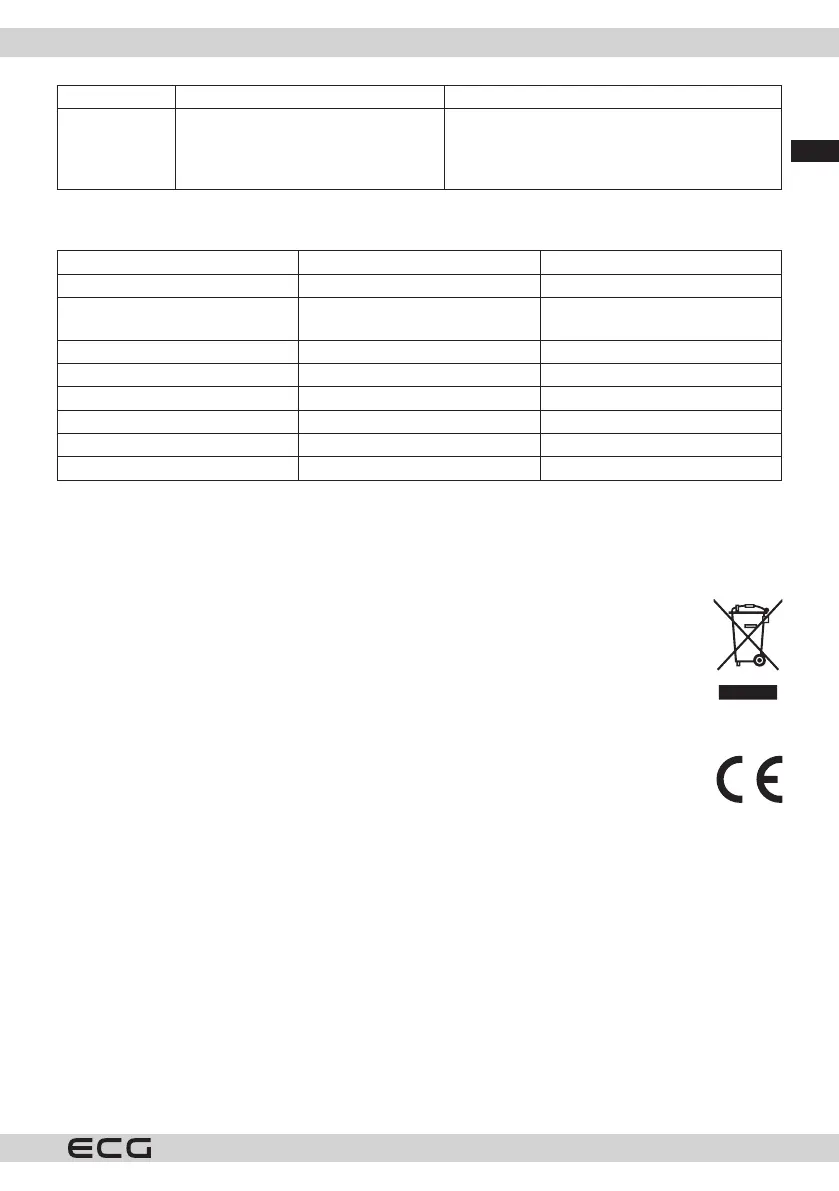
Deutsch
Deutsch
41
Fehlercode Ursache Lösung
EXX Sonstiges. Versuchen Sie den Waschvorgang zu
wiederholen. Sollten die Probleme
weiterhin bestehen, wenden Sie sich an eine
Kundendienststelle.
TECHNISCHE ANGABEN
EWT 70120 EWTI 71120
Einbaugerät Nein Nein
Maximale Beladungskapazität
(trockene Wäsche) kg
7 7
Maximale Drehzahl/min. 1200 1200
Abmessungen (H× B× T) [mm] 875 × 400 × 610 875 × 400 × 610
Nennspannung 220–240 V ~ 50 Hz 220–240 V ~ 50 Hz
Anschlusswert 2100 W 2000 W
Sicherung 10 A 10 A
Wasserdruck (MPA) min./max. 0,1 MPa/ 1 MPa 0,1 MPa/ 1 MPa
VERWERTUNG UND ENTSORGUNG VON ABFALL
Verpackungspapier und Wellenpappe an einer Sammelstelle abgeben. Verpackungsfolie, PET-Beutel und Kunststoteile
gehören in Sammelcontainer für Kunststo.
ENTSORGUNG DES PRODUKTES NACH ABLAUF DER LEBENSDAUER
Entsorgung von gebrauchten elektrischen und elektronischen Geräten (gültig in den Mitgliedsländern
der EU und anderen europäischen Ländern, in denen das Abfalltrennungssystem eingeführt ist)
Das abgebildete Symbol auf dem Produkt oder auf der Verpackung weist darauf hin, dass das Produkt nicht
in den Hausmüll gehört. Das Produkt sollte an einem Ort abgeben werden, der für die Wiederverwertung von
elektrischen und elektronischen Geräten bestimmt ist. Eine richtige Entsorgung des Produktes beugt negativen
Einüssen auf die menschliche Gesundheit und die Umwelt vor. Die Wiederverwertung trägt zum Schutz der
Naturressourcen bei. Weitere Informationen über die Wiederverwertung des Produktes erhalten Sie über das
Gemeindeamt, eine Organisation, die sich mit der Behandlung von Hausmüll befasst, oder die Verkaufsstelle, an
der das Produkt erworben wurde.
Dieses Produkt erfüllt die Anforderungen der EU-Richtlinien zur elektromagnetischen
Verträglichkeit und elektrischen Sicherheit sowie zur Schwermetallproblematik in Elektro- und
Elektronikgeräten. Außerdem erfüllt es die entsprechende Energieezienzklasse.
Die Bedienungsanleitung ist der Website www.ecg-electro.euzu entnehmen.
Änderungen des Textes und der technischen Parameter sind vorbehalten.
Die Kontaktdaten für den professionellen Service für dieses Produkt nden Sie in der beiliegenden Garantiekarte
oder auf der Website www.ecg-electro.eu.
• Die Garantie für dieses Produkt beträgt 24 Monate.
• Die in der EU 2019/2023 aufgeführten Ersatzteile sind 10 Jahre lang erhältlich.
• Sie können auf die Produktdatenbank zugreifen, in der die Informationen für dieses Produkt gemäß EU
2019/2014 gespeichert sind, indem Sie den QR-Code auf dem Energieetikett lesen.
08/05

Čeština
Čeština
42
PRAČKA S VRCHNÍM PLNĚNÍM
BEZPEČNOSTNÍ POKYNY
Čtěte pozorně auschovejte pro budoucí potřebu!
Varování: Bezpečnostní opatření apokyny uvedené vtomto návodu
nezahrnují všechny možné podmínky asituace, ke kterým může dojít.
Uživatel musí pochopit, že faktorem, který nelze zabudovat do žádného
zvýrobků, je zdravý rozum, opatrnost apéče. Tyto faktory tedy musí být
zajištěny uživatelem/uživateli používajícími aobsluhujícími toto zařízení.
Neodpovídáme za škody způsobené během přepravy, nesprávným
používáním, kolísáním napětí nebo změnou či úpravou jakékoliv části
zařízení.
Dodržujte pokyny obsažené v tomto návodě. Před prvním použitím si
celý písemný návod důkladně prostudujte a uchovejte pro další potřebu.
Aby nedošlo ke vzniku požáru nebo k úrazu elektrickým proudem, měla
by být při používání elektrických zařízení vždy dodržována základní
opatření, včetně těch následujících:
1. Ujistěte se, že napětí ve vaší zásuvce odpovídá napětí uvedenému na
štítku zařízení. Pro zajištění své bezpečnosti vidlici napájecího vodiče
vkládejte do řádně uzemněné trojpólové zásuvky instalované podle
platné elektrotechnické normy ČSN v souladu s pokyny výrobce a
místními bezpečnostními předpisy.
2. Nepoužívejte přístroj, pokud je přívodní kabel poškozen. Zapojení
spotřebiče do elektrické sítě a připojení vody, veškeré opravy nebo
seřízení včetně výměny napájecího přívodu svěřte autorizovanému
servisu! Nedemontujte ochranné kryty zařízení, hrozí nebezpečí
úrazu elektrickým proudem!
3. Vadné součásti smí být nahrazeny jen originálními náhradními díly.
Jen u těchto dílů výrobce garantuje, že budou v plném rozsahu
splňovat bezpečnostní požadavky.
4. Musí být vždy zajištěn přístup kzásuvce, aby bylo kdykoliv možné
pračku odpojit od elektrické sítě.
5. Neodborně provedené opravy mohou uživatele vystavit značnému
nebezpečí, za které výrobce neručí.
PRAČKA S VRCHNÍM PLNĚNÍM
Čeština

Čeština
Čeština
43
PRAČKA S VRCHNÍM PLNĚNÍM
6. Opravy smí provádět pouze odborně způsobilá osoba a k tomu
určená servisní služba.
7. Vpřípadě poruchy nebo při čištění a ošetřování je pračka elektricky
odpojená od sítě jen tehdy, když:
- je vytažená síťová zástrčka pračky ze zásuvky, nebo
- je vypnutý jistič domovní elektrické instalace, nebo
- je úplně vyšroubovaná šroubovací pojistka domovní elektrické
instalace.
8. Přívodní kabel nezapojujte a nevypojujte ze zásuvky vlhkýma
rukama. Předejdete tak riziku úrazu elektrickým proudem.
9. Spotřebiče se nedotýkejte vlhkýma rukama nebo nohama.
10. Po instalaci přístroje musí vidlice napájecího přívodu zůstat snadno
dostupná. Kabel nezkracujte a nepoužívejte rozdvojky nebo
prodlužovací šňůry. Napájecí přívod se nesmí dotýkat horkých
částí ani vést přes ostré hrany (hrozí nebezpečí požáru v důsledku
přehřátí).
11. Přístroj nezapínejte a nevypínejte zasunutím nebo vytažením vidlice
napájecího přívodu. Vidlici nevytahujte ze zásuvky taháním za
kabel. Kabel odpojte ze zásuvky uchopením za vidlici. Po ukončení
používání vždy vypněte pomocí otočného voliče do polohy OFF
(vypnuto), odpojte spotřebič od napájení a uzavřete přítok vody.
12. Pračku nestavte na koberce a podobné povrchy, které by mohly
blokovat ventilační otvory v základně.
13. Nikdy nic nezasouvejte do otvorů přístroje, na přístroj nepokládejte
žádné předměty (např. vázy, hrnky apod.).
14. Vypouštěcí hadici vaší pračky neumisťujte do dřezu, vědra nebo
umyvadla.
15. Nedovolte dětem, aby si se zařízením hrály. Chraňte přístup k
pračce před dětmi nebo zvířaty. Dětem mladším 3 let by mělo být
zabráněno v přístupu, pokud nejsou trvale pod dozorem.
16. Malé součásti, které naleznete v sáčku s dokumentací, uložte mimo
dosah dětí.
17. Zařízení nevystavujte přímému slunečnímu záření, nepoužívejte
venku a nevystavujte dešti.

Čeština
Čeština
44
18. V blízkosti spotřebiče nenechávejte hořlavé tekutiny.
19. Neperte v pračce věci, které byly čištěné, umyté, namáčené nebo
potřísněné hořlavými nebo výbušnými látkami (vosk, olej, barva,
benzín, odmašťovače, chemická rozpouštědla, petroleje atd). Je
zakázané používání snadno zápalných a výbušných nebo toxických
rozpouštědel. Nepoužívejte benzín, alkohol aj. jako prací prostředky.
Mohlo dojít k požáru nebo výbuchu. Praní koberců je zakázané.
20. Nedotýkejte se pračky vlhkýma rukama, pokud je spuštěná.
Nikdy během praní a odstřeďovaní neotevírejte zásuvku na prací
prostředek nebo dvířka pračky.
21. Pozor při otvírání dvířek po použití funkce spárou. Hrozí nebezpečí
popálení vystupující párou a vysokými teplotami na povrchu bubnu
ina skleněném průhledu. Ustupte okrok a počkejte, dokud se pára
nerozplyne.
22. Během vypouštění se nedotýkejte vypouštěcí hadice a vypouštěné
vody. Voda může při provozu pračky dosáhnout vysokých teplot.
Hrozí riziko popálení.
23. V případě jakékoli závady spotřebič nejprve odpojte od napájení
a poté zavřete vodovodní kohoutek. Nepokoušejte se spotřebič
opravit vlastními silami, obraťte se na autorizovaný servis.
24. Před prvním použitím nezapomeňte ODSTRANIT ARETAČNÍ
ŠROUBY zajišťující buben pračky během přepravy. Na poškození
způsobené spuštěním pračky s instalovanými aretačními šrouby se
záruka nevztahuje.
25. Spotřebič je určen výhradně pro domácí použití a na praní pouze
textilních materiálů. V případě komerčního použití nebo použití,
které není v souladu s tímto manuálem, pozbývá záruka platnosti.
26. Tato pračka je určena výlučně k používání ve vnitřních prostorech.
27. Spotřebič neinstalujte ve mokrých a vlhkých místnostech, také
rovněž v místnostech, ve kterých se vyskytují výbušné nebo žíravé
plyny.
28. Tento spotřebič mohou používat děti ve věku 8 let a starší a osoby se
sníženými fyzickými či mentálními schopnostmi nebo nedostatkem
zkušeností a znalostí, pokud jsou pod dozorem nebo byly poučeny

Čeština
Čeština
45
o používání spotřebiče bezpečným způsobem a rozumí případným
nebezpečím. Čištění a údržbu prováděnou uživatelem nesmějí
provádět děti, pokud nejsou starší 8 let a pod dozorem. Děti mladší
8 let se musí držet mimo dosah spotřebiče a jeho přívodu.
29. Jakýkoli zásah do spotřebiče jinou osobou než pracovníkem
autorizovaného servisu má za následek ztrátu záruky.
30. Záruka se nevztahuje na poškození způsobené vnějšími vlivy
(povodeň, chemikálie, požár apod.).
31. Výrobce nenese žádnou odpovědnost za škody vzniklé nesprávným
uzemněním/použitím. NEBEZPEČNÉ NAPĚTÍ, RIZIKO ÚRAZU!
DOPORUČENÍ
• Než začnete svou novou automatickou pračku používat, požádejte o pomoc s instalací a uvedením do
provozu kvalikovaného instalatéra nebo autorizovaný servis.
• Pračku instalujte na dobře větrané místo s dostatečnou cirkulací vzduchu. Spotřebič umístěte tak, aby
bylo možné dvířka pračky kompletně otevřít. Pračka není určená do vestaveb a nábytkových sestav.
• Ideální okolní teplota pro provoz pračky je 15 °C až 25 °C.
• Zmrzlé hadice mohou zpuchřet a prasknout. V oblastech, kde teplota klesá pod bod mrazu, může okolní
teplota ohrozit bezpečný provoz elektronických obvodů.
• První prací cyklus doporučujeme absolvovat bez prádla na program „90° bílá bavlna“ tak, že do zásuvky
pracího prostředku nasypete do druhé přihrádky ½ odměrky pracího prostředku.
• Jelikož při dlouhodobém kontaktu se vzduchem může docházet k usazování pracího prášku nebo
aviváže, dávkujte do zásuvky prací prostředek a aviváž až těsně před zamýšleným praním.
• Program s předpírkou doporučujeme používat pouze pro silně znečištěné prádlo.
• Množství prádla vloženého do pračky nesmí překročit maximální povolené množství. V opačném
případě poběží pračka v nouzovém režimu.
• Pračku používejte pouze pro prádlo, které je výrobcem označeno jako vhodné pro praní v pračce.
• Při používání aviváže a podobných přípravků ve vaší pračce dodržujte doporučení výrobce pracího
prostředku/aviváže.
• Ujistěte se, že se v kapsách prádla vkládaného do pračky nenacházejí cizí předměty (hřebíky, jehly, mince,
zapalovače, zápalky, sponky a podobně). Tyto cizí předměty by mohly pračku poškodit.
• Praní silně zaprášených oděvů poškozuje vaši pračku. Silně zaprášené oděvy před vložením do pračky
vyklepejte.
• Nikdy neotevírejte zásuvku pracího prostředku za chodu spotřebiče.
• Za chodu nikdy neotevírejte násilím dvířka pračky.
• Před otevřením dvířek zkontrolujte, zda v dubnu nezůstala voda. Jestliže je vidět vodu, dvířka pračky
neotvírejte.
• Po ukončení programu vyčkejte alespoň 2 minuty a poté dvířka otevřete.
• Síra obsažená v odbarvovačích může způsobovat korozi. Z tohoto důvodu v pračce nikdy nepoužívejte
odbarvovače. V pračce nikdy nepoužívejte látky obsahující rozpouštědla (např. technický benzín).
• Pokud nebudete pračku delší dobu používat, odpojte ji od sítě, zavřete přívod vody a nechejte dvířka
otevřená. Vnitřní prostor pračky tak zůstane suchý a bez nežádoucího zápachu.
• Po testování na konci výrobního procesu mohlo v pračce zůstat malé množství vody, které však
nepředstavuje riziko poškození vaší pračky.
Nebezpečí vyplavení
• Používejte nový komplet hadic dodávaný spolu se spotřebičem

Čeština
Čeština
46
• Nepoužívejte opakovaně starý komplet hadic.
• Po ukončení používání vždy odpojte spotřebič od napájení a uzavřete přítok vody.
• Vypouštěcí hadici vaší pračky neumisťujte do dřezu, vědra nebo umyvadla.
Nebezpečí pádu nebo úrazu
• Na pračku nestoupejte ani nesedejte. Vrchní deska by mohla prasknout a mohli byste se zranit.
• Neopírejte se o dvířka. Nezavírejte je násilím. Je-li zavírání dvířek obtížné, zkontrolujte, zda se v pračce
nenachází příliš mnoho oděvů, nebo zda jsou dobře rozmístěné.
• Po instalaci uspořádejte bezpečně hadice a přívodní šňůru. Zakopnutí a pád mohou být příčinou úrazu.
• Pračku neobracejte vzhůru nohama nebo na bok.
• Pračku nezvedejte za vyčnívající části (zásuvka pracího prostředku, dvířka). Mohlo by dojít k jejich
poškození a úrazu.
• Manipulace s pračkou vyžaduje součinnost alespoň dvou osob.
Bezpečnost dětí
• Dětem mladším 3 let by mělo být zabráněno v přístupu, pokud nejsou trvale pod dozorem. Nenechávejte
děti bez dozoru v blízkosti pračky. Děti by se mohly uzavřít uvnitř pračky s fatálními následky.
• Během provozu mohou být skleněná dvířka a povrchy pračky velmi horké. Chraňte malé děti a zvířata
před dotykem s těmito povrchy.
• Obalové materiály uložte mimo dosah dětí. Hrozí riziko udušení
• Požití pracích prostředků může způsobit otravu a kontakt s pokožkou nebo očima může
způsobitpodráždění. Čisticí prostředky držte mimo dosah dětí.
POPIS PRODUKTU
Dvířka
Dávkovač pracího prostředku
Buben
Servisní ltr
Napájecí kabel
Ovládací panel
Vypouštěcí hadice
Poznámka: Schéma produktu je pouze orientační, standardně se řiďte skutečným produktem.

Čeština
Čeština
47
Příslušenství
• Záslepky do otvorů po přepravních šroubech (4 ks)
• Přívodní hadice pro studenou vodu
• Návod k obsluze
INSTALACE
Místo instalace
Upozornění:
• Dbejte na to, aby bylo místo instalace stabilní.
• Dbejte na to, aby výrobek nestál na přívodním kabelu.
Spotřebič instalujte výhradně na místo, které splňuje následující podmínky:
• Pevný, suchý a rovný povrch.
• Mimo dosah slunečního záření.
• Dostatečné větrání.
• Pokojová teplota vyšší než 5 °C.
• V dostatečné vzdálenosti od zdrojů tepla, jako jsou kamna, sporáky atd.
Vybalení pračky
Upozornění:
• Obalový materiál (např. fólie, polystyren) může být pro děti nebezpečný.
• Hrozí riziko udušení! Obalové materiály udržujte mimo dosah dětí.
1. Odstraňte kartonovou krabici a polystyrenový obal.
2. Vytáhněte pračku a odstraňte základní obal. Ujistěte se, že malý pěnový trojúhelník je odstraněn
společně se spodním. Pokud tomu tak není, položte spotřebič bokem dolů a poté ručně odstraňte malou
pěnovou vložku ze dna spotřebiče.
3. Odstraňte pásku upevňující napájecí kabel a vypouštěcí hadici.
4. Odstraňte přívodní hadici z bubnu.
Odstranění přepravních šroubů
Než pračku uvedete do provozu, odstraňte z její zadní části 4 přepravní šrouby a pryžové podložky. Pokud
šrouby nebudou odstraněny, mohou způsobit silné vibrace, hluk a nesprávnou funkci pračky a vést ke ztrátě
záruky.
1. Povolte přepravní šrouby otočením proti směru hodinových ručiček pomocí vhodného klíče.
2. Přepravní šrouby vyjměte.
3. Vložte plastové záslepky dodané v sáčku s příslušenstvím do otvorů, které zůstaly po odstranění
přepravních šroubů. Přepravní šrouby by měly být uschovány pro budoucí použití.
Uvolněte 4 přepravní šrouby pomocí klíče. Odstraňte šrouby včetně pryžových částí a
uschovejte je pro další použití.
Uzavřete otvory pomocí záslepek.

Čeština
Čeština
48
Vyrovnání polohy pračky
Upozornění:
• Pojistné matice na všech čtyřech nožičkách musí být pevně přišroubovány k rámu pračky.
1. Povolte pojistnou matici.
2. Otáčejte nožičkou, dokud nedosáhne na podlahu.
3. Nastavte polohu nožiček a zajistěte matice klíčem. Ujistěte se, že je
spotřebič vodorovný a stabilní.
Připojení přívodní hadice
Upozornění:
• Abyste zabránili úniku nebo poškození vodou, důsledně dodržujte
pokyny uvedené v této kapitole.
• Přívodní hadici vody neohýbejte, nemačkejte ani
neupravujte.
Připojte přívodní hadici k přívodnímu ventilu vody
a k vodovodnímu kohoutku se studenou vodou viz
obrázek. Hadici utahujte ručně, nepoužívejte nářadí.
Zkontrolujte, zda jsou spoje těsné.
Zapojení odtoku vody
Připojte odtokovou hadici k výstupnímu kolenu umyvadla. Nikdy se
nepokoušejte vypouštěcí hadici prodloužit. Hadici pro vypouštění
vody z pračky nevkládejte do nádoby, kbelíku ani vany. Ujistěte se, že
hadice pro vypouštění vody není ohnutá, přehnutá, zmáčknutá ani
prodloužená.
Vypouštěcí hadice se smí nacházet nanejvýš 100 cm od země.
POUŽITÍ
Rychlý start
Upozornění:
• Před praním se ujistěte, že je pračka správně nainstalována.
• Váš spotřebič byl před opuštěním továrny důkladně zkontrolován. Abyste odstranili zbytky vody a
neutralizovali případné pachy, doporučujeme spotřebič před prvním použitím vyčistit. Z tohoto důvodu
spusťte program Bavlna při 60 °C bez prádla a pracího prostředku.
Před praním
1. Zapojte pračku do zásuvky.
2. Otevřete kohoutek pro přívod vody.
3. Naplňte pračku prádlem.
4. Přidejte prací prostředek.
5. Zavřete dvířka bubnu.
6. Zavřete dvířka pračky.
Poznámka:
• U praček s možností předpírky je potřeba
přidat prací prostředek do oddílu I viz
tabulka v kapitole „Dávkovač pracího
prostředku“.
• Ujistěte se, že jsou klapky bubnu správně
zajištěny.
• Všechny kovové háčky musí být řádně
zavěšeny uvnitř zadní klapky dveří.

Čeština
Čeština
49
• Před každým praním zkontrolujte buben, že se hladce otáčí.
Praní
1. Zvolte program.
2. Vyberte přídavnou funkci.
3. Spusťte praní.
Poznámka:
• Pokud chcete použít program ve
výchozím nastavení, lze krok 2 přeskočit.
Po ukončení programu
Na displeji se zobrazí „End“.
Před každým praním
• Teplota vzduchu v místnosti, kde je pračka provozována, by měla být mezi 6 a 40 °C . Při použití při
teplotě nižší než 0 °C může dojít k poškození přívodního ventilu a vypouštěcího systému. Pokud je
spotřebič umístěn v mrazu, měl by být před použitím přenesen na normální okolní teplotu, aby se
zajistilo rozmrazení přívodní a vypouštěcí hadice.
• Před praním zkontrolujte štítky s informacemi o péči o prádlo a pokyny k použití pracího prostředku.
Používejte nepěnivý nebo méně pěnivý prací prostředek vhodný pro praní v pračce.
Příprava prádla
Postupujte podle pokynů uvedených na štítcích na oděvu.
Rozdělte prádlo podle typu (bavlna, syntetika, jemné, vlna atd.), teploty praní (studená, 30°, 40°, 60°, 90°) a
míry znečištění (mírně znečištěné, znečištěné, silně znečištěné).
Nikdy neperte barevné a bílé prádlo dohromady.
Tmavé látky mohou obsahovat přebytečné barvivo a měly byste je několikrát vyprat samostatně.
Ujistěte se, že na prádle nebo v kapsách nejsou kovové předměty; pokud ano, odstraňte je.
POZOR: Záruka se nevztahuje na poruchy, ke kterým dojde v důsledku poškození cizím materiálem.
Zapněte zipy, všechny háčky a očka.
Odstraňte kovové nebo plastové háčky záclon nebo je vložte do prací síťky nebo sáčku.
Obraťte naruby textilie, jako jsou kalhoty, úplety, trička a mikiny.
Ponožky, kapesníky a jiné drobné prádlo perte v ochranné síťce.
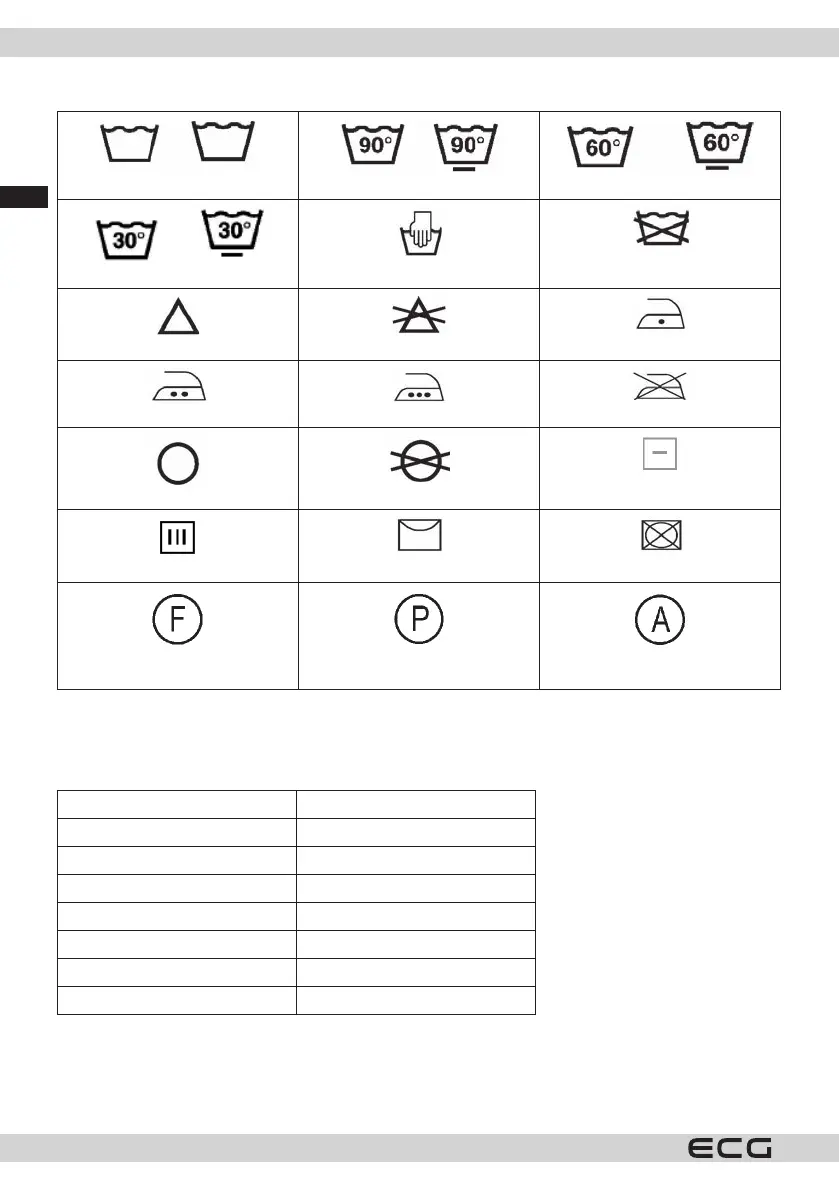
Čeština
Čeština
50
Symboly péče ooděvy
Normální praní Maximální teplota praní je 90 °C
Maximální teplota praní je 60 °C
Maximální teplota praní je 30 °C
Ruční praní
Zákaz praní
Lze bělit
Nebělit
Teplota žehlení je maximálně 110 °C
Teplota žehlení je maximálně 150 °C Teplota žehlení je maximálně 200 °C Nežehlit
Lze chemicky čistit
Zákaz chemického čištění
Rozložte na plocho
Pověsit za mokra
Sušit pověšením Nesušit vbubnové sušičce
Lze čistit benzínem, alkoholem,
atriuortrichloretanem
Lze čistit benzínem,
perchloretylénem
Lze čistit perchlorinetylenem, R11,
R113 abenzínem
POZNÁMKA: Dávejte pozor, abyste nepřekročili maximální náplň bubnu, protože by to vedlo ke špatným
výsledkům praní a ke zmačkání prádla. Informace o kapacitě pračky naleznete v tabulce
pracích programů.
Následující tabulka ukazuje přibližnou hmotnost běžných typů prádla:
TYP PRÁDLA HMOTNOST (g)
Ručník 200
Povlečení 500
Župan 1 200
Přikrývka 700
Povlak na polštář 200
Spodní prádlo 100
Ubrus 250
Upozornění:
• Neperte oděvy, které byly čištěny, prány, namáčeny nebo potírány hořlavými nebo výbušnými látkami,
jako je vosk, olej, barva, benzín, alkohol, petrolej a jiné hořlavé materiály.

Čeština
Čeština
51
• Praní jednotlivých kusů oblečení může snadno způsobit nerovnoměrné zatížení bubnu a vyvolat chybu.
Proto se doporučuje přidat do praní ještě jeden nebo dva kusy prádla, aby odstřeďování proběhlo hladce.
• Neperte, ani neodstřeďujte voděodolné potahy a oblečení nebo rohože či koberce.
Dávkovač pracího prostředku
Prací prostředek na předpírku
Prací prostředek na hlavní praní
Aviváž
Upozornění:
• Při doplňování pracího prostředku nebo aviváže nepřekračujte
značku MAX.
Program Program
Antialergický
Odstřeďování/vypouštění
Bavlna
Máchání/odstřeďování
20 °C
Kojenecké oblečení
Mix
Sportovní
Vlna
Lůžkoviny
Syntetika
Rychlý 45'
ECO 40-60
Rychlý 15'
Samočištění
= povinné; = volitelné
Doporučení pro prací prostředky
Doporučený prací
prostředek
Program praní Teplota praní Typ prádla a textilu
Silný prací prostředek a
bělidla.
Bavlna, ECO 40-60, Mix 20/30/40/60 Bílé prádlo z bavlny
nebo lnu odolného proti
vyvaření.
Prací prostředek na
barevné prádlo bez
bělidel
Bavlna, ECO 40-60, Mix Studená/20/30/40 Barevné prádlo z bavlny
nebo lnu.
Jemný prací prostředek
na barevné prádlo bez
bělidel
Syntetika Studená/20/30/40 Barevné prádlo ze
snadno udržovatelných
vláken nebo
syntetických materiálů.
Jemný prací prostředek Syntetika 20/30 Jemné textilie, hedvábí,
viskóza.
Speciální prací
prostředek na vlnu
Vlna 20/30 Vlna.
Přidání pracího prostředku do pračky
Množství pracího prostředku použitého v pračce závisí na následujících kritériích:
• Pokud je prádlo jen mírně zašpiněné, nepředpírejte ho. Vložte malé množství pracího prostředku do
oddílu II zásuvky na prací prostředky.
• Pokud je prádlo velmi znečištěné, vyberte program s předpírkou a vložte ¼ pracího prostředku do oddílu
I zásuvky na prací prostředek a zbytek do oddílu II.

Čeština
Čeština
52
• V pračce používejte prací prostředky určené pro automatické pračky. Řiďte se pokyny výrobce ohledně
množství pracího prostředku, které se má použít.
• V oblastech s tvrdou vodou je zapotřebí více pracího prostředku.
• Množství potřebného pracího prostředku se zvyšuje s většími dávkami prádla.
• Do prostředního prostoru zásuvky na prací prostředek vložte aviváž.
• Při doplňování pracího prostředku nebo aviváže nepřekračujte rysku MAX.
• Hustá změkčovadla nebo prací prostředky mohou způsobit ucpání zásuvky, proto je zřeďte trochou
vody.
Pokud je pracího prostředku příliš mnoho:
• Při praní vznikne velké množství pěny.
• Prádlo bude špatně vymáchané.
Pokud je množství pracího prostředku nedostatečné:
• Prádlo zešedne.
• Na bubnu, topném tělese a/nebo prádle se bude usazovat vodní kámen.
Ovládací panel
Poznámka: Obrázek je ilustrační.
Kojenecké obleč ení
Máchání/ odstřeďování
Odstřeďování/ vypouštění
Vlna
Eco 40-60
Syntetika
Samočištění
Otáčky
Odstř eďování
Volba
teplo ty
Př ídavná
volba
Start / P auza
Rychlý 15´
Rychlý 45´
Antialergický
Bavlna
Mix
Podržet 3 sek dokud se neozve zvuk/odložený start
20
Lů žkoviny
Sportovní
15
45
1 Pozice „vypnuto“ (OFF) 2 Start/Pauza
Pokud je ovládací kolečko v této poloze, pračka
je vypnutá.
Stisknutím tohoto tlačítka můžete spustit nebo
pozastavit prací cyklus.
3 Doplňkové funkce 4 Program
Slouží pro výběr doplňkové funkce. Po výběru
funkce se toto tlačítko rozsvítí.
Výběr programu praní podle typu prádla.
5 Displej
Na displeji se zobrazují nastavení, odhadovaný zbývající čas, možnosti a stavová hlášení pračky. Displej
zůstane během pracího cyklu zapnutý.
A Displej
Doba praní
Doba odložení spuštění
Konec cyklu Chyba
B Předpírka C Extra máchání
D Dětský zámek E Zámek dveří

Čeština
Čeština
53
Tabulka programů
Program
Náplň (kg) Doba trvání
EWT 70120 EWTI 71120 EWT 70120 EWTI 71120
Antialergický 3,5 3,5 02:27 02:27
Bavlna 7,0 7,0 02:40 02:40
20 °C 3,5 3,5 01:01 01:01
Mix 3,5 3,5 01:20 01:20
Vlna 2,0 2,0 01:07 01:07
Syntetika 3,5 3,5 02:20 02:20
ECO 40-60 7,0 7,0 03:18 03:28
Samočištění - - 01:18 01:18
Odstřeďování/
vypouštění
7,0 7,0 0:12 0:12
Máchání/
odstřeďování
7,0 7,0 0:20 0:20
Kojenecké oblečení 7,0 7,0 02:01 02:01
Sportovní 3,5 3,5 0:45 0:45
Lůžkoviny 2,5 2,5 01:27 01:27
Rychlý 45' 2,0 2,0 0:45 0:45
Rychlý 15' 2,0 2,0 0:15 0:15
EWT 70120
Program
Jmenovitá kapacita
(kg)
Doba trvání
programu (Hod:min)
Spotřeba elektrické
energie kWh/cyklus
Spotřeba vody litrů/
cyklus
Maximální teplota
(°C)
Zbytkový obsah
vlhkosti v (%) 1000
ot. za min.
Rychlý 15 min. 2,0 0:15 0,035 31 Studená 70%/800
20 °C 3,5 1:01 0,213 43 20 65%/1000
Bavlna (60 °C) 7,0 2:45 1,385 65 60 65%/1000
Syntetika 3,5 2:20 0,678 43 40 65%/1000
Mix 7,0 1:20 0,742 65 40 65%/1000
ECO 40-60
7,0 3:18 0,907 52,0 35 62,9%/1200
3,5 2:42 0,622 43,0 32 62,9%/1200
2,0 2:42 0,433 37,0 23 62,9%/1200
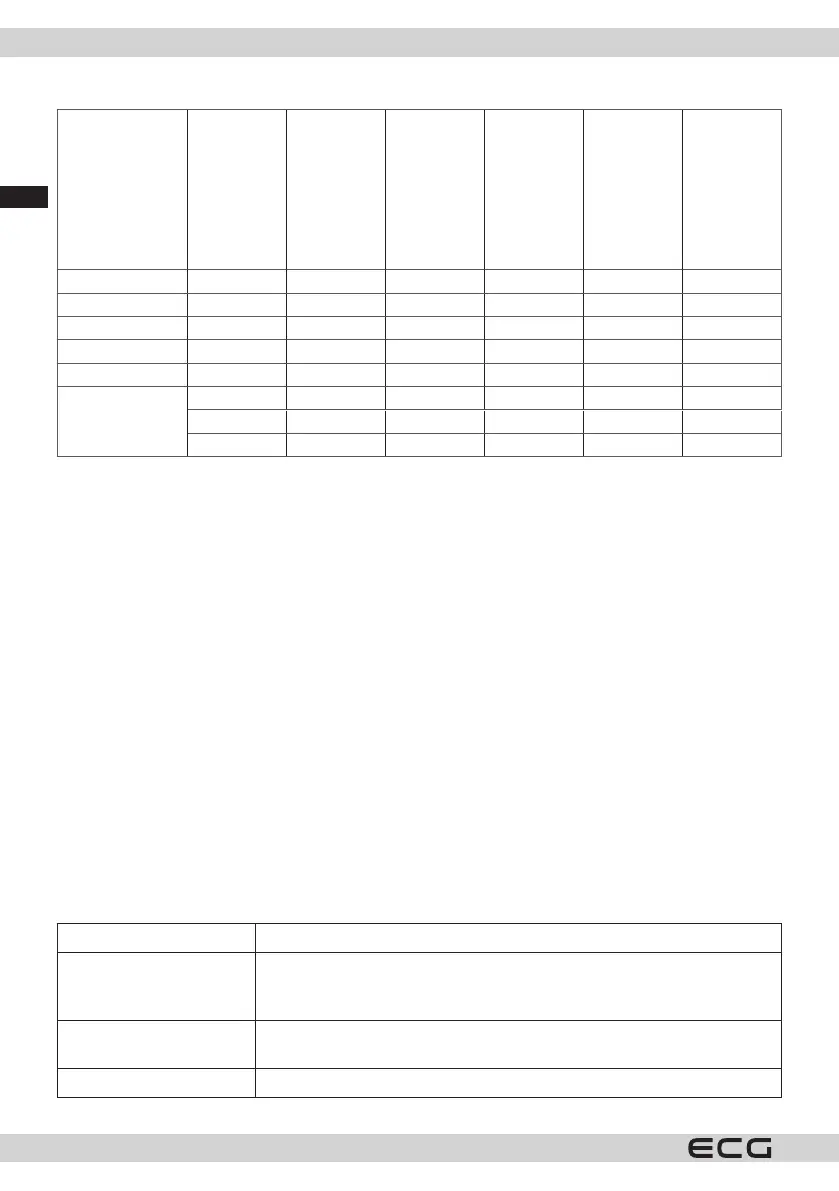
Čeština
Čeština
54
EWTI 71120
Program
Jmenovitá kapacita
(kg)
Doba trvání
programu (Hod:min)
Spotřeba elektrické
energie kWh/cyklus
Spotřeba vody litrů/
cyklus
Maximální teplota
(°C)
Zbytkový obsah
vlhkosti v (%) 1000
ot. za min.
Rychlý 15 min. 2,0 0:15 0,035 31 Studená 70%/800
20 °C 3,5 1:01 0,177 43 20 65%/1000
Bavlna (60 °C) 7,0 2:45 1,289 65 60 65%/1000
Syntetika 3,5 2:20 0,596 43 40 65%/1000
Mix 7,0 1:20 0,696 65 40 65%/1000
ECO 40-60
7,0 3:28 0,953 51,9 42 62,9%/1200
3,5 2:42 0,455 43,6 30 62,9%/1200
2,0 2:42 0,226 38,1 22 62,9%/1200
• Výše uvedené údaje jsou pouze orientační a mohou se měnit v důsledku různých skutečných podmínek
použití.
• Údaje uvedené pro jiné programy než program ECO 40-60 jsou pouze orientační.
• Údaje podle norem EN 60456:2016/prA2019 a (EU)2019/2014, (EU)2019/2023: třída energetické účinnosti
EU je: C (u modelu EWTI 71120), D (u modelu EWT 70120)
• Program energetických testů: ECO 40-60. Ostatní nastavení beze změny.
• Poloviční zatížení pro pračku s kapacitou 7,0 kg: 3,5 kg.
• Čtvrtinové zatížení pro pračku s kapacitou 7,0 kg: 2,0 kg.
• Nejvyšší teplota, které prádlo dosáhne v pracím cyklu po dobu nejméně 5 minut.
• Zbytková vlhkost po pracím cyklu v procentech obsahu vody a otáčky odstřeďování, při kterých bylo této
vlhkosti dosaženo.
• Program ECO 40-60 dokáže vyprat běžně znečištěné bavlněné prádlo, které je deklarováno jako pratelné
na 40 °C nebo 60 °C, společně v jednom pracím cyklu. Tento program slouží k posouzení souladu s
nařízením (EU) 2019/2023.
• Nejúčinnější programy z hlediska spotřeby energie jsou obecně ty, které probíhají při nižších teplotách
a delší době trvání.
• Naplnění pračky pro domácnost až do kapacity uvedené pro příslušné programy přispěje k úspoře
energie a vody.
• Hlučnost a zbytková vlhkost jsou ovlivněny rychlostí odstřeďování. Čím vyšší je rychlost odstřeďování ve
fázi odstřeďování, tím vyšší je hlučnost a nižší zbytková vlhkost.
Popis programů
Program praní vyberte podle typu prádla.
Bavlna Textilie odolné proti opotřebení, tepelně odolné textilie z bavlny nebo lnu.
Syntetika Praní syntetických předmětů, například košil, kabátů, směsí. Při praní
pleteného textilu je třeba snížit množství pracího prostředku, protože se v
něm snadno tvoří pěna a bubliny.
Kojenecké oblečení Při praní kojeneckého oblečení je kladen velký důraz na šetrnou péči, která
nebude dráždit pokožku dítěte.
Rychlý 45' Rychlé praní malého množství nepříliš špinavého oblečení.
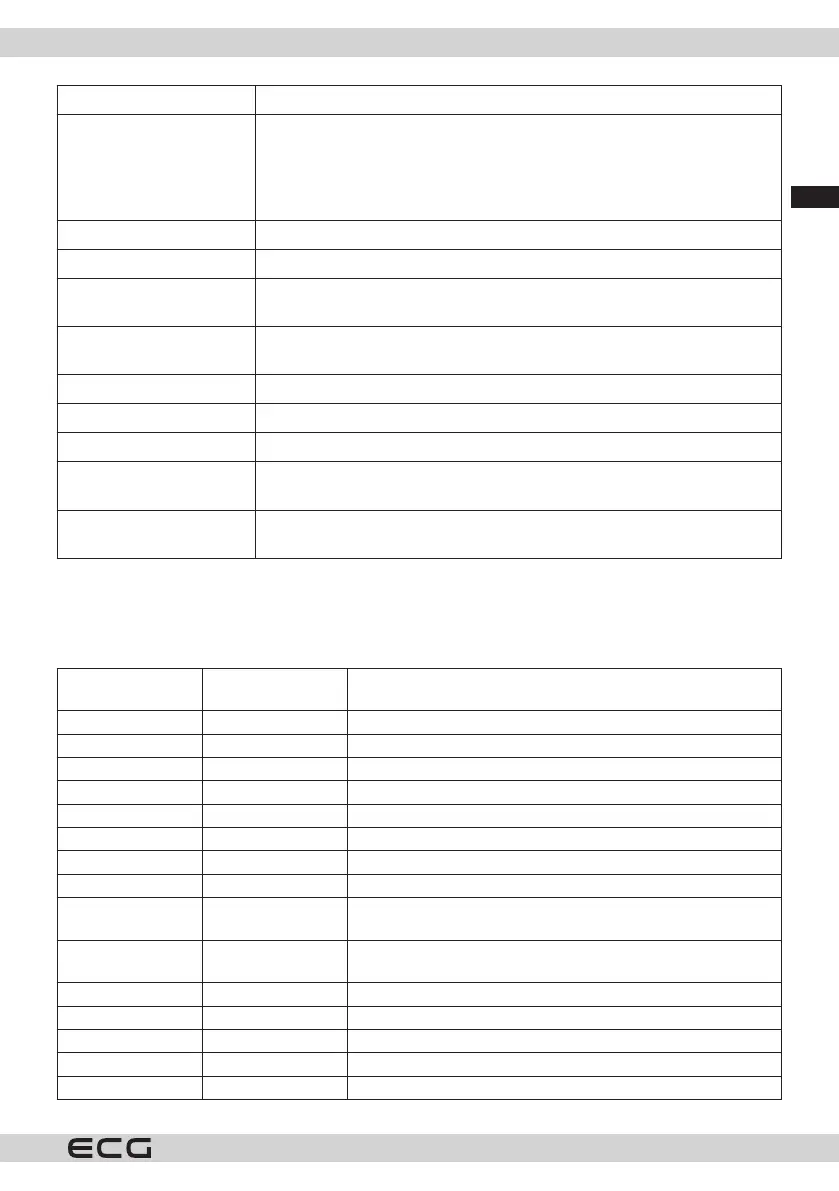
Čeština
Čeština
55
Mix Smíšené prádlo skládající se z textilií vyrobených z bavlny a syntetiky.
Samočištění Pračka je vybavena speciálním programem na automatické čištění bubnu
a trubek. Používá sterilizaci při vysoké teplotě 90 °C, aby bylo praní oděvů
ekologičtější. Při tomto programu nelze přidávat prádlo. Pokud se přidá
správné množství chlorového bělidla, bude čisticí účinek vyšší. Zákazník
může tento program využívat pravidelně podle potřeby.
20 °C Při praní jasně barevného oblečení může lépe chránit barvy.
Rychlý 15' Extra krátký program vhodný pro malé množství lehce znečištěného prádla.
Vlna Vlněné textilie nebo textilie z příměsí vlny, které lze prát v ruce nebo v pračce.
Zvláště šetrný prací program zabraňující srážení, delší pauzy v programu.
Odstřeďování/
vypouštění
Extra odstřeďování s volitelnou rychlostí odstřeďování.
Máchání/odstřeďování Extra máchání s odstřeďováním.
Sportovní Praní sportovního a outdoorového oblečení.
Lůžkoviny Tento program je speciálně navržen pro praní lůžkovin.
Antialergický Důsledné mytí při 70 °C zajišťuje sterilizační účinky. Doporučuje se hmotnost
prádla nižší než 5 kg.
ECO 40-60 Výchozí teplota 40 °C, nelze měnit. Vhodné pro praní prádla při teplotách
přibližně 40 až 60 °C.
Upozornění:
• Dojde-li během provozu stroje k přerušení napájení, uloží se zvolený program do speciální paměti. Po
obnovení napájení bude stroj pokračovat v programu.
Přídavné funkce
Program
Výchozí teplota
(°C)
Dostupné přídavné funkce
Antialergický 70 Odložený start, Extra máchání
Bavlna 40 Odložený start, Extra máchání, Předpírka
20 °C 20 Odložený start, Extra máchání, Předpírka
Mix 40 Odložený start, Extra máchání, Předpírka
Vlna 40 Odložený start, Extra máchání
Syntetika 40 Odložený start, Extra máchání, Předpírka
ECO 40-60 - Odložený start
Samočištění 90 Odložený start
Odstřeďování/
vypouštění
- Odložený start
Máchání/
odstřeďování
- Odložený start, Extra máchání
Kojenecké oblečení 60 Odložený start, Extra máchání, Předpírka
Sportovní 20 Odložený start, Extra máchání, Předpírka
Lůžkoviny 40 Odložený start, Extra máchání
Rychlý 45' 40 Odložený start, Extra máchání
Rychlý 15' Chladné Odložený start
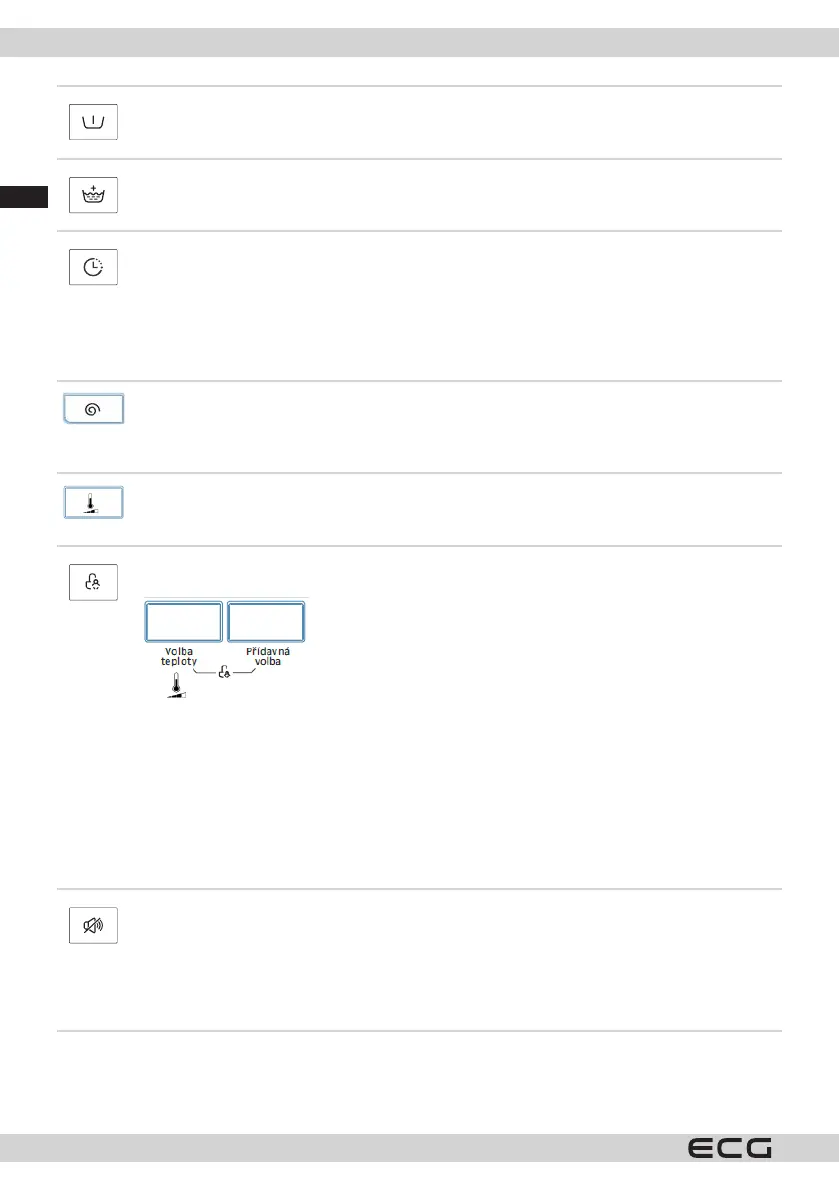
Čeština
Čeština
56
Předpírka
Funkce extra praní před zahájením hlavního pracího cyklu pro zvýšení pracího výkonu.
Poznámka: Do oddílu I je třeba přidat prací prostředek.
Extra máchání
Po zvolení této funkce se prádlo navíc vymáchá.
Odložený start
1. Zvolte program
2. Stisknutím tlačítka [Temp.] na 3 vteřiny zvolte dobu odložení v rozsahu 0–24 h.
3. Stisknutím tlačítka [Start/Pauza] aktivujete odložení.
Chcete-li odložený start zrušit, stiskněte tlačítko [Temp. ] před spuštěním programu, dokud se
na displeji nezobrazí 0 h. Pokud byl program již spuštěn, vypněte spotřebič a poté jej zapněte
a zvolte nový program.
Otáčky
V případě potřeby lze rychlost otáček upravit stisknutím tlačítka Speed v následujících krocích:
Pro pračky s otáčkami 1200 ot/min.: 0-400-600-800-1000-1200
Pro pračky s otáčkami 1300 ot./min.: 0-400-600-800-1000-1200-1300
Teplota
V případě potřeby lze teplotu praní upravit stisknutím tlačítka teploty v následujících krocích:
Studená - 20 °C - 30 °C - 40 °C - 60 °C - 90 °C.
Dětský zámek
Tato funkce má zabránit dětem ve zneužití ovládacích prvků.
Stiskněte současně tlačítka [Volba teploty] a [Přídavná volba] na 3 sekundy, dokud se neozve
zvukový signál. Rozsvítí se kontrolka dětské pojistky.
Po aktivaci dětské pojistky se na displeji střídavě zobrazuje „CL“ a zbývající čas.
Stisknutí jakéhokoli jiného tlačítka způsobí blikání indikátoru dětské pojistky.
Po ukončení programu se na displeji střídavě zobrazují nápisy „CL“ a „END“.
Dětská pojistka deaktivuje funkci všech tlačítek kromě tlačítka zapnutí/vypnutí a tlačítka
dětské pojistky! Dětskou pojistku lze deaktivovat pouze současným stisknutím dvou tlačítek
[Temp.] a [Function]! Před výběrem nového programu deaktivujte dětský zámek!
Ztlumení bzučáku
1. Vyberte požadovaný program.
2. Stiskněte tlačítko [Otáčky/odstřeďování] na 3 sekundy, bzučák se ztlumí.
Funkci bzučáku aktivujete opětovným stisknutím tlačítka na 3 sekundy. Nastavení bude
zachováno až do příštího spuštění.
Pozor! Po ztlumení funkce bzučáku se zvuky automaticky samy nezapnou.

Čeština
Čeština
57
ČISTĚNÍ A ÚDRŽBA
Upozornění:
• Před zahájením údržby odpojte přístroj od sítě a zavřete kohoutek.
Čistění vnějšku pračky
Správná údržba pračky může prodloužit její životnost. V případě potřeby lze povrch čistit zředěnými
neabrazivními neutrálními čisticími prostředky. Pokud dojde k přetečení vody, okamžitě ji otřete vlhkým
hadříkem. Nepoužívejte žádné ostré předměty.
Kyselina mravenčí a její zředěná rozpouštědla nebo ekvivalentní látky, jako je alkohol, rozpouštědla nebo
chemické výrobky, jsou zakázány.
Čištění bubnu
Rez, kterou kovové předměty zanechaly uvnitř bubnu, se okamžitě odstraní pomocí čisticích prostředků bez
chlóru. Nikdy nepoužívejte drátěnku. Nevkládejte prádlo do pračky během čištění bubnu.
Čištění vstupního ltru
• Snižující se průtok vody je známkou toho, že je třeba ltr
vyčistit.
1. Zavřete vodovodní kohoutek a vyjměte z něj přívodní
hadici.
2. Filtr vyčistěte kartáčkem.
3. Odšroubujte přívodní hadici vody ze zadní strany stroje.
Vytáhněte ltr pomocí kleštiček.
4. K vyčistění použijte například zubní kartáček.
5. Znovu namontujte ltr na přívod vody a znovu připojte
přívodní hadici.
6. Pro zajištění normálního provozu spotřebiče čistěte
vstupní ltr každé 3 měsíce.
Čistění dávkovače pracího prostředku
1. Stiskněte místo se šipkou na krytu zásobníku aviváže uvnitř dávkovače pracího prostředku.
2. Zvedněte klip nahoru, vyjměte kryt zásobníku aviváže a omyjte všechny drážky vodou.
3. Vraťte zpět kryt zásobníku aviváže a zasuňte dávkovač zpět.
Upozornění:
• K čištění plastových dílů nepoužívejte abrazivní nebo žíravé prostředky.
• Pro zajištění normálního provozu spotřebiče čistěte dávkovač mycího prostředku každé 3 měsíce.
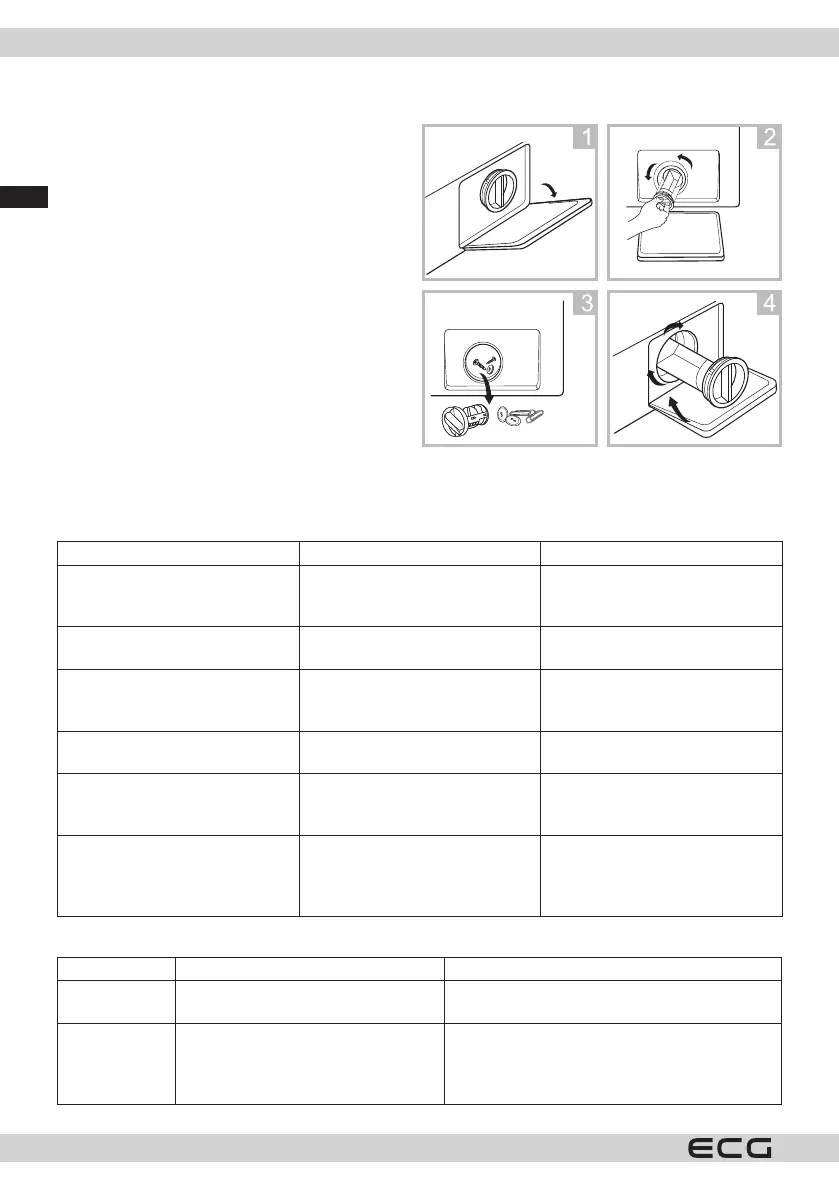
Čeština
Čeština
58
Čištění ltru vypouštěcího čerpadla
Upozornění:
• Ujistěte se, že pračka dokončila prací cyklus a
je prázdná. Před čištěním ltru vypouštěcího
čerpadla pračku vypněte a odpojte ze zásuvky.
• Pozor na horkou vodu. Nechte vodu
vychladnout. Nebezpečí opaření!
• Filtr čistěte pravidelně každé 3 měsíce, aby byl
zajištěn normální provoz spotřebiče.
1. Otevřete spodní krytku.
2. Otevřete ltr otočením proti směru hodinových
ručiček.
3. Odstraňte špínu a cizorodé předměty.
4. Zavřete spodní krytku.
Upozornění:
• Když je spotřebič v provozu a v závislosti na
zvoleném programu může být v čerpadle horká
voda. Nikdy neodstraňujte kryt čerpadla během
pracího cyklu, vždy počkejte, až spotřebič
dokončí cyklus a bude prázdný. Při výměně krytu dbejte na jeho pevné dotažení.
ODSTRAŇOVÁNÍ POTÍŽÍ
Popis Příčina Řešení
Pračku nelze spustit. Dveře nejsou správně zavřené. Spusťte pračku po zavření dveří.
Zkontrolujte, zda prádlo neuvízlo
v bubnu.
Dveře nelze otevřít. Je aktivní bezpečnostní pojistka
pračky.
Odpojte napájení a spusťte
pračku znova.
Únik vody. Spojení mezi přívodním potrubím
nebo výstupní hadicí není těsné.
Zkontrolujte a upevněte
vodovodní potrubí. Vyčistěte
vypouštěcí hadici.
Zbytky pracího prostředku na
prádle nebo v bubnu.
Prací prostředek je příliš hustý. Vyčistěte a otřete dávkovač
pracího prostředku.
Indikátor nebo displej nesvítí. Napájení je odpojeno nebo došlo
k poruše elektroniky.
Zkontrolujte, zda není napájení
vypnuto a zda je správně
připojena zástrčka.
Abnormální hluk. Zkontrolujte, zda byly odstraněny
upevňovací prvky (šrouby).
Pračku instalujte na rovný a pevný
povrch.
Chybová hlášení na displeji
Chybový kód Příčina Řešení
E30 Dveře nejsou správně zavřené Spusťte pračku po zavření dveří. Zkontrolujte,
zda prádlo neuvízlo v bubnu.
E10 Problém se vstřikováním vody. Zkontrolujte, zda není tlak vody příliš nízký.
Narovnejte přívodní hadici.
Zkontrolujte, zda není ucpaný ltr vstupního
ventilu.
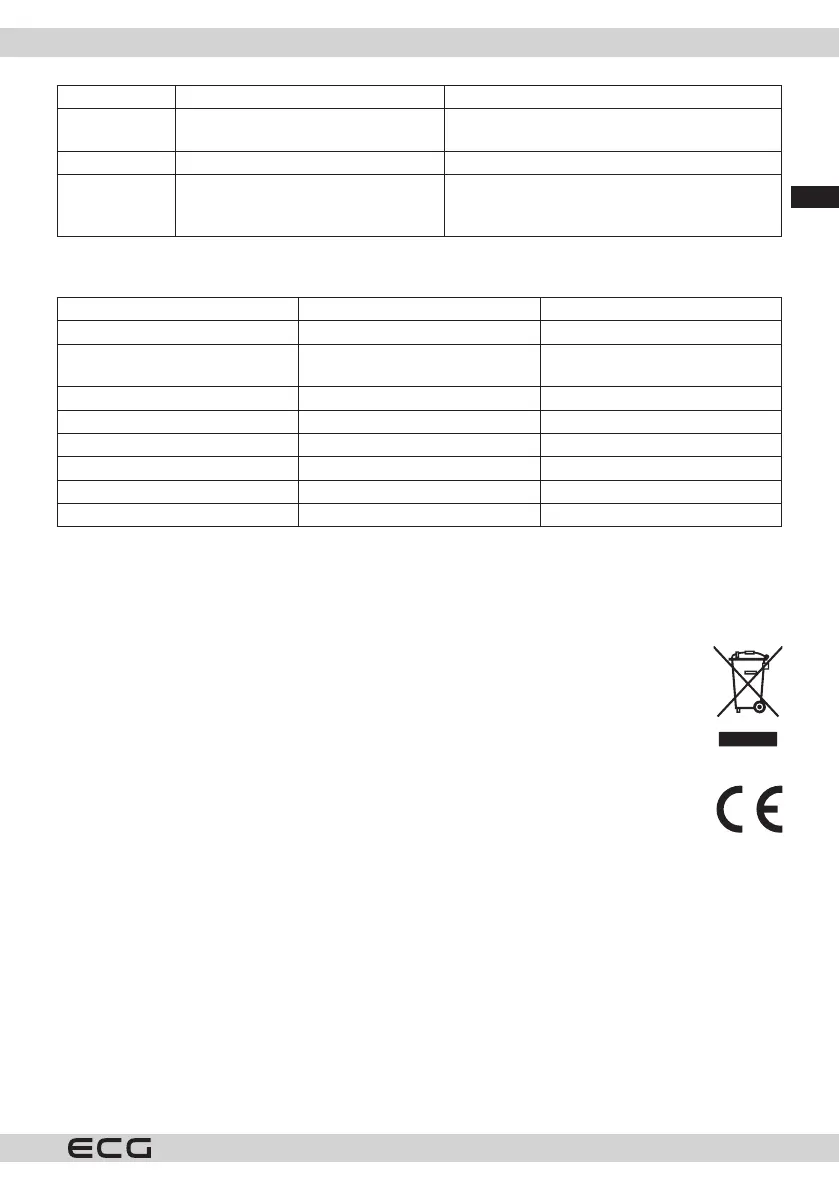
Čeština
Čeština
59
Chybový kód Příčina Řešení
E21 Vypouštění vody trvá příliš dlouho. Zkontrolujte, zda není vypouštěcí hadice
ucpaná.
E12 Přetečení vody. Vypněte pračku a zapněte ji znova.
EXX Ostatní. Zkuste prosím praní opakovat. Pokud budou
potíže přetrvávat, obraťte se na zákaznický
servis.
TECHNICKÉ ÚDAJE
EWT 70120 EWTI 71120
Vestavný spotřebič Ne Ne
Maximální kapacita náplně (suché
prádlo) kg
7 7
Maximální otáčky/min. 1200 1200
Rozměry (V × Š × H) [mm] 875 × 400 × 610 875 × 400 × 610
Jmenovíté napětí 220–240 V ~ 50 Hz 220–240 V ~ 50 Hz
Příkon 2100 W 2000 W
Pojistka 10 A 10 A
Tlak vody (MPA) min./max. 0,1 MPa/ 1 MPa 0,1 MPa/ 1 MPa
VYUŽITÍ ALIKVIDACE ODPADU
Balicí papír a vlnitá lepenka – odevzdat do sběrných surovin. Přebalová folie, PE sáčky, plastové díly – do sběrných
kontejnerů na plasty.
LIKVIDACE VÝROBKU PO UKONČENÍ ŽIVOTNOSTI
Likvidace použitých elektrických a elektronických zařízení (platí v členských zemích EU a dalších
evropských zemích se zavedeným systémem třídění odpadu)
Vyobrazený symbol na produktu nebo na obalu znamená, že sproduktem by nemělo být nakládáno jako
s domovním odpadem. Produkt odevzdejte na místo určené pro recyklaci elektrických a elektronických
zařízení. Správnou likvidací produktu zabráníte negativním vlivům na lidské zdraví a životní prostředí.
Recyklace materiálů přispívá kochraně přírodních zdrojů. Více informací o recyklaci tohoto produktu Vám
poskytne obecní úřad, organizace pro zpracování domovního odpadu nebo prodejní místo, kde jste produkt
zakoupili.
Tento výrobek splňuje požadavky směrnic EU o elektromagnetické kompatibilitě a elektrické
bezpečnosti a problematiky těžkých kovů v elektrických a elektronických zařízeních. Dále pak
splňuje příslušnou energetickou náročnost.
Návod kobsluze je kdispozici na webových stránkách www.ecg-electro.eu.
Změna textu atechnických parametrů vyhrazena.
Kontakt na odborný servis tohoto produktu naleznete v přiloženém Záručním listu nebo na stránkách
www.ecg-electro.eu.
• Záruka na tento výrobek je 24 měsíců.
• Náhradní díly uvedené v EU 2019/2023 jsou k dispozici po dobu 10 let.
• Přístup do databáze produktů, kde jsou uloženy informace k tomuto výrobku dle EU 2019/2014, můžete
získat načtením QR kódu na energetickém štítku.
08/05

Magyar
Magyar
60
FELSŐ TÖLTÉSŰ MOSÓGÉP
BIZTONSÁGI ELŐÍRÁSOK
Olvassa el gyelmesen és a későbbi felhasználásokhoz is őrizze
meg!
Figyelmeztetés! A jelen útmutatóban feltüntetett biztonsági
előírások és utasítások nem tartalmaznak minden olyan feltételt és
körülményt, amely a használat során bekövetkezhet. A felhasználónak
meg kell értenie, hogy egyetlen termékbe sem lehet beépíteni a
felhasználótól elvárható elővigyázatosságot és gondosságot. Ezekről
a készüléket használó és kezelő felhasználóknak kell gondoskodniuk.
Nem vállalunk felelősséget a készülék helytelen használatából, a
hálózati feszültségingadozásokból, vagy a készülék bármilyen jellegű
átalakításából és módosításából eredő károkért.
Tartsa be a jelen útmutatóban leírt utasításokat. A készülék használatba
vétele előtt gyelmesen olvassa el a használati útmutatót, és azt őrizze
meg későbbi felhasználásokhoz is.
A tüzek, áramütések és egyéb sérülések megelőzése érdekében, az
elektromos készülékek használata során tartsa be az általános és az
alábbiakban feltüntetett biztonsági utasításokat is.
1. Győződjön meg arról, hogy a hálózati feszültség értéke
megegyezik-e a készülék típuscímkéjén feltüntetett tápfeszültség
értékével. A biztonságos használat érdekében a csatlakozódugót
csak szabályszerűen leföldelt szabványos aljzathoz csatlakoztassa. A
hálózati ág kivitele és védelme felejen meg a felhasználás országában
érvényes érintésvédelmi előírásoknak és szabványoknak.
2. Ha a készülék hálózati vezetéke sérült, akkor a készüléket használni
tilos. A készülék első bekötését, az elektromos hálózathoz és a
vízvezeték hálózathoz való csatlakoztatását a márkaszerviznél
vagy más szakszerviznél rendelje meg. A hálózati vezetéket csak
márkaszerviz cserélheti ki! A készülék védőburkolatát ne szerelje le,
a feszültség alatt lévő alkatrészek áramütést okozhatnak!
3. A meghibásodott alkatrészeket kizárólag csak eredeti alkatrészekkel
szabad helyettesíteni. A gyártó csak eredeti alkatrészek esetében
garantálja a biztonsági követelmények teljesítését.
FELSŐ TÖLTÉSŰ MOSÓGÉP
Magyar

Magyar
Magyar
61
FELSŐ TÖLTÉSŰ MOSÓGÉP
4. A hálózati aljzat legyen mindig és könnyen elérhető, hogy veszély
esetén a hálózati csatlakozódugót azonnal ki tudja húzni.
5. A szakszerűtlen javítás személyi sérülésekhez vezethet, ezekért a
gyártó nem vállal felelősséget.
6. A készüléken javítást csak márkaszerviz vagy kioktatott és
felhatalmazott szakember hajthat végre.
7. A karbantartáshoz, tisztításhoz vagy javításhoz a mosógép csak
akkor van leválasztva az elektromos hálózatról. ha:
- a hálózati vezeték a fali aljzatból ki van húzva, vagy
- a mosógép hálózati áramkörét védő kismegszakító le van
kapcsolva, vagy
- a biztosító (régi rendszereknél) teljesen ki van csavarozva a
foglalatból.
8. A hálózati csatlakozódugót és a hálózati vezetéket nedves kézzel ne
fogja meg. Ezzel csökkentheti az áramütés kockázatát.
9. A készüléket nedves kézzel és lábbal ne érintse meg.
10. A hálózati csatlakozódugó legyen jól elérhető és hozzáférhető. A
készüléket ne üzemeltesse hosszabbító vezetékről vagy elosztóról.
A hálózati vezeték nem érhet hozzá forró felületekhez, továbbá azt
éles tárgyakra se helyezze rá (a sérült szigetelés áramütést vagy
zárlatot okozhat).
11. A készüléket a hálózati vezeték bedugásával (kihúzásával) ne
kapcsolja be (kapcsolja ki). A csatlakozódugót a vezetéknél fogva ne
húzza ki a fali aljzatból. A művelethez fogja meg a csatlakozódugót.
A használat befejezése után a programválasztó gombot állítsa
kikapcsolva (OFF) állásba, a hálózati csatlakozódugót húzza ki a fali
aljzatból, a vízszelepet zárja el.
12. A mosógépet ne állítsa fel szőnyegre és hasonló anyagokra, a
készülék alján található szellőzőnyílások ilyen anyagokon nem
tudják ellátni a funkciójukat.
13. A készülék nyílásaiba ne dugjon be semmit, a készülékre ne
helyezzen rá tárgyakat (pl. vázát, csészét stb.).
14. A leeresztő tömlő végét ne tegye mosdóba, mosogatóba vagy
vödörbe.

Magyar
Magyar
62
15. Ne engedje, hogy a készülékkel gyerekek játszanak. Ne engedje,
hogy a készüléket gyerekek vagy házi állatok megközelítsék. A 3 év
alatti gyerekeket tartsa távol a készüléktől, felügyelet nélkül
gyerekek nem tartózkodhatnak a készülék közelében.
16. A használati útmutatót tartalmazó zacskóban apró alkatrészek is
találhatók, ezeket gyerekektől elzárva tárolja.
17. A készüléket közvetlen napsütés hatásának ne tegye ki, ne használja
a szabadban és ne tegye ki az időjárás hatásainak.
18. A készülék közelében ne tároljon gyúlékony anyagokat.
19. A mosógépben ne mosson olyan ruhákat, amelyeken gyúlékony
vagy robbanékony anyagok vannak, vagy amelyeket gyúlékony
és robbanékony anyagokban kimosott vagy beáztatott (példák az
ilyen anyagokra: benzin, olaj, festék, zsírtalanító és oldó anyagok,
hígítók, petróleum stb.). A készülékben gyúlékony, robbanékony
vagy toxikus anyagokat használni tilos. Mosószerként benzint vagy
alkoholt használni szigorúan tilos. Ezek az anyagok tüzet vagy
robbanást okozhatnak! A készülékben szőnyeget mosni tilos.
20. A bekapcsolt mosógépet nedves és vizes kézzel ne fogja meg.
A mosógép működése közben a mosószer ókot ne húzza ki, a
mosógép ajtaját pedig ne próbálja meg kinyitni.
21. Gőzölés funkció használata esetén a mosógép ajtaját óvatosan
nyissa ki. A kiáramló gőz, a forró dob vagy az ajtóüveg égési sérülést
okozhat. Az ajtó kinyitása után lépjen hátrébb, és várja meg a gőz
eltávozását.
22. A vízleeresztés közben a leeresztő tömlőt ne fogja meg, a kezét ne
dugja a kifolyó vízsugárba. A mosógépből kifolyó víz forró lehet.
Égési sérüléseket szenvedhet.
23. Bármilyen meghibásodás esetén előbb a csatlakozódugót húzza ki
a fali aljzatból, majd zárja el a vízszelepet. A készüléket ne próbálja
megjavítani saját erőből! Forduljon a márkaszervizhez.
24. Az első használatba vétel előtt, a szállítás közben a DOBOT
RÖGZÍTŐ CSAVAROKAT szerelje ki. Ha a készülék meghibásodását
a dobrögzítő csavarok ki nem szerelése okozta, akkor erre a garancia
nem vonatkozik.

Magyar
Magyar
63
25. A készülék kizárólag csak háztartásokban, textil anyagok mosására
használható. Kereskedelmi, vagy rendeltetéstől eltérő használat
esetén a készülékre adott garancia érvényét veszti.
26. A mosógépet csak beltérben szabad használni.
27. A mosógépet ne telepítse nedves és vizes helyiségekbe, illetve
gyúlékony és robbanékony, vagy maró anyagok közelébe.
28. A készüléket 8 évnél idősebb gyerekek, idős, testi és szellemi
fogyatékos személyek, illetve a készülék használatát nem ismerő
és hasonló készülék üzemeltetéseinek a tapasztalataival nem
rendelkező személyek csak a készülék használati utasítását ismerő
és a készülék használatáért felelősséget vállaló személy felügyelete
mellett használhatják. A készüléket 8 év feletti gyerekek csak felnőtt
személy felügyelete mellett tisztíthatják. A készüléket és a hálózati
vezetékét úgy kell elhelyezni, hogy ahhoz 8 év alatti gyerekek ne
férhessenek hozzá.
29. Idegen személyek a készüléket nem javíthatják, az ilyen
beavatkozások a garancia megszűnését jelentik. A készülék javítását
márkaszervizben rendelje meg.
30. A garancia nem vonatkozik külső hatások (árvíz, vegyi anyagok, tűz
stb.) miatt bekövetkezett hibákra és sérülésekre.
31. A gyártó nem vállal felelősséget a készülék rendeltetésétől eltérő
használat, vagy nem földelt aljzathoz való csatlakoztatás miatt
bekövetkező károkért és sérülésekért. VESZÉLYES FESZÜLTSÉG!
ÁRAMÜTÉS VESZÉLY!
AJÁNLÁS
• Az új automata mosógép telepítését rendelje meg a legközelebbi márkaszerviznél (vagy vízszerelő
szakembernél).
• A mosógépet jól szellőző helyiségbe telepítse. A készüléket úgy helyezze el, hogy az ajtót kényelmesen és
teljesen ki lehessen nyitni. A mosógépet nem lehet bútorba építeni.
• A mosógép optimális üzemeltetési hőmérséklete 15 és 25°C között.
• A megfagyott tömlők megrepedhetnek, felhólyagosodhatnak. Amennyiben a környezeti hőmérséklet
fagypont alá süllyed, akkor a készülék biztonságos működéséhez szükséges feltételek már nem
biztosítottak.
• A telepítés utáni első mosási ciklust ruhák nélkül, a „fehér pamut 90°C”-os program futtatásával hajtsa
végre, a mosószer ók második rekeszébe 1/2 adagolópohár mennyiségű mosószert adagoljon.
• A mosópor vagy az öblögető anyag lerakódhat vagy beszáradhat a mosószer ókba, ezért a mosószereket
mindig csak a mosás megkezdése előtt adagolja a rekeszekbe.
• Az előmosás programot csak erősen szennyezett ruhák mosásához használja.

Magyar
Magyar
64
• A ruha mennyisége ne haladja meg a maximálisan megengedett mennyiséget. Ellenkező esetben a
mosógép vész üzemmódba kapcsol át.
• A mosógépben csak olyan ruhákat mosson, amelyek a gyártó által elhelyezett címke szerint mosógépben
moshatók.
• A mosószerek (mosópor, gél, öblögető stb.) adagolását a mosószer gyártójának az előírásai szerint végezze.
• A ruhák zsebeit mindig ellenőrizze le, mielőtt a ruhákat a mosógépbe tenné, azokban nem lehet semmilyen
idegen tárgy vagy anyag (pl. szeg, tű, öngyűjtő, gyufa, papírzsebkendő, gemkapocs stb.). Az ilyen anyagok
károsíthatják a mosógépet és a mosott ruhát.
• Az erősen poros ruhák is kárt tehetnek a mosógép alkatrészeiben. Az ilyen ruhákat előbb alaposan rázza ki.
• A mosószer adagoló ókot a készülék működése közben ne húzza ki.
• Működés közben az ajtót erőszakkal ne nyissa ki.
• Az ajtó kinyitása előtt ellenőrizze le, hogy a dobban nincs-e víz. Ha víz van a dobban, akkor az ajtót ne
nyissa ki.
• A program befejezése után várjon legalább 2 percet, majd nyissa ki a készülék ajtaját.
• A fehérítő szerekben található kén korróziót okozhat. Ezért a készülékbe fehérítő szereket ne töltsön be. A
mosógépbe oldószereket (pl. műszaki benzint) tartalmazó készítményeket használni tilos.
• Ha a mosógépet hosszabb ideig nem fogja használni, akkor hálózati vezetéket húzza ki a fali aljzatból, a
vízszelepet zárja el és az ajtót is nyissa ki. A mosógép belseje kiszárad és nem lesz szagos.
• A gyártás közben végrehajtott vizsgálatok miatt, a mosógépben kisebb mennyiségű víz maradhat, ez
azonban semmilyen kockázatot sem jelent.
Vízkifolyás veszélye
• A készüléket a mellékelt tömlőkészlettel csatlakoztassa a vízvezeték hálózathoz.
• Ne használjon régi és már használt tömlőt.
• A használat befejezése után a hálózati csatlakozódugót húzza ki a fali aljzatból és a vízszelepet is zárja el.
• A leeresztő tömlő végét ne tegye mosdóba, mosogatóba vagy vödörbe.
Leesés vagy sérülés veszélye
• A mosógépre ne álljon fel és ne üljön rá. A felső lap elrepedhet, Ön pedig leeshet.
• Az ajtónak ne támaszkodjon neki. Az ajtót ne csapja be erővel. Ha az ajtót nem tudja becsukni, akkor
ellenőrizze le a dobban található ruha mennyiségét és behelyezését.
• A telepítés után a tömlőt és a hálózati vezetéket biztonságosan helyezze el. A megbotlás vagy elakadás
sérülést okozhat.
• A mosógépet az oldalára fektetni vagy fejre állítani tilos.
• A kiálló részeknél (mosószer ók, ajtó) megfogva a mosógépet megemelni tilos. A kiálló részek letörhetnek,
sérülést okozhatnak.
• A mosógép mozgatásához két felnőtt személy szükséges.
Gyerekek biztonsága
• A 3 év alatti gyerekeket tartsa távol a készüléktől, felügyelet nélkül gyerekek nem tartózkodhatnak a
készülék közelében. A közelben tartózkodó gyerekeket ne hagyja felügyelet nélkül. A gyerekeket a
mosógépbe bújva súlyos vagy halálos sérülés érheti.
• Működés közben az ajtó üvege és a mosógép felülete forró lehet. A gyerekeket tartsa távol, nehogy
megfogják a forró felületeket.
• A csomagolóanyagokat gyerekektől elzárt helyen tárolja. Fulladásveszély!
• A mosószer lenyelése mérgezést okozhat, a mosószer bőrre vagy szembe kerülése irritációt okozhat. A
mosószereket gyerekektől tartsa távol!

Magyar
Magyar
65
TERMÉK LEÍRÁSA
Ajtó
Mosószer adagoló
Dob
Szivattyú szűrő
Hálózati vezeték
Működtető panel
Leeresztő tömlő
Megjegyzés: A termék ábrázolása csak tájékoztató jellegű, a megvásárolt termék ettől kis mértékben eltérhet.
Tartozékok
• Dugó a dobrögzítő csavar nyílásokba (4 db)
• Vízbevezető tömlő
• Használati útmutató
TELEPÍTÉS
A telepítés helye
Figyelmeztetés!
• A telepítés helye legyen stabil és szilárd.
• Ügyeljen arra, hogy a hálózati vezeték ne kerüljön a mosógép alá.
A készüléket kizárólag csak az alábbi feltételeknek megfelelő helyre telepítse:
• Szilárd, száraz és vízszintes padló.
• Nincs közvetlen napsütés.
• A helyiség szellőztethető.
• A környezeti hőmérséklet nem csökken 5˛C alá.
• A készülék közelében nincsenek bekapcsolt hőforrások (kályha, sütő, tűzhely stb.).
A mosógép kicsomagolása
Figyelmeztetés!
• A csomagolóanyagok (pl. Fóliák, hungarocell stb.) gyerekekre veszélyesek lehetnek.
• Fulladásveszély! A csomagolóanyagokat gyerekektől elzárt helyen tárolja.
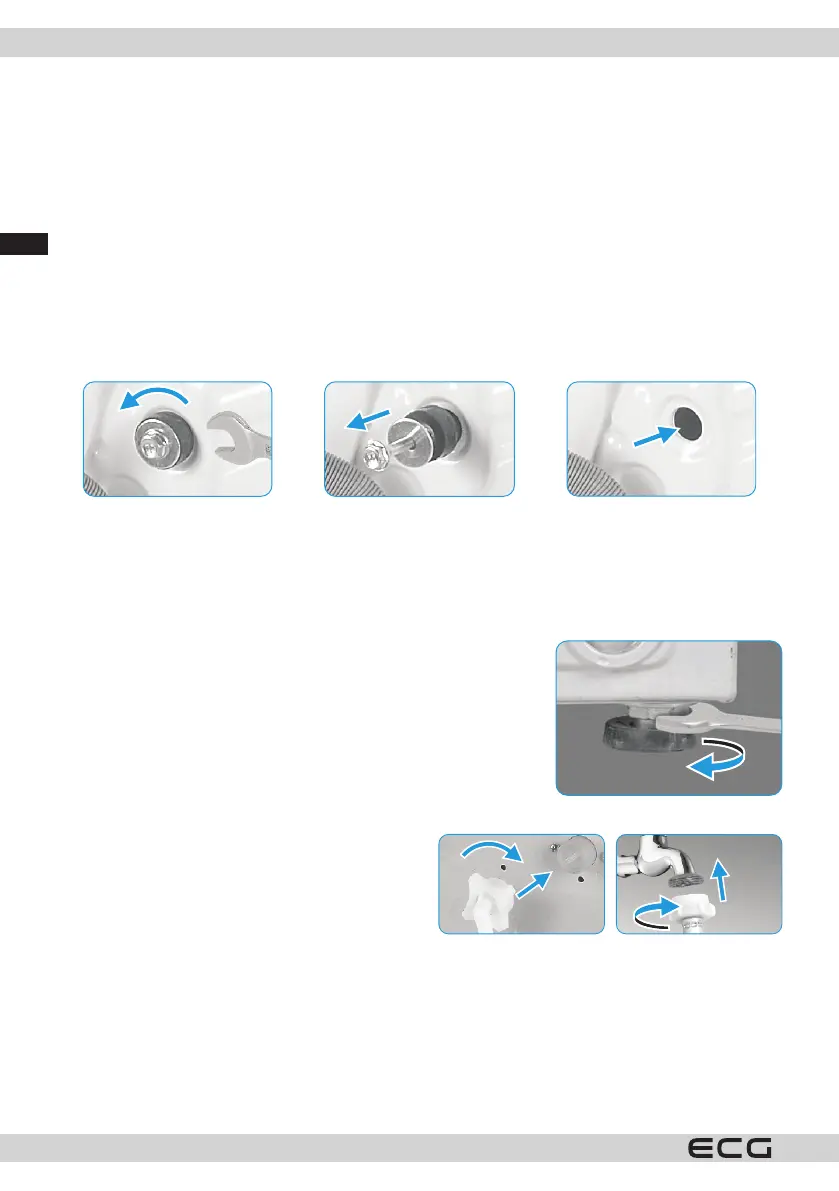
Magyar
Magyar
66
1. Távolítsa el a kartondobozt és a hungarocell csomagolóanyagokat.
2. A mosógépet a csomagolóanyag talpról vegye le. Ügyeljen arra, hogy a mosogatógép alján ne maradjon
rajta a háromszög alakú műanyag hab. Ellenkező esetben a mosógépet fektesse az oldalára, és kézzel
távolítsa el a műanyag hab betétet a készülék aljáról.
3. A hálózati vezetéket és a leeresztő tömlőt rögzítő kötözőszalagot távolítsa el.
4. A dobból vegye ki a vízbevezető tömlőt.
A dobrögzítő csavarok kiszerelése
A készülék üzembe helyezése előtt a hátlapon távolítsa el a 4 db szállító csavart és gumi alátétet. Ha a
csavarokat nem szereli ki, akkor a használat közben a mosógép erősen berezeghet, elmozdulhat a helyéről,
illetve meghibásodhat. Az ilyen meghibásodásokra a garancia nem vonatkozik.
1. A csavarokat megfelelő méretű kulccsal forgassa el az óramutató járásával ellenkező irányba.
2. A dobrögzítő csavarokat vegye ki.
3. A nyílásokba dugja bele a mellékelt műanyag dugókat. A szállító csavarokat őrizze meg (a készülék
szállítása előtt a csavarokat csavarozza vissza a mosógépbe).
A 4 darab dobrögzítő (szállító) csavart kulccsal
csavarozza ki.
A csavarokat a gumi betéttel együtt vegye ki
és őrizze meg későbbi felhasználásokhoz (a
mosógép esetleges szállításához).
A nyílásokba a dugókat szerelje be.
A mosógép vízszintbe állítása
Figyelmeztetés!
• Mindegyik lábnak a padlón kell állnia. A biztosító anyát minden lábon húzza meg.
1. Lazítsa meg a biztosító anyát.
2. Azt a lábat amelyik nem ér hozzá a padlóhoz, csavarozza ki.
3. Vízszint mérő segítségével állítsa be a mosógépet vízzsintes helyzetbe,
majd a lábakon a biztosító anyákat húzza meg. Győződjön meg arról,
hogy a mosógép vízszintes helyzetben és stabilan (billegés nélkül)
áll-e a padlón.
A bemeneti víztömlő csatlakoztatása
Figyelmeztetés!
• A vízszivárgás megelőzése érdekében tartsa be az itt leírtakat.
• A vízbevezető tömlőt ne törje meg, ne tekerje meg
és ne alakítsa át.
A vízbevezető tömlőt csatlakoztassa a fali hideg víz
szelephez (lásd az ábrát). Az anyát jól húzza meg kézzel
(nem szerszámmal). Ellenőrizze le a csatlakozások
megfelelő tömítettségét.
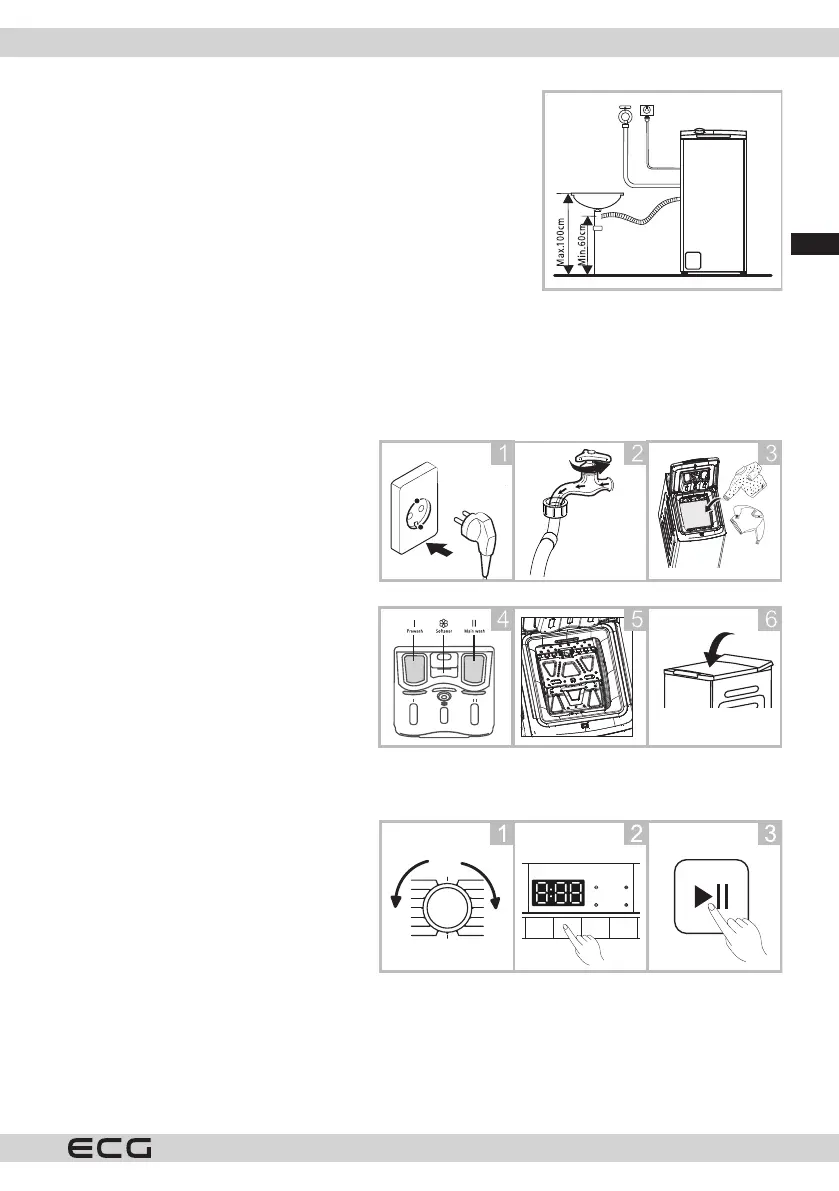
Magyar
Magyar
67
A kifolyó víz bekötése
A szennyvizet elvezető tömlőt csatlakoztassa a mosdó szifon csonkjához.
A kifolyó vizet elvezető tömlőt nem szabad meghosszabbítani. A kifolyó
vizet elvezető tömlő végét ne dugja vödörbe, edénybe, mosdóba
vagy kádba. A kifolyó vizet elvezető tömlő nem lehet megtörve,
megtekeredve vagy összenyomva.
A kifolyó vizet elvezető tömlő vége nem legyen 100 cm-nél magasabban
a padlótól.
HASZNÁLAT
Gyors indítás
Figyelmeztetés!
• Az első használatba vétel előtt ellenőrizze le a készülék helyes telepítését.
• A készüléket a gyártás során ellenőriztük. A gyártásból visszamaradt víz eltávolítása és a kellemetlen
szagok megszüntetése érdekében a mosógépet az első használatba vétel előtt tisztítsa ki. Indítsa el a
Gyapjú 60°C programot ruha nélkül, kis mennyiségű mosószer adagolásával.
A mosás megkezdése előtt
1. Csatlakoztassa a hálózati vezetéket a fali
aljzathoz.
2. Nyissa ki a hideg víz szelepet.
3. A dobba tegye be a mosandó ruhákat.
4. A mosószer adagolóba adagoljon
mosószert.
5. Csukja be a dob ajtaját.
6. Hajtsa le a mosógép ajtaját.
Megjegyzés:
• Az előmosás funkcióval is rendelkező
mosógépek esetében az előmosáshoz az
„I” rekeszbe adagoljon mosószert (lásd
a mosószer adagolásával foglalkozó
fejezetet).
• Ellenőrizze le, hogy a dob ajtó megfelelő
módon be van-e csukva
• Az elülső ajtófél akasztói legyenek beakasztva a hátsó ajtófél nyílásaiba.
• A mosás megkezdése előtt kézzel forgassa meg a dobot, ellenőrizze le, hogy akadálymentesen forog-e.
Mosás
1. Válasszon programot.
2. Válasszon kiegészítő funkciót.
3. Indítsa el a mosást.
Megjegyzés:
• Amennyiben csak az előre beállított
programok közül választott, akkor a 2.
lépést ugorja át.
A program befejezése után
A kijelzőn az „End” felirat jelenik meg.

Magyar
Magyar
68
Minden mosás előtt
• A helyiségben a környezeti hőmérséklet 6 és 40°C között lehet. 0°C alatti hőmérséklet esetén a vízbevezető
tömlőbe vagy a szelepbe a víz befagyhat. Ha a mosógép olyan helyiségben állt, ahol fagy volt, akkor a
mosás megkezdése előtt a mosógépet, a vízbevezető tömlőt stb. fel kell melegíteni (pl. a mosógép
melegebb helyiségbe való átvitelével).
• A ruhákon olvassa el a ruhacímkén található információkat és a ruhákat ezek szerint kezelje és mossa. A
mosógépbe automata mosógépben használható (nem túlságosan habzó) mosószereket töltsön be.
A ruhák előkészítése
Tartsa be a ruha címkén található utasításokat.
A ruhákat anyagaik (pamut, szintetikus, selyem, gyapjú stb.), a mosási hőmérséklet (hideg víz, 30°, 40°, 60°, 90°),
vagy a szennyezettség szerint válogassa szét (enyhén koszos, koszos, erősen koszos).
Ne mosson egyszerre színes és fehér ruhákat.
A sötét színű ruhákból egy ideig festék válhat ki, ezért az új sötét ruhákat önállóan mossa ki.
A ruhák zsebeit ellenőrizze le, azokból a zsebkendőket, fém és egyéb tárgyakat vegye ki.
FIGYELEM! A garancia nem vonatkozik azokra a meghibásodásokra, amelyeket idegen tárgyak okoztak a
mosógépben.
A cipzárakat húzza össze, a kapcsokat nyomja össze, a csatokat csatolja be stb.
Amennyiben a ruha levehető fém kapcsokat, akasztókat tartalmaz (pl. függönyön), akkor ezeket vegye le, vagy
a ruhát mosóhálóba tegye bele.
A ruhákat, nadrágokat, pólókat, pulóvereket, kardigánokat, kabátokat stb. fordítsa ki.
A zoknikat, zsebkendőket és más hasonló kis méretű ruhát mosóhálóban mossa ki.
Ruha ápolási jelek
Normál mosás Maximális mosási hőmérséklet 90 °C
Maximális mosási hőmérséklet 60 °C
Maximális mosási hőmérséklet 30 °C
Kézi mosás
Mosni tilos
Fehéríthető
Ne fehérítse
Maximális vasalási hőmérséklet 110 °C

Magyar
Magyar
69
Maximális vasalási hőmérséklet 150 °C Maximális vasalási hőmérséklet 200 °C Ne vasalja
Vegytisztítás
Vegytisztítás tilos
Laposra terítse szét
Nedves állapotban akassza fel
Akasztva szárítsa Dobos szárítógépben ne szárítsa
Tisztítható benzinnel, alkohollal és
triuor-triklór-etánnal
Tisztítható benzinnel, perklór-etilénnel Tisztítható benzinnel, perklór-
etilénnel, R11 és R113-mal
MEGJEGYZÉS: a dobba ne tegyen be túl sok ruhát (túllépve a maximálisan megengedett mennyiséget), mert
a mosás minősége nem lesz megfelelő, a ruha erősen gyűrött marad stb. A dob kapacitását
(terhelhetőségét) a programtáblázat tartalmazza.
A következő táblázat tartalmazza a ruhák tájékoztató tömegét.
RUHA TÍPUSA TÖMEG (g)
Törülköző 200
Ágynemű 500
Fürdőköpeny 1200
Takaró 700
Párnahuzat 200
Alsónemű 100
Abrosz 250
Figyelmeztetés!
• Ne mosson olyan ruhákat, amelyek korábban benzinben voltak kimosva vagy beáztatva, illetve azon
benzin, hígító- vagy oldószerek, valamint gyúlékony és robbanó anyagok okozta szennyeződés van, mivel
a felszabaduló gőzök tüzet vagy robbanást okozhatnak.
• Ha kevés ruhát tesz a mosógépbe, akkor a dob kiegyensúlyozatlan lesz, amire hibaüzenet is gyelmezteti.
Javasoljuk, hogy tegyen a mosógépbe meg egy-két ruhát, hogy a centrifugálás közben ne legyen
kiegyensúlyozatlanság.
• A mosógépben ne mosson vízálló ponyvákat és ruhákat,
szőnyegeket vagy lábtörlőket.
Mosószer adagoló
Előmosás rekesz
Főmosás rekesz
Öblögetés
Figyelmeztetés!
• A rekeszekbe ne adagoljon a max. jelnél több mosószert.
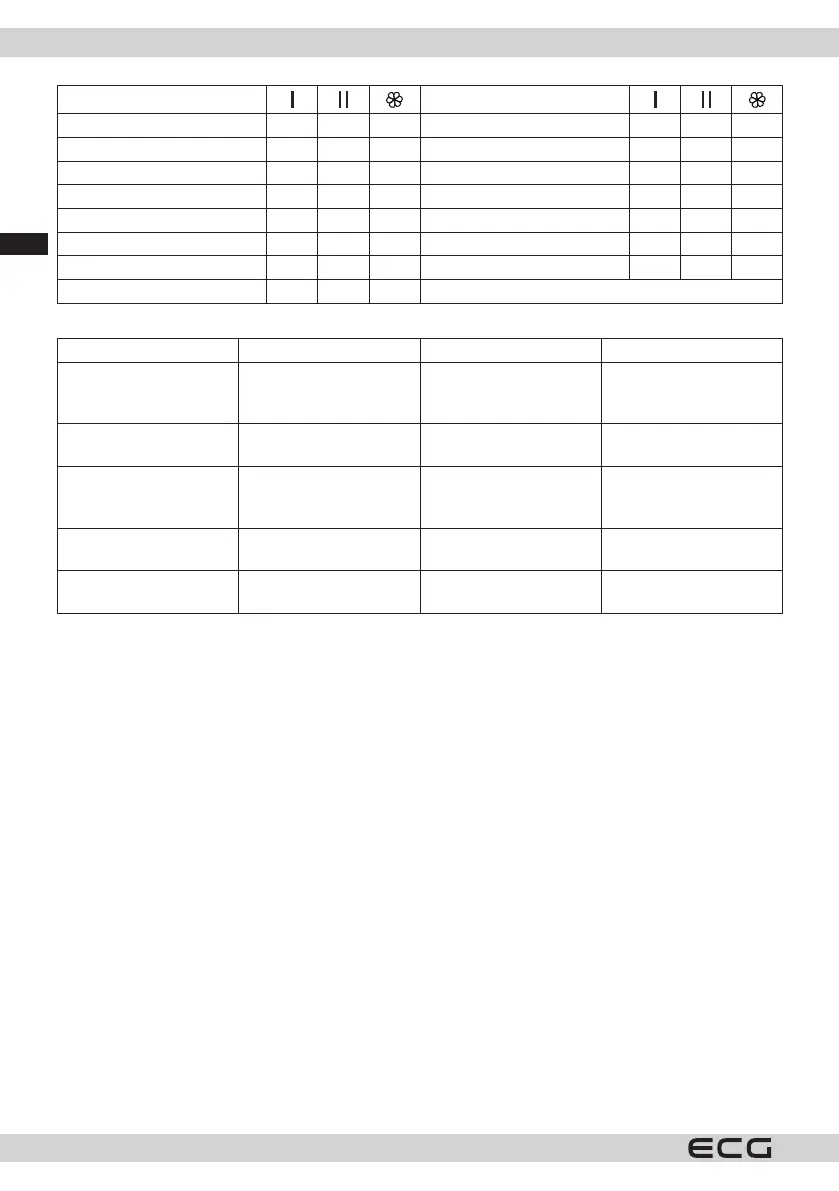
Magyar
Magyar
70
Program Program
Anti-allergiás
Centrifugálás/szivattyúzás
Pamut
Öblítés/centrifugálás
20°C
Csecsemő ruhák
Mix
Sport ruha
Gyapjú
Ágyneműk
Műszál
Gyors 45´
ECO 40-60
Gyors 15´
Öntisztító funkció
= kötelező; = kiválasztható
Mosószer ajánlások
Ajánlott mosószer Mosási program Mosási hőmérséklet Ruha és textília típus
Fehér ruhákhoz ajánlott
mosószer és fehérítő
Pamut, ECO 40-60, Mix 20/30/40/60 Főzésnek is ellenálló,
fehér pamut vagy len
ruha.
Színes ruhákhoz ajánlott
mosószer, fehérítő nélkül.
Pamut, ECO 40-60, Mix Hideg/20/30/40 Színes pamut vagy len
ruha.
Színes ruhákhoz ajánlott
nom mosószer, fehérítő
nélkül.
Műszál Hideg/20/30/40 Színes ruhák, szintetikus
anyagok, könnyen
kezelhető anyagok.
Finom mosószer Műszál 20/30 Finom textília, selyem,
viszkóz.
Speciális gyapjú
mosószer
Gyapjú 20/30 Gyapjú.
Mosószer adagolás
Az adagolt mosószer mennyiségét a következők gyelembe vételével határozza meg.
• Ha a ruha nem koszos, akkor ne használjon előmosást. A mosószer gyártó utasításai szerinti mennyiséget
a II. (főmosás) rekeszbe adagolja.
• Ha a ruha nagyon koszos, akkor olyan programot válasszon, amely előmosást is tartalmaz. A mosószernek
az ¼ részét az előmosás rekeszbe (I), a maradék mosószert a főmosás (II) rekeszbe töltse be.
• A készülékbe kizárólag csak automata mosógépekben való használatra készült mosószereket adagoljon.
Tartsa be a mosószer gyártójának az előírásait az adagolt mennyiséget illetően.
• Ha Önöknél a víz keményebb, akkor adagoljon valamivel több mosószert.
• A ruha mennyiségével arányban növelni kell az adagolt mosószer mennyiségét is.
• A középső rekeszbe öblítő szert adagolhat.
• A rekeszekbe ne adagoljon a max. jelnél több mosószert.
• A sűrű mosószerek vagy mosóporok eltömíthetik a nyílásokat. A sűrű tisztítószerekhez adagoljon kis
mennyiségű vizet is.
Ha túl sok a mosószer:
• Mosás közben sok hab képződik.
• A ruha rosszul lesz kiöblítve.
Ha túl kevés a mosószer:
• A ruha gyorsabban öregszik, szürke lesz.
• A dobon, a fűtőtesten stb. vízkő rakódik le.
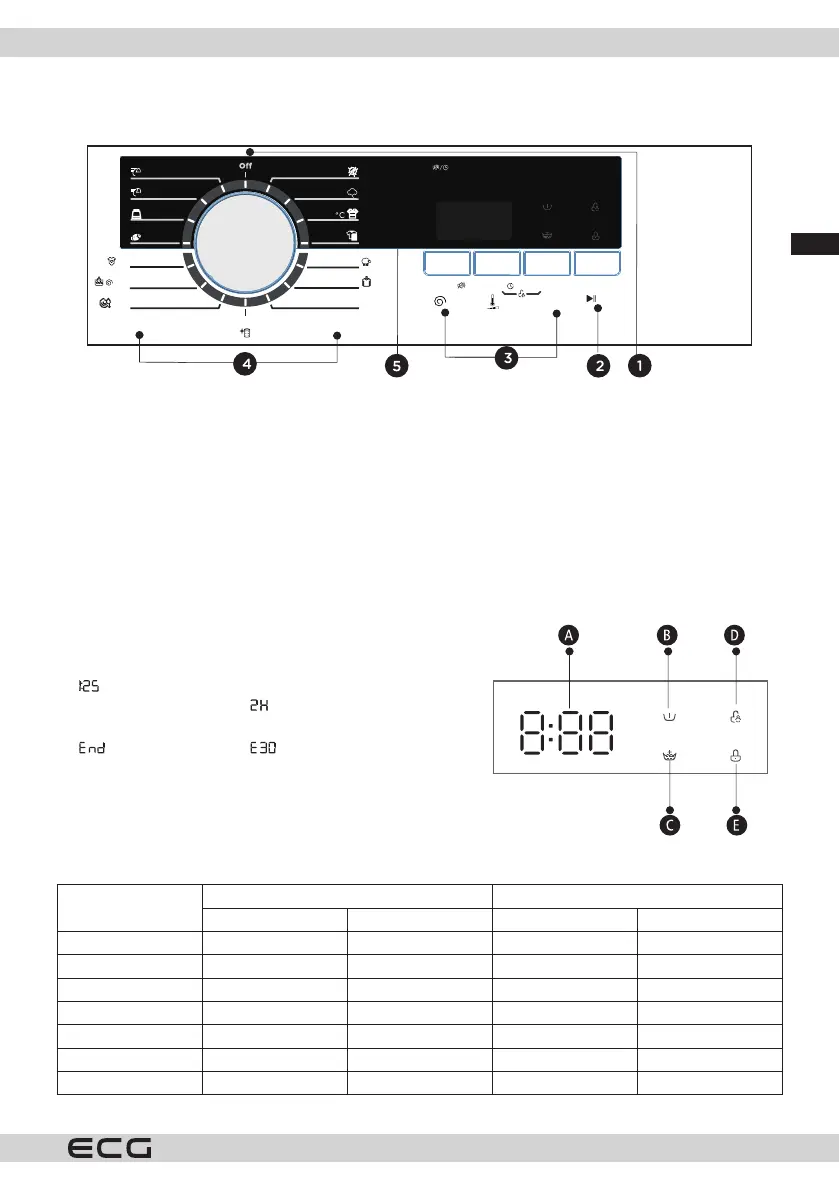
Magyar
Magyar
71
Működtető panel
Megjegyzés: Az ábra csak tájékoztató jellegű.
Kojenecké obleč ení
Máchání/ odstřeď ování
Odstřeďování/ vypouštění
Vlna
Eco 40-60
Syntetika
Samočištění
Otáčky
Odstřeďován í
Volba
teploty
Př ídavná
volba
Start / P auza
Rychlý 15´
Rychlý 45´
Antialergický
Bavlna
Mix
Podržet 3 sek dokud se neozve zvuk/odložený start
20
Lů žkoviny
Sportovní
15
45
1 OFF (kikapcsolva) állás 2 Start/Szünet
Ha a gomb ebben a helyzetben áll, akkor a
mosógép ki van kapcsolva.
A gomb megnyomásával lehet indítani vagy
szüneteltetni a programot.
3 Kiegészítő funkciók 4 Program
A kiegészítő funkciók kiválasztását szolgálja.
A kiválasztott kiegészítő funkció gombjának a
világítása bekapcsol.
Ruha típusok szerinti mosóprogramok.
5 Kijelző
A kijelző mutatja a beállításokat, a program futásából még hátramaradt (becsült) időt és a mosógép
állapot üzeneteit. A kijelző a mosás közben nem kapcsol ki.
A Kijelző
A mosás időtartama
A késleltetett indítás
időtartama
Ciklus vége Hiba
B Előmosás C Kiegészítő öblítés
D Gyerekzár E Ajtózár
Programtáblázat
Program
Töltet (kg) Időtartam
EWT 70120 EWTI 71120 EWT 70120 EWTI 71120
Anti-allergiás 3,5 3,5 02:27 02:27
Pamut 7,0 7,0 02:40 02:40
20°C 3,5 3,5 01:01 01:01
Mix 3,5 3,5 01:20 01:20
Gyapjú 2,0 2,0 01:07 01:07
Műszál 3,5 3,5 02:20 02:20
ECO 40-60 7,0 7,0 03:18 03:28
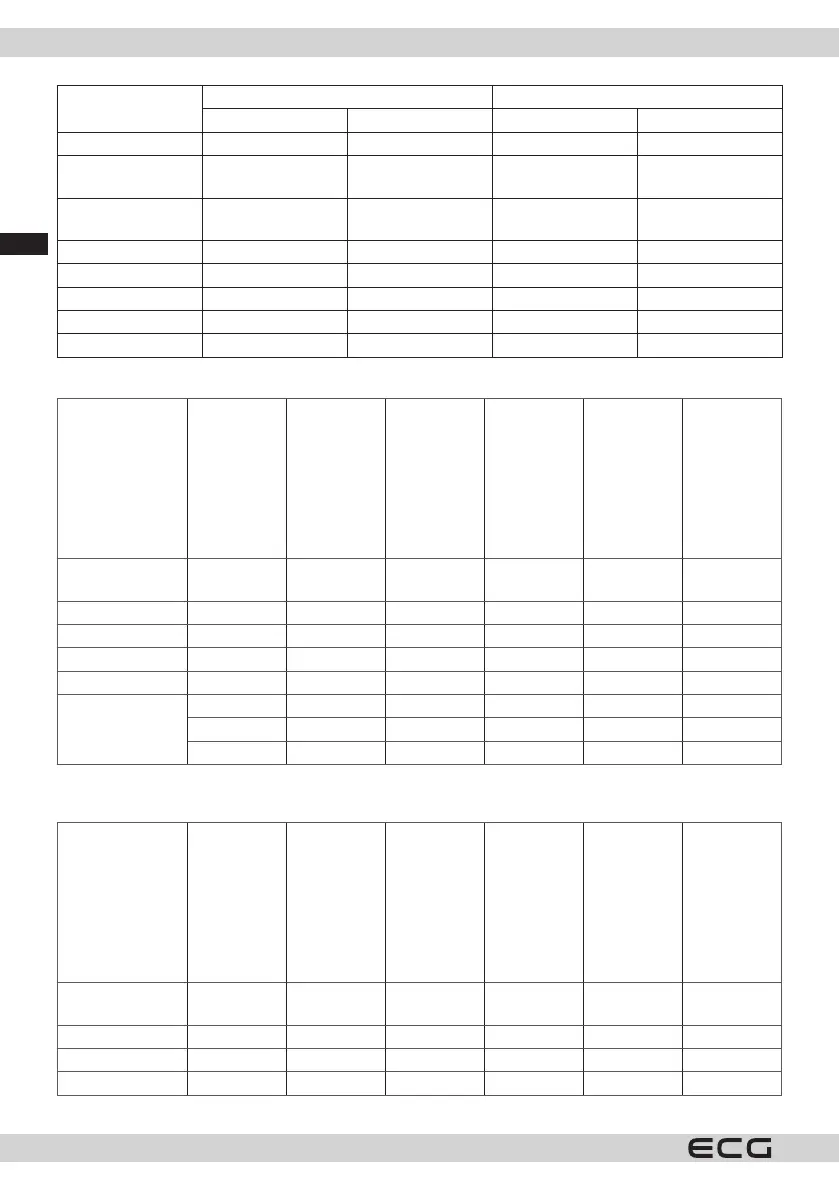
Magyar
Magyar
72
Program
Töltet (kg) Időtartam
EWT 70120 EWTI 71120 EWT 70120 EWTI 71120
Öntisztító funkció - - 01:18 01:18
Centrifugálás /
szivattyúzás
7,0 7,0 0:12 0:12
Öblítés /
centrifugálás
7,0 7,0 0:20 0:20
Csecsemő ruhák 7,0 7,0 02:01 02:01
Sport ruha 3,5 3,5 0:45 0:45
Ágyneműk 2,5 2,5 01:27 01:27
Gyors 45´ 2,0 2,0 0:45 0:45
Gyors 15´ 2,0 2,0 0:15 0:15
EWT 70120
Program
Névleges kapacitás
(kg)
Program hossza
(óra:perc)
Elektromos energia
fogyasztás (kWh/
ciklus)
Vízfogyasztás (liter/
ciklus)
Maximális
hőmérséklet (°C)
Ruhában maradó
nedvesség (%), 1000
f/p centrifugálásnál
Gyors mosás 15
perc
2,0 0:15 0,035 31 Hideg 70% / 800
20°C 3,5 01:01 0,213 43 20 65% / 1000
Pamut (60 °C) 7,0 02:45 1,385 65 60 65% / 1000
Műszál 3,5 02:20 0,678 43 40 65% / 1000
Mix 7,0 1:20 0,742 65 40 65% / 1000
ECO 40-60
7,0 03:18 0,907 52,0 35 62,9% / 1200
3,5 02:42 0,622 43,0 32 62,9% / 1200
2,0 02:42 0,433 37,0 23 62,9% / 1200
EWTI 71120
Program
Névleges kapacitás
(kg)
Program hossza
(óra:perc)
Elektromos energia
fogyasztás (kWh/
ciklus)
Vízfogyasztás (liter/
ciklus)
Maximális
hőmérséklet (°C)
Ruhában maradó
nedvesség (%), 1000
f/p centrifugálásnál
Gyors mosás 15
perc
2,0 0:15 0,035 31 Hideg 70% / 800
20°C 3,5 1:01 0,177 43 20 65% / 1000
Pamut (60 °C) 7,0 02:45 1,289 65 60 65% / 1000
Műszál 3,5 02:20 0,596 43 40 65% / 1000
Produktspecifikationer
| Varumärke: | ECG |
| Kategori: | tvättmaskin |
| Modell: | EWTI 71120 |
| Färg på produkten: | Grijs |
| Bredd: | 106 mm |
| Höjd: | 235 mm |
| Husmaterial: | Aluminium |
| Antal lampor: | 2 gloeilamp(en) |
| Strömlampa: | 25 W |
| Internationell säkerhetskod (IP): | IP54 |
| Monteringsmetod: | Opbouw |
| Typ av strömkälla: | AC |
| Form: | Rechthoek |
| Antal per paket: | 1 stuk(s) |
| Längd: | 81 mm |
| Beslag/fottyp: | GU10 |
| Lämplig för utomhusbruk: | Ja |
| skyddsklass: | I |
| Omgivningstemperatur (min): | -20 °C |
| Omgivningstemperatur (max): | 50 °C |
| Typ av glas: | Opaal |
| Lampa(r) ingår: | Nee |
| Lämplig plats: | Garden, Universal |
| AC-ingångsspänning: | 220 - 240 V |
Behöver du hjälp?
Om du behöver hjälp med ECG EWTI 71120 ställ en fråga nedan och andra användare kommer att svara dig
tvättmaskin ECG Manualer

9 Juli 2025

8 December 2024

25 September 2024

20 September 2024

20 September 2024

20 September 2024

20 September 2024

20 September 2024

23 Augusti 2024

22 Augusti 2024
tvättmaskin Manualer
- Mio Star
- Sôlt
- Tesla
- Mestic
- Kluge
- Waltham
- Euromaid
- Edgestar
- GE
- Aldi
- Sauber
- Sharp
- Dishlex
- Kelvinator
- Magic Chef
Nyaste tvättmaskin Manualer

23 Oktober 2025
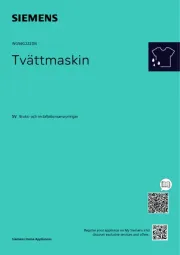
23 Oktober 2025
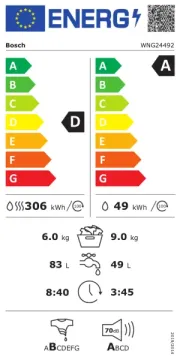
21 Oktober 2025
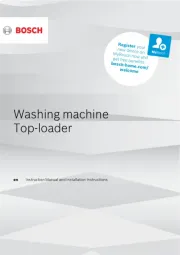
21 Oktober 2025

20 Oktober 2025
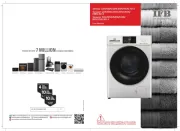
20 Oktober 2025
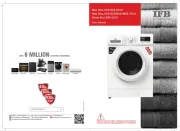
20 Oktober 2025
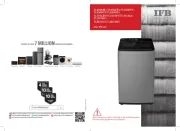
20 Oktober 2025
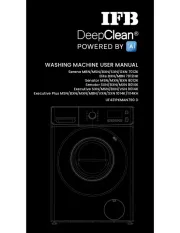
20 Oktober 2025
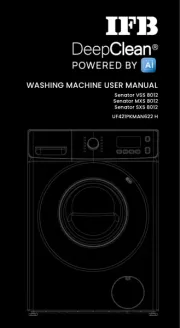
20 Oktober 2025